- Credit cards
- View all credit cards
- Banking guide
- Loans guide
- Insurance guide
- Personal finance
- View all personal finance
- Small business
- Small business guide
- View all taxes

You’re our first priority. Every time.
We believe everyone should be able to make financial decisions with confidence. And while our site doesn’t feature every company or financial product available on the market, we’re proud that the guidance we offer, the information we provide and the tools we create are objective, independent, straightforward — and free.
So how do we make money? Our partners compensate us. This may influence which products we review and write about (and where those products appear on the site), but it in no way affects our recommendations or advice, which are grounded in thousands of hours of research. Our partners cannot pay us to guarantee favorable reviews of their products or services. Here is a list of our partners .
Do You Need a Chip-and-PIN Credit Card Abroad? Probably Not Anymore
Many or all of the products featured here are from our partners who compensate us. This influences which products we write about and where and how the product appears on a page. However, this does not influence our evaluations. Our opinions are our own. Here is a list of our partners and here's how we make money .
If you're planning to travel abroad, you may already know to use a credit card without foreign transaction fees , but you might also have heard you need a card with "chip-and-PIN" capabilities. That's no longer necessarily true, although it used to be.
To understand why, and what changed, it helps to know some background about chip-enabled credit cards:
In the U.S., "chip-and-signature" is the typical process: Virtually all credit cards today come with an embedded microchip, and after you dip or tap the card at a payment terminal that reads the chip, you might be asked to sign your name (though even signature requirements are going away ).
Outside the U.S., chip-and-PIN is more common: You dip the card at a point-of-sale device and are often then asked to type in a personal identification number.
So what if you're traveling internationally with a card that doesn't have chip-and-PIN capability? The short answer: It was once a bigger problem, but now you're much less likely to encounter it because many payment terminals abroad have been updated to accept both kinds of cards.
» MORE: 10 things to remember for your first international trip
It's all about the EMV chip
The little metal square you see on your credit card is an EMV computer chip (named for Europay, Mastercard and Visa, the companies that developed the technology).
EMV chips were designed to make credit card transactions more secure by preventing thieves from stealing your information — aka " skimming " — when you swipe the magnetic stripe on the back of your card.
EMV chips can:
Carry your account information.
Create a cryptogram for each transaction.
Use the encrypted information to verify that the transaction is valid.

Why aren't chip cards the same in the U.S. and abroad?
EMV-enabled chip cards were launched in 1994, although they didn't come to the United States until much later. But even initially, there were two types:
Chip-and-PIN, which required a personal identification number to verify the transaction.
Chip-and-signature, which depended on a cashier comparing your signature at the register to the one on the back of the card.
(Magnetic-stripe cards with no EMV chips at all were still being produced at the time, as well.)
"Chip-and-signature [verification] by itself provides little to no account takeover protection," says Robert Siciliano, CEO of Safr.me, which educates consumers about fraud prevention and personal security. "Chip-and-PIN is more secure since no one can use it without that PIN code, the same way that a debit card can't be used for a transaction without the PIN."
Unlike European banks, which made chip-and-PIN their new standard, the U.S. opted for "chip and choice," meaning the issuing banks could choose for themselves whether they wanted to add a PIN requirement for an additional layer of security or use the cardholder's signature, says Randy Vanderhoof, director of the U.S. Payments Forum, which represents the payment industry.
The majority of U.S. banks ultimately settled on using chip-and-signature, since verifying a cardholder signature at the point of sale was already being done. This also meant that a business that accepted credit cards didn't have to make any costly upgrades to accept chip payments, since the new cards also kept the magnetic stripe intact.
» MORE: What the (almost) end of credit card signatures means for you
Chip cards start to catch on
U.S. issuers rejected the use of EMV for years, mainly because card fraud in the United States had been lower than in the rest of the world.
But in October 2015, a policy change was mandated by the U.S. divisions of the Visa and Mastercard payment networks, creating a powerful financial incentive for chip cards to become the dominant technology. The networks agreed that the liability for credit card fraud would now be the responsibility of any merchant that didn't upgrade its payment terminals to chip cards. This "liability shift" also applied to card issuers that were still making magnetic-stripe-only cards and not including chips in them.
The shift meant that a mom-and-pop store that didn't invest in a chip reader would be on the hook for any purchases made in their store using a counterfeit card. Previously, the payment networks themselves were generally responsible.
"Brands have the power to define certain rules. By mandating that chargebacks go to the least compliant party in EMV acceptance, [Visa and Mastercard] were able to ... get the market on one platform," says Brian Riley, director of the credit advisory service for Mercator Advisory Group.
So do I need a chip-and-PIN card if I'm traveling abroad?
Probably not.
It was good advice when the two different types of chip cards first came on the market. Payment terminals in parts of the world that adopted chip-and-PIN initially didn't recognize chip-and-signature cards and would ask cardholders to enter their PIN to complete their transaction. If you were at an unmanned terminal — say, at a train or bus station — you were out of luck if you tried to use a chip-and-signature card.
But once the U.S. began to widely adopt EMV technology, the global brands that control the specifications in payment terminals worldwide made changes, enabling cards without PIN technology to be recognized and therefore for transactions to be completed.
"A large majority of those unattended kiosks have been updated," Vanderhoof says. "Out of the United States, the terminals should be able to tell that a PIN wasn't issued on your card."
It's more important, he says, to notify your issuing bank that you're traveling and plan to use the card abroad to avoid triggering a suspicious activity alert that could temporarily prevent you from using your card.
And, of course, it may not hurt to carry a little cash on you when you travel internationally, just in case you do find yourself in a situation where a card won't work.
» MORE: 9 credit card tips to take with you overseas
On a similar note...
Find the right credit card for you.
Whether you want to pay less interest or earn more rewards, the right card's out there. Just answer a few questions and we'll narrow the search for you.

2023’s Best Chip-and-PIN Credit Cards
Brendan Harkness
Brendan has been writing about personal finance for over eight years. He makes sure that he covers the most important financial topics transparently and precisely, and that we have up-to-date information to meet your financial needs.
Traveling internationally? Much of the world (outside of the U.S.) uses PINs to verify credit card transactions – rather than the signatures we’re used to here in the states.
So you may want to pick up a card with chip-and-PIN capability, in addition to the basic chip-and-signature you’ll find with most cards. Although more card terminals around the world are gradually accepting signatures, it could be wise to have a PIN card while traveling. This could help you avoid situations where your card isn’t accepted at the point of sale – which could happen, particularly at unattended kiosks like train station ticket vendors.
Credit Card Issuers That Offer Chip-and-PIN Cards
Andrews federal credit union, bank of america, citi/citibank, diners club international, first tech federal credit union, navy federal credit union (nfcu), pentagon federal credit union (penfed), state department federal credit union (sdfcu), store credit cards, united nations federal credit union (unfcu), wells fargo, getting a chip-and-pin card in the usa.
If you’re traveling outside the U.S., particularly in Canada or Europe, it’s useful to have a credit card with chip-and-PIN EMV (Europay, Mastercard and Visa) technology.
The EMV microchip is in addition to the magnetic stripe on the back. Every EMV chip credit card issued in the U.S. has the chip-and-signature verification method, but only cards from certain issuers also have chip-and-PIN.
EMV technology in general (signature or PIN) provides better security against credit card fraud than the traditional magnetic stripe card. PINs are also harder to forge than signatures, making them more secure in some ways – but only for PIN transactions, of course.
Many merchants and checkout terminals outside the U.S. will take chip-and-signature cards. Although you might find a card reader that only accepts PIN cards. You might also opt for a card that defaults to the PIN verification mode to speed up checkout, because that’s what merchants outside the U.S. are generally familiar with.
When making transactions, most cards with both signature and PIN capability will default to signature for the verification method – these are called signature-preferred or signature-priority cards. But a few issuers provide cards that default to PIN to verify the transaction – they’re called PIN-preferred or PIN-priority cards.
Many credit card issuers now offer cards with chip-and-PIN technology for international travel with a few notable exceptions which offer chip and signature versions.
- American Express
- Capital One
This isn’t a very big deal for American Express and Discover, because those cards don’t have very wide acceptance outside the U.S. anyway. So they probably wouldn’t be your first choices for traveling abroad.
But it’s quite unfortunate that Capital One and Chase don’t offer chip-and-PIN with its cards. Chase has some much-loved travel cards that would be even better with PINs, like the Chase Sapphire Preferred® Card and Chase Sapphire Reserve®, along with quite a few airline and hotel co-branded cards.
For trips outside the U.S., check out the cards below and our picks for the best travel credit cards. Many of the top issuers of travel cards now offer PIN capability.
Card issuers take PIN security seriously. Some won’t let you see it through their online banking portals or mobile apps and will only mail it to you. They may also require you to call customer support to set or change your credit card PIN. Others are a bit less secure and will let you change it online.
Insider tip
Do people give you odd looks when you say “PIN number”? That may be because PIN stands for “Personal Identification Number,” and you’re repeating yourself – but we won’t tell if you do!
Travel Tips If You Don’t Have a PIN Card
What if you can’t get a PIN card before you leave? Don’t despair. You should be fine in most cases, as many terminals will accept signature cards. But keep these tips in mind to help your trip run smoothly:
- Carry a backup or two: Carry one or two additional cards in case a terminal has a problem with your card or doesn’t accept the credit card network. Consider carrying some cash and a debit card for emergency ATM withdrawals, too.
- Don’t pay extra: Try to use cards with 0% foreign transaction fees when traveling in other countries or making purchases in foreign currency.
- Communicate with your issuer: In most cases, you should tell your credit card company when and where you’ll be traveling – so it doesn’t report suspicious activity once you start making purchases abroad and place a freeze on your credit card account.
- Prepare for automated points of sale and kiosks: Try to buy things like transit passes ahead of time to avoid dealing with automated kiosks and terminals. If you run into an automated terminal, try looking for an attendant or using a debit card.
- Try pushing “enter” or “cancel”: If you’re using a signature card but the terminal asks for a PIN, try selecting one of these options without entering anything else. Some travelers say this works – occasionally. If it doesn’t work, look for an attendant, try a debit card or go with cash.
- Use mobile wallets: Add your cards to Apple Pay, Google Pay or other mobile wallets for contactless transactions, which are fairly common in some parts of the world. You’ll find many terminals accept these near-field communication (NFC) transactions, giving you a robust payment method whether your cards have PINs or not.
Credit Card Issuers That Provide Chip-and-PIN Cards
The following issuers provide cards with chip-and-PIN functionality. Some are signature-preferred for the verification method, while others are PIN-preferred.
We’ve highlighted some of the best travel cards from each issuer (some issuers don’t offer good travel cards, so we show whatever they might have). These cards may offer rewards and valuable perks in addition to being PIN-capable. Many of them have no foreign transaction fees as well, which is what you’ll want for traveling outside the U.S.
You’ll need to join Andrews FCU to apply for its credit cards. Certain people will be eligible to join , such as those who live or work in Washington, D.C.
Or you can become a member of the American Consumer Council for free with promo code “Andrews”. This will let you join the Andrews FCU, which requires a minimum $5 deposit in a bank account.
Credit cards from Andrews FCU are available as PIN-priority if you request it specifically. We heard from a reader who requested a PIN-priority card, which Andrews supposedly provided, only to find it was signature-priority after traveling to the U.K. But we’ve also heard from other readers who say you can get PIN-priority cards if you make it clear that this is what you want.
So we recommend testing your card to make sure it’s PIN-priority before traveling abroad. If you find that your card is signature-priority, you can request a new PIN-priority card from customer support.
To set or change your PIN, call 1-888-886-0083.
There are a few cards from Andrews FCU that would be good for traveling because they have no foreign transaction fees:
- Titanium Rewards Visa Signature® Credit Card
- Platinum Rewards Visa® Credit Card
- Simplicity Visa® Credit Card
Bank of America credit cards come with chip-and-PIN capability, but they are signature-preferred for the verification method.
You can set or change your PIN online. Just log in, go to your account settings and select “Create or Change PIN.” Or you can choose to have your PIN sent by mail.
There are several travel cards from BofA worth noting, at least one of which doesn’t have foreign transaction fees:
- Bank of America® Travel Rewards Credit Card
- Bank of America® Premium Rewards® Credit Card
- Alaska Airlines Visa Signature® Credit Card
- Business Advantage Travel Rewards World Mastercard® Credit Card
All Barclays credit cards come with chip-and-PIN capability. They are signature-preferred for the verification method.
You’ll be prompted to create a PIN when you open an account online. Otherwise, you can have one assigned to you.
To activate your PIN, use the card at a regular chip-and-Signature checkout terminal. Then you’ll be able to use the PIN function.
You can change your PIN by logging in, going to Account Settings and then selecting “Manage Your PIN.” If you ever change your PIN, you’ll need to activate it again by using the card for a chip-and-Signature purchase.
There are several Barclays cards that have no foreign transaction fees, making them good for travel. Here are a few:
- Uber Visa Card
- Hawaiian Airlines® World Elite Mastercard®
- JetBlue Business Mastercard®
- JetBlue Plus Card
Citi credit cards come with both chip-and-Signature and chip-and-PIN capability. They’re signature-preferred for the verification method.
Your PIN for purchases with Citi cards will be the same as your cash advance PIN.
There are three options for setting or adjusting your PIN:
- Change existing PIN: Call 1-866-696-5673 and listen for instructions to change your PIN. (This number may or may not work for you. If it doesn’t work, call the number on the back of the card.)
- Send a new pre-assigned PIN: Have a new PIN sent to your mailing address.
- Cancel PIN and do not replace it: Remove the PIN from your card entirely.
Citi offers quite a few credit cards that would be useful for traveling because they have no foreign transaction fees. Here are a few:
- Citi Premier® Credit Card
- CitiBusiness® / AAdvantage® Platinum Select® Mastercard® Credit Card
- Citi® / AAdvantage® Platinum Select® World Elite Mastercard® Credit Card
- Citi® / AAdvantage® Executive World Elite Mastercard® Credit Card
Diners Club International is not currently accepting applications online, but you may receive an invitation in the mail to apply.
Diners Club credit cards have both signature and PIN capability and are PIN-priority.
You’ll be issued a PIN when you get your Diners Club card. Call 1-800-234-6377 if you need to reset your PIN. You’ll then be directed to visit a chip-enabled ATM within a specified time period to choose a new one. Diners Club recommends you visit a BMO Harris ATM.
There are several Diners Club credit cards, but unfortunately, the first two below have foreign transaction fees, so they’re not as good for spending outside the U.S.
- Diners Club Card Premier
- Diners Club Card Elite
- Carte Blanche Card
The First Tech Federal Credit Union offers chip cards that come with chip-and-PIN capability. But they’re PIN-priority.
Your PIN will be assigned when you’re approved for a card. It will be mailed to you separately from the card for security purposes.
To join First Tech, you’ll need to meet the membership eligibility requirements . You’ll be eligible if you work for the state of Oregon, for example, or if you’re a member of the Financial Fitness Association ($8 membership fee).
To use a First Tech credit card, you’ll need to open a bank account with them. All of their cards feature no foreign transaction fee, so they’re good choices to bring with you outside the country:
- First Tech Odyssey Rewards™ World Elite Mastercard®
- Choice Rewards World Mastercard®
- Platinum Rewards Mastercard®
- Platinum Secured Mastercard®
HSBC credit cards come with chip-and-PIN capability. We were originally told by HSBC that their cards are set as signature-preferred for the verification method. But on subsequent calls to HSBC, we were told (after long hold times) that they’re PIN-preferred and other conflicting information. If you have any information about what HSBC actually offers, please contact us.
One reader reported that HSBC cards are signature-priority and are sometimes declined if a store terminal (in Europe) only accepts PIN transactions. But the cards do default to PIN for automated kiosks.
Your PIN for purchases will be different from your cash advance PIN. If you want to change your PIN, you’ll need to call customer support. You can’t do it online.
Every HSBC card has no foreign transaction fee, so they’re all relatively good for traveling. Here are some of their better cards, including a couple designed specifically for travelers:
- HSBC Cash Rewards Credit Card
- HSBC Premier Credit Card
- HSBC Elite Credit Card
The Pentagon Federal Credit Union (PenFed) issues cards with chip-and-PIN capability. They’re set as signature-preferred for the verification method.
You’ll receive a PIN when you’re approved for your card. To have a new PIN reissued, call 1-800-247-5626 (Visa cardholders) or 1-800-732-8268 (American Express cardholders).
To open a PenFed credit card, you’ll need to become a member of PenFed. PenFed is federally insured by the National Credit Union Administration (NCUA).
PenFed offers several cards without foreign transaction fees, which you might find useful for traveling abroad:
- PenFed Platinum Rewards Visa Signature® Card
- PenFed Power Cash Rewards Visa Signature® Card
The Navy Federal Credit Union (NFCU) issues chip cards with chip-and-PIN capability. The verification method is signature-priority.
Your card won’t come with a PIN initially, but you can set one for it. To set a PIN, log in to your online account or call 1-888-842-6328. After setting a PIN, test your card at a chip-enabled reader to ensure the update was processed.
NFCU membership is basically limited to members of the military, Department of Defense employees, employees of some related organizations and their families.
None of their credit cards have foreign transaction fees, so they’re all potentially good picks for spending outside the country. Here are some of their more rewarding cards:
- cashRewards Credit Card
- GO REWARDS® Credit Card
- Visa Signature® Flagship Rewards
- Navy Federal More Rewards American Express® Credit Card
The State Department Federal Credit Union (SDFCU) offers cards that are chip-and-PIN capable.
By default, their cards will use signature as the preferred verification mode. But when you’re approved for a card, you opt for PIN-priority by selecting the option that says you’ll be “frequently traveling or living overseas.”
To change an existing PIN on credit cards, call 1-703-706-5000 or 1-800-296-8882. The PIN for purchases is the same as the PIN for cash advances.
SDFCU membership is open to U.S. Department of State employees, employees of certain affiliated organizers and members of their families. You can also join the American Consumer Council for an $8 fee if you want to become an SFCU member.
SDFCU issues three credit cards, and none of them have foreign transaction fees:
- Premium Cash Back+® Credit Card
- Visa® Platinum Rewards Credit Card
- Savings (Share) Secured Platinum Rewards Credit Card
There’s at least one store credit card that features chip-and-PIN capability. This card is actually PIN-priority as well.
- Target REDcard™ Credit Card
The United Nations Federal Credit Union (UNFCU) provides cards with chip-and-PIN capability. The verification method is PIN-preferred.
According to UNFCU, it was actually the first card issuer in the U.S. to offer chip-and-PIN credit cards, back in 2010.
Employees of the United Nations are eligible to join the UNFCU , along with their family members and some other individuals. If you don’t meet the criteria, you can join the United Nations Association of the United States of America (UNA-USA) for $25. Then you’ll be eligible to join the UNFCU.
You’ll receive a PIN when you’re approved for your card.
UNFCU offers two different credit cards, but only one has no foreign transaction fee:
- Elite Credit Card
- Azure Credit Card
USAA provides credit cards for military members and their families. Cardholders can request cards with chip-and-PIN capability, although many USAA members have reported problems using the PIN function outside the U.S.
Cards issued by USAA are signature-priority for the verification method. To reset your PIN, call 1-800-531-8722.
USAA credit cards don’t have foreign transaction fees. Here are a few of their best:
- USAA Rewards™ American Express® Credit Card
- USAA Rewards™ Visa® Signature Credit Card
- Cashback Rewards Plus American Express® Credit Card
- Preferred Cash Rewards Visa® Signature Credit Card
Wells Fargo provides credit cards with chip-and-PIN capability. The verification method is signature-priority.
Call customer support to check or reset your PIN.
Wells Fargo offers a fairly extensive selection of credit cards that cater to a variety of spending habits. There are several Wells Fargo business cards that don’t charge fees for purchases abroad.
- Wells Fargo Business Platinum Credit Card
- Wells Fargo Business Elite Signature Card
When you visit MoneyTips, we want you to know that you can trust what’s in front of you. We are an authoritative source of accurate and relevant financial guidance. When MoneyTips content contains a link to partner or sponsor affiliated content, we’ll clearly indicate where that happens. Any opinions, analyses, reviews or recommendations expressed in our content are of the author alone, and have not been reviewed, approved or otherwise endorsed by the advertiser.
We make every effort to provide up-to-date information; however, we do not guarantee the accuracy of the information presented. Consumers should verify terms and conditions with the institution providing the products. Some articles may contain sponsored content, content about affiliated entities or content about clients in the network. While reasonable efforts are made to maintain accurate information, the information is presented without warranty.
Frequently Asked Questions
If my card has a chip, is it pin-enabled.
No, not necessarily. Every EMV chip credit card issued in the U.S. has the chip-and-signature verification method, but only cards from certain issuers also have chip-and-PIN.
What credit card issuers offer chip-and-PIN cards?
Bank of America, Citi, Wells Fargo, HSBC and Barclays all offer chip-and-PIN credit cards.
You can see a larger list of issuers who offer chip-and-PIN cards, and those who don’t, right here.
What’s the best chip-and-PIN credit card?
There are plenty of chip-and-PIN cards to choose from, for every kind of spending. Here are few cards for your consideration:
- Wells Fargo Active Cash® Card for general rewards
- Target REDcard™ Credit Card for a store card
Check out the credit card issuers who provide chip-and-PIN cards and browse the cards they offer.
Do you need a PIN card before traveling?
Not necessarily. Many payment terminals will accept signature cards, but here are a few tips to follow just in case:
- Carry a backup or two: Carry one or two additional cards in case a terminal has a problem with your card or doesn’t accept the credit card network. Consider carrying some cash and a debit card for emergency ATM withdrawals.
Communicate with your issuer: In most cases, you should tell your credit card company when and where you’ll be traveling – so it doesn’t report suspicious activity once you start making purchases abroad and place a freeze on your credit card account. Credit Card Issuers That Offer Chip-and-PIN Cards
If you’re traveling outside the U.S., particularly in Canada or Europe, it’s useful to have a credit card with chip-and-PIN EMV technology.
EMV technology in general (signature or PIN) provides better security against credit card fraud than the traditional magnetic stripe card. PINs are harder to forge than signatures, making them more secure in some ways, but only for PIN transactions of course.
Although many merchants and checkout terminals outside the U.S. will take chip-and-signature cards, in some cases you might find a card reader that only accepts PIN cards . Or, you may want a card that defaults to the PIN verification mode to speed up checkout, because that’s what merchants outside the U.S. are generally familiar with.
Most cards that have both signature and PIN capability will default to signature for the verification method when making transactions — these are called signature-preferred or signature-priority cards. But there are a few issuers that provide cards which default to PIN to verify the transaction — they’re called PIN-preferred or PIN-priority cards.
Many credit card issuers now offer cards with chip-and-PIN technology, with three notable exceptions.
These issuers do not provide chip-and-PIN cards:
But it’s quite unfortunate that Chase doesn’t offer chip-and-PIN with its cards. It has some much-loved travel cards that would be even better with PINs, like the Chase Sapphire Preferred® Card and Chase Sapphire Reserve®, along with quite a few airline and hotel co-branded cards.
Card issuers take PIN security pretty seriously. Some won’t let you see it through their online banking portals or their mobile apps, and will only mail it to you. They may require you to call customer support to set or change your credit card PIN. Others are a bit less secure, and will let you change it online.
Do people give you odd looks when you say “PIN number”? That may be because PIN stands for “Personal Identification Number,” and you’re repeating yourself — but we won’t tell if you do!
What if you can’t get a PIN card before you leave? Don’t despair, all hope is not lost. You should be fine in most cases, as many terminals will accept signature cards, but keep these tips in the back of your mind to help your trip run smoothly:
- Don’t pay extra: Try to use cards with 0% foreign transaction fees when traveling in foreign countries or making purchases in foreign currency.
- Communicate with your issuer: In most cases you should tell your credit card company when and where you’ll be traveling so it doesn’t report suspicious activity once you start making purchases abroad, and place a freeze on your credit card account.
- Prepare for automated points of sale and kiosks: Although you might not be able to avoid them altogether, try to buy things like transit passes ahead of time to avoid dealing with automated kiosks and terminals. If you run into an automated terminal try looking for an attendant you can pay, or use a debit card.
- Try pushing “enter” or “cancel”: If you’re using a signature card but the terminal asks for a PIN, try selecting one of these options without entering anything. Some travelers report that this works occasionally. If that doesn’t work, look for an attendant or try a debit card (or go with cash).
- Use mobile wallets: Add your cards to Apple Pay, Google Pay, or other mobile wallets for contactless transactions, which are fairly common in some parts of the world. You’ll find many terminals accept these NFC transactions, giving you a robust payment method whether your cards have PINs or not.
The following issuers provide cards with chip-and-PIN functionality. Some of them are signature-preferred for the verification method, while others are PIN-preferred.
You’ll need to join Andrews FCU to apply for its credit cards. Certain people will be eligible to join , such as if you live or work in Washington, D.C.
Or, you can become a member of the American Consumer Council for free with promo code “Andrews”. This will let you join the Andrews FCU, which requires a minimum $5 deposit in a bank account.
Credit cards from Andrews FCU are available as PIN-priority if you request it specifically. We heard from a reader who requested a PIN-priority card, which Andrews supposedly provided, only to find that it was signature-priority after traveling to the U.K. But we’ve also heard from other readers who say you can get PIN-priority cards if you make it clear that this is what you want.
To set or change your PIN, call 1-888-886-0083 .
- Andrews Federal Visa® Titanium Signature Credit Card
- Andrews Federal Platinum Rewards Visa® Credit Card
- Andrews Federal Visa® Simplicity
Bank of America credit cards come with chip-and-PIN capability, but are signature-preferred for the verification method.
You can set or change your PIN online. Just log in, go to your account settings, and select “Create or Change PIN.” Or you can choose to have your PIN sent by mail.
There are several travel cards from BofA worth noting, that don’t have foreign transaction fees:
- Bank of America® Business Advantage Travel Rewards World Mastercard® credit card
Barclays credit cards all come with chip-and-PIN capability. They are signature-preferred for the verification method.
You’ll be prompted to create a PIN when you open an account online. Otherwise you can have one assigned to you.
You can change your PIN by logging in, going to Account Settings, and then selecting “Manage Your PIN.” If you ever change your PIN, you’ll need to activate it again by using the card for a chip-and-Signature purchase.
- Barclaycard Arrival Plus® World Elite Mastercard®
- Uber Credit Card
- Hawaiian Airlines® Bank of Hawaii World Elite Mastercard®
- Change existing PIN: Call 1-866-696-5673 and listen for instructions to change your PIN (this number may or may not work for you; if it doesn’t work, call the number on the back of the card)
- Send a new pre-assigned PIN: Have a new PIN sent to your mailing address.
Diners Club credit cards have both signature and PIN capability and are PIN-priority .
You’ll be issued a PIN when you get your Diners Club card. Call 1-800-234-6377 if you need to reset your PIN. You’ll then be directed to visit a chip-enabled ATM within a specified time period to choose a new one. Diners Club recommends you visit a BMO Harris ATM.
There are several Diners Club credit cards, but unfortunately, the first two below have foreign transaction fees, so they’re not as good for spending outside the U.S.:
The First Tech Federal Credit Union offers chip cards that come with chip-and-PIN capability, and they are PIN-priority .
To join First Tech you’ll need to meet the membership eligibility requirements . You’ll be eligible if you work for the state of Oregon, for example, or if you’re a member of the Financial Fitness Association ($8 per year).
To use a First Tech credit card you’ll need to open a bank account with them. All of their cards feature no foreign transaction fee, so they’re good choices to bring with you outside the country:
- Odyssey Rewards
- Choice Rewards
- Platinum Rewards
- Platinum Secured
HSBC credit cards come with chip-and-PIN capability. We were originally told by HSBC that their cards are set as signature-preferred for the verification method, but on subsequent calls to HSBC we were told (after lots of long hold times) that they’re PIN-preferred and other conflicting information. If you have any information about what HSBC actually offers please contact us.
One reader has reported that HSBC cards are signature-priority, and are sometimes declined if a store terminal (in Europe) only accepts PIN transactions. But the cards do default to PIN for automated kiosks.
Your PIN for purchases will be different than your cash advance PIN. If you want to change your PIN you’ll need to call customer support, you can’t do it online.
- HSBC Cash Rewards Mastercard® credit card
- HSBC Premier World Mastercard® Credit Card
- HSBC Premier World Elite Mastercard® Credit Card
To open a PenFed credit card you’ll need to become a member of PenFed. PenFed is federally insured by NCUA.
The Navy Federal Credit Union (NFCU) issues chip cards with chip-and-PIN capability. They are signature-priority for the verification method.
Your card won’t come with a PIN initially, but you can set one for it. To set a PIN, log in to your online account and select the correct option, or call 1-888-842-6328 . After setting a PIN, test your card at a chip-enabled reader to ensure that the update was processed.
NFCU membership is basically limited to members of the military, Department of Defense employees, employees of some related organizations, and their families.
- Navy Federal Visa Cashrewards Card
- NFCU GO REWARDS® Credit Card
- NFCU Visa Signature® Flagship Rewards
By default, their cards will use signature as the preferred verification mode. But you can select PIN-priority when you’re approved for a card, by selecting the option that says you’ll be “frequently traveling or living overseas.”
To change an existing PIN on credit cards, call 1-703-706-5000 or 1-800-296-8882 . The PIN for purchases is the same as the PIN for cash advances.
SDFCU membership is open to U.S. Department of State employees, employees of certain affiliated organizers, and members of their families. You can also join the American Consumer Council for an $8 fee if you want to become an SFCU member. (You can join the ACC for free using promo code “Andrews”, but that’s technically for members of a different credit union.)
- SDFCU Premium Cash Back+
- SDFCU Visa Platinum Credit Card
- SDFCU Savings Secured Visa Platinum Card
The United Nations Federal Credit Union (UNFCU) provides cards with chip-and-PIN capability. The verification method is PIN-preferred .
Employees of the United Nations are eligible to join the UNFCU , along with members of their families and some other individuals. If you don’t meet the criteria, you can join the United Nations Association of the United States of America (UNA-USA) for $25. Then you’ll be eligible to join the UNFCU.
UNFCU offers three different credit cards, but only one has no foreign transaction fee:
- UNFCU® Elite Visa® Card
- UNFCU Visa® Azure Card
- UNFCU Visa® UNA-USA Card
Cards issued by USAA are signature-priority for the verification method. To reset your PIN, call 1-800-531-8722 .
- USAA Rewards™ American Express® Card
- USAA Rewards™ Visa Signature®
- USAA Cashback Rewards Plus American Express® Card
- USAA Preferred Cash Rewards Visa Signature®
Wells Fargo provides credit cards with chip-and-PIN capability. The verification method is signature-priority .
Bank of America, Citi, Wells Fargo, HSBC, and Barclays all offer chip-and-PIN credit cards.
- The Wells Fargo Active Cash℠ Card for general rewards
- The Target REDcard™ Credit Card for a store card
Check out the credit card issuers who provide chip-and-PIN cards, and browse the cards they offer.
Share Article
On This Page Jump to Close
You should also check out….

- Best Credit Cards
- Balance Transfer
- No Annual Fee
Credit Cards With EMV Smart Chips
September 7, 2023
How we Choose
After evaluating 1,399 credit cards with EMV chip technology (also referred to as smart chips), here are the most popular credit cards from our partners. These cards offer an enhanced security against counterfeiting or cloning. “Chip and signature” is becoming the standard authorization process in the US. However, this standard is different than the “Chip and PIN” standard used in much of the rest of the world. Still, many frequent travelers find these cards more easily accepted overseas.
Best EMV chip credit cards of 2023
Blue cash preferred® card from american express.
- Capital One® Venture® Rewards Credit Card
Blue Cash Everyday® Card from American Express
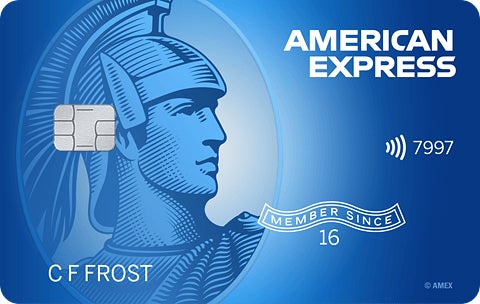
Rewards rate
At a glance.
See if you’re pre-approved for this card using our CardMatch tool .
- Earn a $200 statement credit after you spend $2,000 in purchases on your new Card within the first 6 months.
- No Annual Fee.
- Balance Transfer is back! Enjoy 0% intro APR on purchases and balance transfers for 15 months from the date of account opening. After that, 19.24% to 29.99% variable APR.
- 3% Cash Back at U.S. supermarkets on up to $6,000 per year in purchases, then 1%.
- 3% Cash Back on U.S. online retail purchases, on up to $6,000 per year, then 1%.
- 3% Cash Back at U.S. gas stations, on up to $6,000 per year, then 1%.
- Cash Back is received in the form of Reward Dollars that can be redeemed as a statement credit or at Amazon.com checkout.
- Thinking about getting the Disney Bundle which can include Disney+, Hulu, and ESPN+? Your decision made easy with $7/month back in the form of a statement credit after you spend $9.99 or more each month on an eligible subscription (subject to auto renewal) with your Blue Cash Everyday® Card. Enrollment required.
- Enjoy up to $15 back per month when you purchase a Home Chef meal kit subscription (subject to auto renewal) with your enrolled Blue Cash Everyday® Card.
- Terms Apply.
Rates & Fees
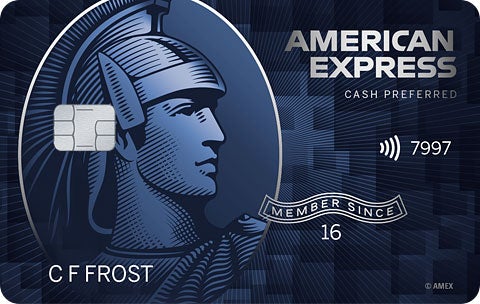
- Earn a $250 statement credit after you spend $3,000 in purchases on your new Card within the first 6 months.
- $0 intro annual fee for the first year, then $95.
- Buy Now, Pay Later: Enjoy $0 intro plan fees when you use Plan It® to split up large purchases into monthly installments. Pay $0 intro plan fees on plans created during the first 12 months from the date of account opening. Plans created after that will have a monthly plan fee up to 1.33% of each eligible purchase amount moved into a plan based on the plan duration, the APR that would otherwise apply to the purchase, and other factors.
- Low Intro APR: 0% on purchases and balance transfers for 12 months from the date of account opening. After that, your APR will be a variable APR of 19.24% - 29.99%. Variable APRs will not exceed 29.99%.
- 6% Cash Back at U.S. supermarkets on up to $6,000 per year in purchases (then 1%).
- 6% Cash Back on select U.S. streaming subscriptions.
- 3% Cash Back at U.S. gas stations.
- 3% Cash Back on transit (including taxis/rideshare, parking, tolls, trains, buses and more).
- 1% Cash Back on other purchases.
- Get up to $120 in statement credits annually when you pay for an auto-renewing subscription to Equinox+ at equinoxplus.com with your Blue Cash Preferred® Card. That’s $10 in statement credits each month. Enrollment required.
- Thinking about getting the Disney Bundle which can include Disney+, Hulu, and ESPN+? Your decision made easy with $7/month back in the form of a statement credit after you spend $9.99 or more each month on an eligible subscription (subject to auto renewal) with your Blue Cash Preferred® Card. Enrollment required.
Citi Double Cash® Card
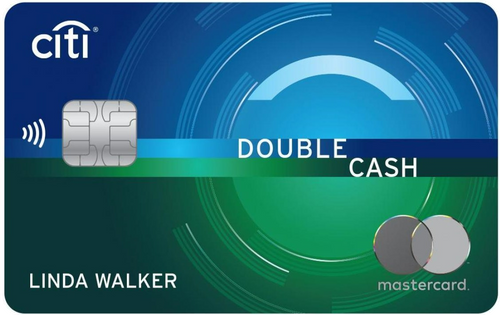
- Earn $200 cash back after you spend $1,500 on purchases in the first 6 months of account opening. This bonus offer will be fulfilled as 20,000 ThankYou® Points, which can be redeemed for $200 cash back.
- Earn 2% on every purchase with unlimited 1% cash back when you buy, plus an additional 1% as you pay for those purchases. To earn cash back, pay at least the minimum due on time. Plus, for a limited time, earn 5% total cash back on hotel, car rentals and attractions booked on the Citi Travel℠ portal through 12/31/24.
- Balance Transfer Only Offer: 0% intro APR on Balance Transfers for 18 months. After that, the variable APR will be 19.24% - 29.24%, based on your creditworthiness.
- Balance Transfers do not earn cash back. Intro APR does not apply to purchases.
- If you transfer a balance, interest will be charged on your purchases unless you pay your entire balance (including balance transfers) by the due date each month.
- There is an intro balance transfer fee of 3% of each transfer (minimum $5) completed within the first 4 months of account opening. After that, your fee will be 5% of each transfer (minimum $5).
Citi® / AAdvantage® Executive World Elite Mastercard®
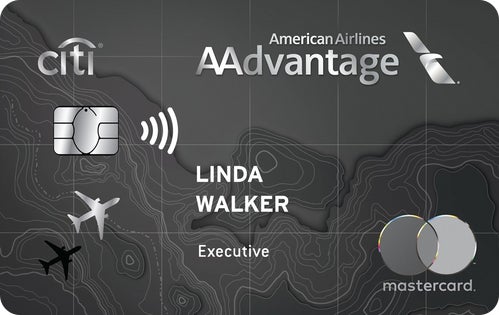
- Earn 70,000 American Airlines AAdvantage® bonus miles after spending $7,000 within the first 3 months of account opening.
- Admirals Club® membership for you and access for up to two guests or immediate family members traveling with you
- No Foreign Transaction Fees on purchases
- Earn 1 Loyalty Point for every 1 eligible AAdvantage® mile earned from purchases
- First checked bag is free on domestic American Airlines itineraries for you and up to 8 companions traveling with you on the same reservation
Discover it® Cash Back
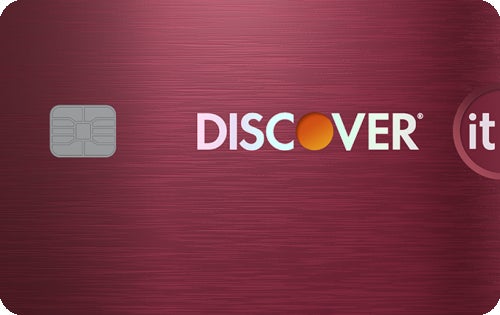
- Intro Offer: Unlimited Cashback Match for all new cardmembers – only from Discover. Discover will automatically match all the cash back you’ve earned at the end of your first year! There’s no minimum spending or maximum rewards. You could turn $150 cash back into $300.
- Earn 5% cash back on everyday purchases at different places you shop each quarter like grocery stores, restaurants, gas stations, and more, up to the quarterly maximum when you activate. Plus, earn unlimited 1% cash back on all other purchases—automatically.
- Redeem your rewards for cash at any time.
- Discover could help you reduce exposure of your personal information online by helping you remove it from select people-search sites that could sell your data. It’s free, activate with the mobile app.
- Get a 0% intro APR for 15 months on purchases. Then 17.24% to 28.24% Standard Variable Purchase APR applies, based on credit worthiness.
- No annual fee.
- Terms and conditions apply.
Discover it® Miles
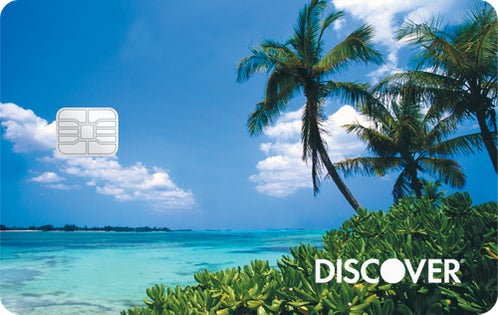
- Unlimited Bonus: Unlimited Mile-for-Mile match for all new cardmembers - only from Discover. Discover gives you an unlimited match of all the Miles you’ve earned at the end of your first year. For example, if you earn 35,000 Miles, you get 70,000 Miles. There’s no signing up, no minimum spending or maximum rewards. Just a Miles-for-Miles match.
- Automatically earn unlimited 1.5x Miles on every dollar of every purchase
- No annual fee
- Turn Miles into cash. Or redeem as a statement credit for your travel purchases like airfare, hotels, rideshares, gas stations, restaurants and more.
- 0% intro APR for 15 months on purchases. Then 17.24% - 28.24% Standard Variable Purchase APR will apply.
- Discover is accepted nationwide by 99% of the places that take credit cards.
Hilton Honors American Express Card
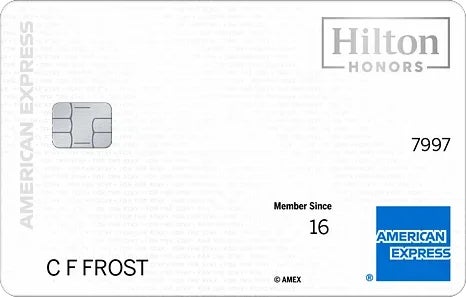
- Earn 100,000 Hilton Honors Bonus Points after you spend $2,000 in purchases on the Card in the first 6 months of Card Membership. Offer ends 4/17/24.
- Earn 7X Hilton Honors Bonus Points for each dollar of eligible purchases charged on your Card directly with hotels and resorts within the Hilton portfolio.
- Earn 5X Points per dollar on purchases at U.S. restaurants, at U.S. supermarkets, and at U.S. gas stations.
- Earn 3X Points for all other eligible purchases on your Card.
- Enjoy complimentary Hilton Honors™ Silver status with your Card. Plus, spend $20,000 on eligible purchases on your Card in a calendar year and you can earn an upgrade to Hilton Honors™ Gold status through the end of the next calendar year.
- No Foreign Transaction Fees. Enjoy international travel without additional fees on purchases made abroad.
Comparing EMV Chip Credit Cards
In the last three years, card issuers have been sending out new plastic with a little square on the front that makes all the difference in the world.
Called an EMV chip , this small change has made our cards more secure than the old magnetic stripe technology. In fact, fraud has considerably decreased over the last three years, experts have noticed.
What are EMV chip cards and how do they work?
EMV, which stands for EuroPay, Mastercard, Visa , equips credit and debit cards with computer chips and technology to authenticate chip-card transactions.
EMV cards or chip cards have been used in Europe and throughout the world for decades, and they have been making headway in the U.S. They are touted as more secure than the magnetic stripes that have long been used in the United States until the last couple of years.
While the older magnetic stripes contain unchanging data – which the bad guys can conceivably steal – an EMV card creates a new transaction code for each payment that can’t be used again. That doesn’t mean breaches aren’t possible, but it makes things more complicated and difficult for thieves.
Visa reports a 75% drop in counterfeit fraud dollars between September 2015 and March 2018 among merchants who made the switch and a 46% drop overall. Also Visa reports that 97% of payment volume was on EMV cards in June 2018, and chip transactions grew from $4.8 billion in September 2015 to $76.7 billion in June 2018.
Want to know how EMV chips are made? Check out this video .
How the EMV works
There are several things going on with how a chip card works. Here’s Visa ‘s take on this:
- Computer microchip. A computer chip securely stores the card data that resides on the magnetic stripe. That makes it nearly impossible to create a fake EMV chip card.
- Unique cryptogram. The computer chip enables more secure processing by producing a one-time code for each transaction.
- Mobile shopping. EMV technology will also enable a one-time code for mobile transactions and support other security innovations like tokenization.
How to use an EMV chip credit card
Not sure how to use that new chip-enabled card? It’s simple:
- Insert card. With the chip facing the terminal and facing up, insert the card rather than swiping.
- Leave the card alone. Let the card stay in the terminal until prompted to take it out.
- Sign a receipt. You may be asked to provide a signature or PIN, although many merchants are now allowing small purchases without a signature.
- Remove your card. Some terminals will prompt you to remove your card with a loud beeping noise. Either way, don’t forget it!
Major benefits
With safety as a primary feature, EMV chip cards deliver added protection to every purchase you make. And fraud is big business, financial experts have found, so you need all the help you can get:
- Checks were targeted
- Wire fraud was targeted
- Corporate card fraud was targeted
Source: 2018 AFP Payments Fraud Survey
With fraud top of mind for many consumers, a chip-enabled card is a welcome package in the mail. Still need convincing? Here are benefits of an EMV chip card:
- Can’t easily counterfeit. Because EMV chip cards use cryptograms that are unique to each transaction, stolen chip card data cannot be used to create fake cards, says Visa.
- Less risk of fraud. Visa says the added layer of security provided by chip cards makes credit and debit card data much less valuable, decreasing incentive for the bad guys to steal data.
- Zero liability. With chip cards, cardholders are still protected from fraudulent purchases with Visa’s zero liability policy, which is common in the industry.
- Easy to use. Once you get the hang of it, you’ll find the chip card to be a breeze. If you feel it takes too long, you’re not alone (although it actually only takes seconds). A CreditCards.com poll found that one-sixth of consumers felt that it takes too long, although almost three-fifths had no complaints .
About the Author
Remove a card to add another to compare
Add at least 2 cards to compare
CreditCards.com is an independent, advertising-supported comparison service. The offers that appear on this site are from companies from which CreditCards.com receives compensation. This compensation may impact how and where products appear on this site, including, for example, the order in which they may appear within listing categories. Other factors, such as our own proprietary website rules and the likelihood of applicants' credit approval also impact how and where products appear on this site. CreditCards.com does not include the entire universe of available financial or credit offers. CCDC has partnerships with issuers including, but not limited to, American Express, Bank of America, Capital One, Chase, Citi and Discover.
Since 2004, CreditCards.com has worked to break down the barriers that stand between you and your perfect credit card. Our team is made up of diverse individuals with a wide range of expertise and complementary backgrounds. From industry experts to data analysts and, of course, credit card users, we’re well-positioned to give you the best advice and up-to-date information about the credit card universe.
Let’s face it — there’s a lot of jargon and high-level talk in the credit card industry. Our experts have learned the ins and outs of credit card applications and policies so you don’t have to. With tools like CardMatch™ and in-depth advice from our editors, we present you with digestible information so you can make informed financial decisions.
Our top goal is simple: We want to help you narrow down your search so you don’t have to stress about finding your next credit card. Every day, we strive to bring you peace-of-mind as you work toward your financial goals.
A dedicated team of CreditCards.com editors oversees the automated content production process — from ideation to publication. These editors thoroughly edit and fact-check the content, ensuring that the information is accurate, authoritative and helpful to our audience.
Editorial integrity is central to every article we publish. Accuracy, independence and authority remain as key principles of our editorial guidelines. For further information about automated content on CreditCards.com , email Lance Davis, VP of Content, at [email protected] .
Know your odds before you apply
- Enter your information
- We’ll run a soft credit pull, which won’t impact your credit score
- You’ll see your estimated approval odds near cards to help you narrow down your options
Your personal information and data are protected with 256-bit encryption.
Tell us your name to get started
We’ll use this information to to verify your credit profile.
What’s your mailing address?

What's your employment status?
Your answer should account for all personal income, including salary, part-time pay, retirement, investments and rental properties. You do not need to include alimony, child support, or separate maintenance income unless you want to have it considered as a basis for repaying a loan. Increase non-taxable income or benefits included by 25%.
Put $0 if you currently don't have a rent or mortgage payment.
Last four digits of your Social Security number
We’ll use the last four digits of your Social Security number to get your approval odds. This won’t impact your credit score.
What’s your email address?
Your email address unlocks your approval odds. Don’t worry, we won’t spam your inbox.
By clicking "See my odds" you agree to our Terms of Use (including our Prequalification Terms ) and Privacy Policy . These terms allow CreditCards.com to use your consumer report information, including credit score, for internal business purposes, such as improving the website experience and to market other products and services to you. I understand that this is not an application for credit and that, if I wish to apply for a credit card with any participating credit card issuer, I will need to click through to complete and submit an application directly with that issuer.
Calculating your approval odds
Oops something went wrong..
We’re sorry, but something went wrong and we couldn’t find your approval odds. Instead, you'll see recommended credit ranges from the issuers listed next to cards on our site.
Guide to chip and PIN credit cards
Advertiser disclosure.
We are an independent, advertising-supported comparison service. Our goal is to help you make smarter financial decisions by providing you with interactive tools and financial calculators, publishing original and objective content, by enabling you to conduct research and compare information for free - so that you can make financial decisions with confidence.
Bankrate has partnerships with issuers including, but not limited to, American Express, Bank of America, Capital One, Chase, Citi and Discover.
- Share this article on Facebook Facebook
- Share this article on Twitter Twitter
- Share this article on LinkedIn Linkedin
- Share this article via email Email
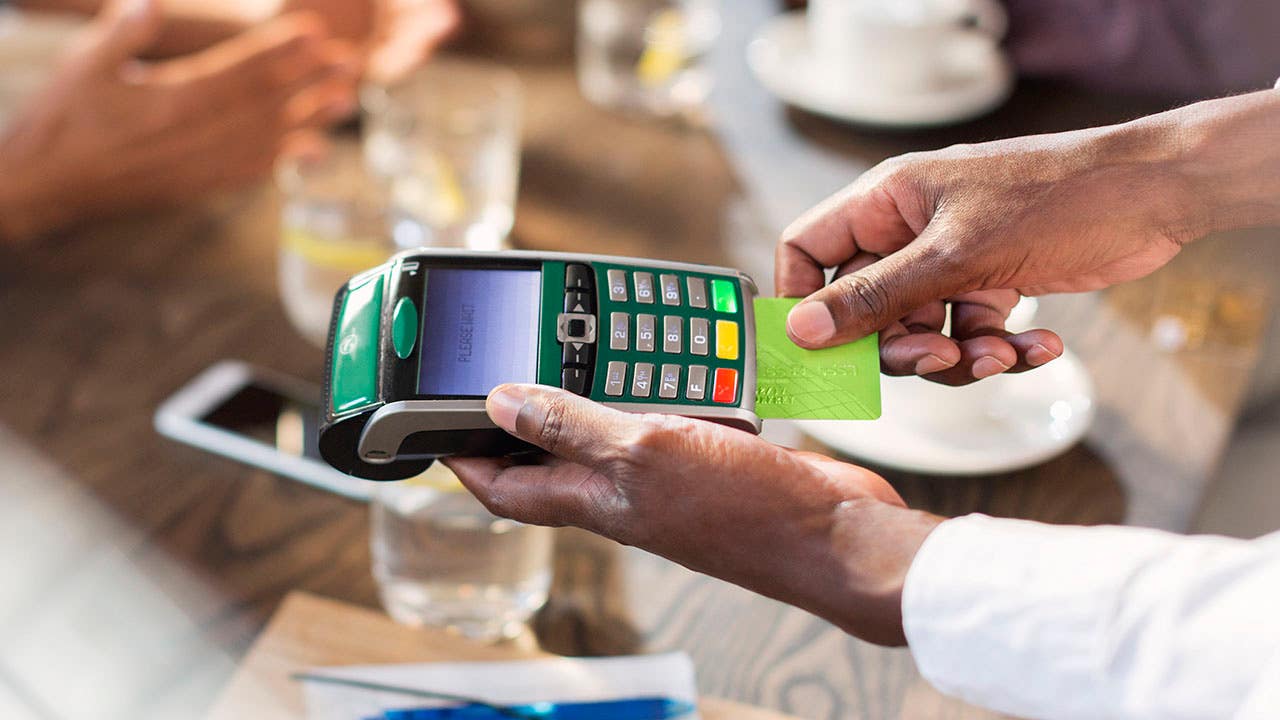
At Bankrate, we take the accuracy of our content seriously.
“Expert verified” means that our Financial Review Board thoroughly evaluated the article for accuracy and clarity. The Review Board comprises a panel of financial experts whose objective is to ensure that our content is always objective and balanced.
Their reviews hold us accountable for publishing high-quality and trustworthy content.

- • Rewards strategy
- • Small business marketing
The Bankrate promise
At Bankrate we strive to help you make smarter financial decisions. While we adhere to strict editorial integrity , this post may contain references to products from our partners. Here's an explanation for how we make money . The content on this page is accurate as of the posting date; however, some of the offers mentioned may have expired. Terms apply to the offers listed on this page. Any opinions, analyses, reviews or recommendations expressed in this article are those of the author’s alone, and have not been reviewed, approved or otherwise endorsed by any card issuer.
At Bankrate, we have a mission to demystify the credit cards industry — regardless or where you are in your journey — and make it one you can navigate with confidence. Our team is full of a diverse range of experts from credit card pros to data analysts and, most importantly, people who shop for credit cards just like you. With this combination of expertise and perspectives, we keep close tabs on the credit card industry year-round to:
- Meet you wherever you are in your credit card journey to guide your information search and help you understand your options.
- Consistently provide up-to-date, reliable market information so you're well-equipped to make confident decisions.
- Reduce industry jargon so you get the clearest form of information possible, so you can make the right decision for you.
At Bankrate, we focus on the points consumers care about most: rewards, welcome offers and bonuses, APR, and overall customer experience. Any issuers discussed on our site are vetted based on the value they provide to consumers at each of these levels. At each step of the way, we fact-check ourselves to prioritize accuracy so we can continue to be here for your every next.
Editorial integrity
Bankrate follows a strict editorial policy , so you can trust that we’re putting your interests first. Our award-winning editors and reporters create honest and accurate content to help you make the right financial decisions.
Key Principles
We value your trust. Our mission is to provide readers with accurate and unbiased information, and we have editorial standards in place to ensure that happens. Our editors and reporters thoroughly fact-check editorial content to ensure the information you’re reading is accurate. We maintain a firewall between our advertisers and our editorial team. Our editorial team does not receive direct compensation from our advertisers.
Editorial Independence
Bankrate’s editorial team writes on behalf of YOU — the reader. Our goal is to give you the best advice to help you make smart personal finance decisions. We follow strict guidelines to ensure that our editorial content is not influenced by advertisers. Our editorial team receives no direct compensation from advertisers, and our content is thoroughly fact-checked to ensure accuracy. So, whether you’re reading an article or a review, you can trust that you’re getting credible and dependable information.
How we make money
You have money questions. Bankrate has answers. Our experts have been helping you master your money for over four decades. We continually strive to provide consumers with the expert advice and tools needed to succeed throughout life’s financial journey.
Bankrate follows a strict editorial policy , so you can trust that our content is honest and accurate. Our award-winning editors and reporters create honest and accurate content to help you make the right financial decisions. The content created by our editorial staff is objective, factual, and not influenced by our advertisers.
We’re transparent about how we are able to bring quality content, competitive rates, and useful tools to you by explaining how we make money.
Bankrate.com is an independent, advertising-supported publisher and comparison service. We are compensated in exchange for placement of sponsored products and services, or by you clicking on certain links posted on our site. Therefore, this compensation may impact how, where and in what order products appear within listing categories, except where prohibited by law for our mortgage, home equity and other home lending products. Other factors, such as our own proprietary website rules and whether a product is offered in your area or at your self-selected credit score range, can also impact how and where products appear on this site. While we strive to provide a wide range of offers, Bankrate does not include information about every financial or credit product or service.
Paying for purchases with a rewards credit card has always been convenient, but you may have noticed some substantial changes in how your card is processed over the years. For example, where we once “swiped” our credit cards in a payment terminal to make a payment , we are now asked to insert our credit card—or “dip” our card—instead. In some cases, you may even be able to “tap to pay” with your credit card, which involves holding it next to the terminal so your card information can be accurately read.
In any case, the main driving force behind these changes is technology, including the introduction of chip and PIN credit cards. This guide explains everything you need to know about chip and PIN credit cards, how they work and why you may want to begin using them.
How do chip and PIN cards work?
Chip and PIN cards are named after three major credit card networks across the world—Europay, Mastercard and Visa (EMV)—and were first introduced in Europe in 1993.
Chip and PIN cards were developed as a way to reduce point-of-sale credit card number theft and skimming cybercrimes. And, as of Oct. 2015, all U.S. merchants were mandated to accept EMV cards or face potential liability for any credit card fraud originating at their establishment.
But, how do chip and pin credit cards work exactly? Instead of using the magnetic stripe on the side you once used to make a purchase, chip and PIN credit cards have a small metallic chip on the front that holds your payment data. This metallic chip is designed to reduce fraud, and it does so by providing a unique code for each purchase you make. Because the security code is unique for every purchase, it’s significantly more difficult for a thief to use your card for the purpose of fraud.
What is a credit card PIN?
A credit card PIN—also known as your personal identification number—is a four-digit code you can use to verify you are the person making a purchase with your chip and PIN credit card. You can pick your own PIN when you sign up for a chip and pin credit card, and you can also change your PIN at any time.
With a unique PIN that nobody but you knows, your transactions should be even less susceptible to fraud. After all, it’s fairly easy to forge a signature and walk away with merchandise at a payment terminal, yet hackers and thieves will have a difficult time guessing a four-digit code. Your chip credit card might not automatically come with a pin.
Can I get a PIN for my credit card?
Most credit cards with chip technology issued in the U.S. are considered “chip and signature” cards. This type of credit card comes with the added fraud protection of chip technology, yet you’ll be asked to provide a signature instead of a PIN when you use your card for purchases.
Some credit card issuers offer PIN capacity as well, meaning you can add a PIN to your card that doesn’t already have one. But if you want this added layer of protection, it’s up to you to call your card issuer to inquire.
Are chip and PIN credit cards safe?
Chip and PIN credit cards are significantly safer to use than their outdated magnetic stripe counterparts. This is due to the unique, encrypted code that is generated each time you initiate a transaction. This code allows your actual credit card number to remain concealed and makes any data derived from thieves during a transaction absolutely useless.
However, consumers should keep in mind that credit card transactions are already “safe” in terms of their liability. The Fair Credit Billing Act (FCBA) sets a limit of $50 in total liability for fraudulent credit card transactions made with your card, and liability is set at $0 for fraudulent transactions made with your card number. On top of that, the majority of credit cards have zero fraud liability policies that ensure you won’t pay a dime for purchases you didn’t make.
If someone uses your credit card or card number for fraudulent purchases, all you have to do is call your card issuer and report the fraud. From there, the fraudulent transactions are wiped from your account, and your issuer will take over the investigation from there. Additionally, you’ll be sent a new physical credit card, as well as a new account number to use.
Best credit cards with chip and PIN security for 2022
If you like the idea of having the best credit card security features out there, it’s smart to take a closer look at credit cards that have chip and PIN technology. Here are Bankrate’s top chip and PIN credit cards for 2022:
Chase Freedom Unlimited: Best overall
If you’re looking for a no-annual-fee chip and pin credit card, the Chase Freedom Unlimited® is hard to beat. With this Chase credit card, you’ll earn 5 percent cash back on travel purchased through Chase Ultimate Rewards , 3 percent cash back on dining, 3 percent cash back on drugstore purchases and 1.5 percent back on all purchases. If you frequently utilize rideshare services, you’ll get 5 percent cash back on Lyft purchases through March 2025. In the first year, you’ll earn an extra 1.5 percent cash back on everything you buy (on up to $20,000 in the first 12 months). That’s 6.5 percent on travel purchased through Chase Ultimate Rewards, 4.5 percent on dining and drugstores, and 3 percent on all other purchases.
Blue Cash Everyday Card from American Express: Best for groceries
The Blue Cash Everyday® Card from American Express is another no-annual-fee chip and pin credit card that lets you earn cash back on grocery purchases and other bills. This cash back credit card comes with a welcome bonus of $200 back after you spend $2,000 in purchases on your new card within the first six months of card membership. You will receive cash back in the form of statement credits.
You can also earn 3% cash back at U.S. supermarkets, U.S. gas stations and U.S. online retail purchases on up to $6,000 per calendar year in purchases in each category (then 1%), and 1% cash back on other purchases.. Just keep in mind that cash back earned with this card can be redeemed for statement credits to your account.
Bank of America Premium Rewards credit card: Best for travel
The Bank of America® Premium Rewards® credit card charges a $95 annual fee, yet the rewards and perks you receive can make it a good investment. You can start off earning 50,000 online bonus points ($500 value) when you spend $3,000 on your card within the first 90 days of account opening. You’ll also earn 2X points per $1 spent on travel and dining and 1.5X points per $1 spent on all other purchases. Additional benefits you can enjoy with this travel credit card include up to a $100 airline incidental credit each year, up to $100 in Global Entry or TSA Precheck credits every four years and no foreign transaction fees.
The bottom line
Chip and PIN technology may be fairly new in the world of credit cards, but it is definitely here to stay. However, you should take the time to compare the top chip-and-pin and chip-and-signature rewards credit cards since their benefits can vary. With some research, you can wind up with a credit card that has the best security features and the rewards and perks you want the most.

Related Articles

Worried about mobile banking security? Follow these best practices

Can chip cards be skimmed?
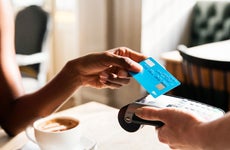
RFID credit cards: Should you worry about protection?

Best credit cards for Uber and Lyft
Tiny chip. Big security.
Your barclays credit card, now with chip technology..

Learn more about your chip card.
Many Barclays credit cards now feature chip technology – to make paying for your purchases more secure and convenient in the U.S. and abroad.

Chip-card benefits.

Keep your transactions safe.
Your chip card stores your account information on a tiny microchip embedded in the plastic. When you make purchases at chip-card terminals, the chip:
- Protects your account information.
- Reduces the risk of fraud.
- Makes your card difficult to counterfeit.

Enjoy the convenience of traveling with your chip card.
Chip technology is now standard in more than 130 countries around the world:
- Mexico, Canada and popular destinations throughout Europe, Asia, Australia and Latin America already support chip.
- U.S. merchants are quickly switching to chip – which means your card can help you make more secure purchases practically anywhere you go.

Use your card every time you pay, at any type of terminal.
No matter where you use your card, you’re covered by our $0 Fraud Liability protection:
- In addition to a chip, your card also has a magnetic stripe, so you can swipe to pay at merchants that don’t support chip transactions.
- PIN capability lets you use your card at self-service chip terminals for maximum global acceptance.
Whether you pay using chip technology, or swipe your card, you can be confident knowing you’re covered by our $0 Fraud Liability protection for any unauthorized transactions you report to us.
How to use your chip card., at chip-card terminals:.
Insert your card into the reader – chip side up and chip end in – and leave it there until your transaction is complete.
When prompted, confirm your purchase amount.
In most cases, you’ll then be prompted to sign for your transaction. But at self-service terminals like ticket kiosks and some gas pumps, you may need to enter your 4-digit PIN.
Remove your card from the reader when prompted, and take your receipt.

At traditional magnetic-stripe terminals:
It's simple! Just swipe and sign as you always have. (There's also no change for online and phone purchases.) But remember, since U.S merchants are quickly making the switch to chip, you'll use your magnetic stripe less often as time goes by.
Flexibility is a wonderful thing.
Your chip card works with all types of payment authorizations:
- Chip & signature – at most checkout counters
- Chip & PIN – at self-service terminals like ticket kiosks and some gas pumps
- Chip & no verification – mostly on low-value purchases
What you need to know about your PIN.
Be sure to create your PIN.
We assigned a 4-digit PIN to your account when it was opened, and we encourage you to change it to something easy to remember, difficult to guess. When activating your card online or by phone, you’ll be prompted to create a PIN. You won’t need to know your assigned PIN to customize it.
Then activate it.
If you change your PIN, it won’t take effect until you use your card at a chip-card terminal with a cashier. Your first transaction will activate the PIN. You’ll then be able to use the chip-and-PIN feature at self-service chip-card terminals, when required.
Your PIN will work at ATMs, too.
You can use your PIN to withdraw cash at ATMs in the U.S. and worldwide. Your Cash Advance Annual Percentage Rate (APR) will apply. Please note that there is only one PIN assigned to your account. As the primary cardmember, you can share your PIN with authorized users, at your discretion.
Chip-card Q&A.
What is a chip card, is there an extra fee for having a chip card, what's the difference between a chip card, a smart card, an icc card and an emv (europay/mastercard ® /visa ® ) credit card, i just received a chip card and i don’t like it. can i switch back to a card with only a magnetic stripe, does my chip card support contactless payment, using my chip card, how does my chip card work, setting up and using my pin, how do i get a pin for my chip card.
Although we assigned a 4-digit PIN to your account when we opened it, we encourage you to change your PIN to something easy to remember, difficult to guess.
- If you activate your new card online, you’ll be prompted to create a PIN. You won’t have to know your existing PIN to create a new one.
- If you call us to activate your new card, you can also create a PIN, or you can request to have your assigned PIN mailed to you. You can also manage your PIN anytime by visiting the customer service website listed on the back of your card. After you log in, go to the Manage your PIN section.
Please note that if you create a new PIN, you’ll have to sign for your first transaction at a chip-card terminal with a cashier. After your first chip transaction has been completed, your PIN will be activated and you’ll be able to use your card at self-service terminals where a PIN is required.
You can also use your PIN for cash advances at ATMs in the U.S. and around the world. Your Cash Advance Annual Percentage Rate (APR) will apply. Remember that there is only one PIN for your account. As the primary cardmember, you can share your PIN with authorized users, at your discretion.
What do I do if I forget my PIN?
Just go to Account Settings/Manage Your PIN to change your PIN. You won’t need to know your current PIN to change it. Also, you can call the number on the back of your card and request to have your PIN mailed to you.
Traveling with my chip card
Is there anything special i should do before i travel abroad, what if i’m traveling to mexico, the south pacific or europe, and i only bring a traditional magnetic-stripe credit card, why do merchants ask me for my signature instead of a pin, enhanced account security, does the chip record any of my personal information.
No. The chip stores only your account information. It also encrypts transaction data when you use your card.
Am I liable in case of fraud?
Not at all. You’re covered by our $0 Fraud Liability protection for any unauthorized transactions you report to us.
- Sign in
Bank of America® Travel Rewards Credit Card
We're sorry, this page is temporarily unavailable. We apologize for the inconvenience.
Unavailable
One or more of the cards you chose to compare are not serviced in English.
Continue in English Go back to Spanish
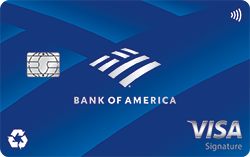
25,000 online bonus points offer (a $250 value) and no annual fee †
Earn unlimited 1.5 points for every $1 you spend on all purchases everywhere, every time
Card Details
Unlimited points.
Earn unlimited 1.5 points for every $1 you spend on all purchases everywhere, every time and no expiration on points as long as your account remains open. Calculate Rewards Travel Rewards
No annual fee † and no foreign transaction fees †
Enjoy no annual fee and no foreign transaction fees while earning points to use for a statement credit to pay for flights, hotel stays, vacation rentals, baggage fees, and also at restaurants – including takeout.
Low Introductory APR Offer
0% † Intro APR for your first 15 billing cycles for purchases, and for any balance transfers made within the first 60 days of opening your account. After the intro APR offer ends, a Variable APR that's currently 18.24% to 28.24% will apply. 3% † Intro balance transfer fee for the first 60 days your account is open. After the intro balance transfer fee offer ends, the fee for all future balance transfers is 4%.
25,000 online bonus points offer
25,000 online bonus points if you make at least $1,000 in purchases in the first 90 days of your account opening – which can be redeemed for a $250 statement credit toward travel and dining purchases
Get even more rewards
Bank of America Preferred Rewards ® members earn 25%-75% more points on every purchase
That means you could earn 1.87 to 2.62 points for every $1 you spend, everywhere, every time.
Learn more about Preferred Rewards Travel Rewards
Interest Rates & Fees Summary †
Introductory apr.
0% for 15 billing cycles
Applies to purchases and to any balance transfers made within 60 days of opening your account
Standard APR
18.24% - 28.24%
Balance Transfer Fee
After the intro balance transfer fee offer ends, the fee for all future balance transfers is 4%.
† Please see Terms and Conditions for rate, fee and other cost information, as well as an explanation of payment allocation. All terms may be subject to change.
Note: minimum payments are applied to lower-interest balances first. Additional payments are applied to higher-interest balances first.
Earn unlimited 1.5 points for every $1 you spend on all purchases everywhere, every time.
No blackout dates or restrictions and points do not expire as long as your account remains open.
Use our rewards calculator to see where your points can take you...
Use your card to book your trip how and where you want - you're not limited to specific websites with blackout dates or restrictions.
Flexibility to redeem points for a statement credit to pay for travel and dining purchases, such as flights, hotel stays, vacation rentals, baggage fees, and also at restaurants – including takeout.
See how many points you can earn
Tell us how much you spend every.
for every $1 spent on purchases
Your 1 Year of spending
Pay yourself back with a statement credit towards travel and dining purchases
Redeem points for a statement credit to pay for flights, hotels, vacation packages, cruises, rental cars or baggage fees, or dining expenses, such as restaurants and takeout. (Redemptions for cash or gift cards will be of lesser value.)
Travel Rewards
Customer bonus
Gold Tier Preferred Rewards Bonus
Platinum Tier Preferred Rewards Bonus
Platinum Honors Tier and Higher Preferred Rewards Bonus
Learn more about Preferred Rewards
Preferred Rewards makes your card even better
Note: This calculator is for illustrative purposes only. It is not intended to be printed or distributed. Your actual rewards earned will depend upon your individual purchases.
10% Customer bonus
25% Gold Tier Preferred Rewards Bonus
50% Platinum Tier Preferred Rewards Bonus
75% Platinum Honors Tier and Higher Preferred Rewards Bonus
Security & Features
Stay protected, contactless chip technology, balance connect ® for overdraft protection, paperless statement option, digital wallet technology, online & mobile banking, account alerts, fico ® score.
Now, when you opt-in you can access your FICO ® Score updated monthly for free, within your Mobile Banking app or in Online Banking. FICO ® Score Program . The FICO ® Score Program is for educational purposes and for your non-commercial, personal use. This benefit is available only for primary cardholders with an open and active consumer credit card account who have a FICO ® Score available. The feature is accessible through Online Banking, the Mobile website, and the Mobile Banking app for iPhone and Android devices. FICO is a registered trademark of Fair Isaac Corporation in the United States and other countries. Data connection required. Wireless carrier fees may apply." data-footnote="ADDITIONAL_BENEFITS_FOOTNOTE_07" aria-label="Footnote 5"> Footnote [5] Learn More about Free FICO Credit Score opens in a new window
Priority code: QAF1UM
Schedule an appointment to apply in person
Connect one on one with a credit card specialist
/static-assets/statics-12128/images/financebuzz.png)
Trending Stories
/images/2018/01/23/navina-side-hustle-mid_MPfEDfV.jpg)
15 Legit Ways to Make Extra Cash
/images/2019/12/06/smart_strategies_to_save_money_on_car_insurance.jpg)
6 Smart Strategies to Save Money on Car Insurance
4 options for chip-and-pin credit cards in the u.s..
/authors/christy_rakoczy_updated.png)
This article was subjected to a comprehensive fact-checking process. Our professional fact-checkers verify article information against primary sources, reputable publishers, and experts in the field.
/images/2019/06/21/couple-paying-using-chip-and-pin-credit-card.jpg)
We receive compensation from the products and services mentioned in this story, but the opinions are the author's own. Compensation may impact where offers appear. We have not included all available products or offers. Learn more about how we make money and our editorial policies .
For decades, credit cards carried their data on a magnetic strip on the card’s back. Unfortunately, counterfeiting was fairly easy with magnetic stripe cards, so credit cards weren’t very secure.
Today, most credit cards come embedded with Europay, MasterCard, and Visa (EMV) microchips, which contain encrypted data that makes chip cards much more secure.
Though cards typically have EMV chip technology, there's a key difference between how most U.S. credit cards work vs. how credit cards work abroad. In the U.S., retailers generally verify the cardholder’s identity by matching up the signature on the back of the credit card with a receipt at checkout.
However, most cards issued abroad don’t rely on signatures — instead, cardholders have to enter a PIN, or personal identification number, when they pay — similar to what you'd experience with a debit card. These are known as chip-and-PIN credit cards.
Why chip-and-PIN cards aren't common in the U.S.
4 chip-and-pin cards you can get in the u.s., what are chip-and-signature cards, bottom line.
EMV chip-and-PIN cards aren’t common in the U.S. for a few reasons:
- Consumers are used to signing a sales slip when using a credit card, and entering a PIN could be a hassle.
- Credit card issuers don’t want to deter customers from paying with their cards by forcing them to enter a PIN.
- It’s not cost-effective for card issuers to issue cards with PINs to millions of customers.
Though these EMV cards aren’t that common, certain card issuers do offer them. Some offer PIN-priority cards, which means the default when you make a transaction with the card is to enter a PIN. Others offer PIN-capable cards, which means you can request a PIN and complete credit card transactions with a PIN, but the default when you put your card into a chip reader is to require a signature.
Suppose you’ll be traveling abroad, especially to Europe. In that case, you’ll likely want a card with PIN capability because self-payment terminals and credit card processing kiosks in foreign countries might not work otherwise.
If you want to make sure you’re able to use your card in countries where chip-and-PIN technology is the norm, here are five cards you can get in the U.S. with chip-and-PIN functionality.
- The Platinum Card ® from American Express
- AAdvantage ® Aviator ® Red World Elite Mastercard ®
- Navy Federal Visa Signature ® Flagship Rewards Card
- PenFed Power Cash Rewards Visa Signature ® Card
- The Platinum Card from American Express
- Annual fee : $ 695
- Welcome offer : Earn 80,000 Membership Rewards points after spending $8,000 on purchases on your new card in the first 6 months
- Rewards rate : 5X points per dollar spent on eligible airfare (on up to $500,000 per calendar year, after that 1X) and eligible hotel purchases, and 1X points per dollar on all other eligible purchases
If you're a frequent traveler who enjoys top-notch travel perks, the Platinum Card from American Express may be a good option for you. While this card does come with a hefty $ 695 annual fee, the perks outweigh the cost in many cases.
Each year, cardholders receive up to $200 in Uber Cash for U.S. rides and Uber Eats orders (terms apply), up to $100 statement credit for Saks Fifth Avenue purchases, and up to $200 in hotel credits on qualifying charges at select hotels. The credits alone can help offset the annual fee, but frequent travelers can also benefit from earning up to 5X points per dollar spent on eligible purchases. Select benefits require enrollment.
Other perks and benefits of the Amex Platinum Card include:
- Complimentary access to airport lounges
- Up to $240 digital entertainment credit
- Up to $189 CLEAR credit which can help you go through security checks faster
- Up to $155 Walmart+ credit
- Up to $300 Equinox credit
- Select benefits require enrollment
Read more about this card's benefits in our Amex Platinum review.
- Barclays AAdvantage Aviator Red World Elite Mastercard
- Annual fee: $99
- Welcome offer: Earn 60,000 bonus miles after you make your first purchase and pay the annual fee in the first 90 days
- Rewards rate: 2X miles per dollar spent on eligible American Airlines purchases, and 1X mile per dollar spent on all other purchases
If you’re a frequent traveler on American Airlines, the Barclaycard AAdvantage Aviator Red World Elite Mastercard may be a great choice for you. Not only will you earn extra bonus miles when you shop with American Airlines, but you’ll also get a 25% savings in the form of a statement credit on all inflight purchases of food and beverages on American Airlines-operated flights.
While the card has a $99 annual fee, it also comes with some generous features that make it worth your while if you travel often. Other perks and benefits of the card include:
- Free checked bag on American Airlines flights
- Up to $25 in statement credits per year for spending on WiFi on American Airlines flights
- 25% inflight savings in the form of a statement credit when you buy food or beverages on American flights
- Companion certificate each anniversary year for $99 for one guest if you spend $20,000 on purchases and your account remains open for 45 days after your anniversary
- Travel accident insurance, baggage delay insurance, car rental insurance (secondary coverage), trip cancellation and interruption insurance; and 24/7 travel assistance services
- 0% on balance transfers for 15 billing cycles (on balance transfers that post within 45 days of account opening), then 21.24%, 25.24%, or 29.99% (variable).
- Navy Federal Credit Union Visa Signature Flagship
- Annual fee: $49
- Welcome offer: Earn 35,000 bonus points after spending $3,500 in the first 90 days
- Rewards rate: 3X points on travel and 2X points on all other purchases
If you’re eligible to be a Navy Federal Credit Union member, the Visa Signature Flagship Card is a great travel rewards credit card. It has a $49, which is less than the annual fees charged on many other travel cards. The fee can be worth paying because of the advantages the card provides.
Some of the perks and benefits of the Navy Federal Credit Union Visa Signature Flagship include:
- Up to a $100 statement credit for Global Entry or TSA PreCheck every four years
- No balance transfer fee, foreign transaction fee, or cash advance fee
- Worldwide Automatic Travel Accident Insurance
- Free Amazon Prime membership for one year
- No expiration or limits on rewards
- Travel and emergency assistance
PenFed Power Cash Rewards Card
- Annual fee: $0
- Welcome offer: $100 bonus after spending $1,500 in the first 90 days
- Rewards rate: 2% cash back on all purchases for PenFed Honors Advantage Members; 1.5% cash back on all purchases for other cardmembers
The PenFed Power Cash Rewards Card offers a reasonable annual bonus and a generous rewards rate for a card with no annual fee. Cash back gives you the chance to use your rewards to save on everyday purchases, and if you use your card abroad, there’s no foreign transaction fee to worry about.
You may also qualify for PenFed Honors Advantage to earn bonus rewards if you have an Access American Checking Account or prior military service.
Chip-and-signature cards are more common in the U.S. These credit cards have EMV microchips and require your signature instead of a PIN to verify purchases. The verification is done by matching the signature on the back of your card with your signature on a credit card receipt.
Apart from the difference in the verification process, both chip-and-PIN and chip-and-signature cards provide a similar level of security with EMV chips and are typically accepted widely. However, some might argue that chip-and-PIN cards are more secure because you need to enter a PIN to make a purchase.
Here are a few popular chip-and-signature travel cards:
- Chase Sapphire Preferred
- Chase Sapphire Reserve
- Capital One Venture Rewards Credit Card
- World of Hyatt Credit Card
- Chase Ink Business Preferred Credit Card
Can I get a chip-and-pin card in the U.S.?
Yes, you can get a chip-and-pin card in the U.S. While chip-and-signature cards are more common, some credit card companies do offer chip-and-pin cards.
Which U.S. credit cards are chip-and-PIN?
The following U.S. cards are chip-and-PIN:
- Bank of America Travel Rewards card
- JetBlue Plus Card
- Dining Club Premier Card
- Penfed Power Cash Rewards Card
- Wells Fargo Propel American Express Card
Is the Chase Sapphire Reserve a chip-and-PIN card?
No, the Chase Sapphire Reserve is a chip-and-signature card, not a chip-and-PIN card. When you use your Chase Sapphire Reserve, you'll need to either swipe your card or insert the chip into the card reader to pay. This card also offers contactless payment. Then, depending on the vendor, you may need to sign a signature pad or receipt to complete your transaction.
Why doesn't the U.S. use chip-and-PIN cards?
Chip-and-PIN cards aren't common in the U.S. due to concerns around adding friction at the point of sale. Issuing a PIN to every credit card customer is also a costly endeavor for card issuers.
Does Capital One have a chip-and-PIN card?
Capital One does not offer chip-and-PIN cards. Instead, they offer chip and signature cards.
Each of these chip-and-PIN cards has its own unique perks and benefits, so just about anyone who travels abroad regularly can compare credit cards and find one that works for them. Just remember to confirm you know your PIN before departing so you can complete transactions with merchants that require you to enter this number for added security.
Easy-to-Earn Unlimited Rewards
Card Details
Earn 25,000 online bonus points after you make at least $1,000 in purchases in the first 90 days of account opening - that can be a $250 statement credit toward travel purchases
- Earn 1.5 points per $1 spent on all purchases
- Longer intro APR on qualifying purchases and balance transfers
- No foreign transaction fees
- Earn unlimited 1.5 points per $1 spent on all purchases, with no annual fee and no foreign transaction fees and your points don't expire as long as your account remains open.
- 25,000 online bonus points after you make at least $1,000 in purchases in the first 90 days of account opening - that can be a $250 statement credit toward travel purchases.
- Use your card to book your trip how and where you want - you're not limited to specific websites with blackout dates or restrictions.
- Redeem points for a statement credit to pay for travel or dining purchases, such as flights, hotel stays, car and vacation rentals, baggage fees, and also at restaurants including takeout.
- 0% Intro APR for 15 billing cycles for purchases, and for any balance transfers made in the first 60 days. After the Intro APR offer ends, a Variable APR that’s currently 18.24% - 28.24% will apply. A 3% Intro balance transfer fee will apply for the first 60 days your account is open. After the Intro balance transfer fee offer ends, the fee for future balance transfers is 4%.
- If you're a Bank of America Preferred Rewards® member, you can earn 25%-75% more points on every purchase. That means instead of earning an unlimited 1.5 points for every $1, you could earn 1.87-2.62 points for every $1 you spend on purchases.
- Contactless Cards - The security of a chip card, with the convenience of a tap.
- This online only offer may not be available if you leave this page or if you visit a Bank of America financial center. You can take advantage of this offer when you apply now.
/images/2023/08/22/boa-travel-rewards-credit-card.png)
FinanceBuzz writers and editors score cards based on a number of objective features as well as our expert editorial assessment. Our partners do not influence how we rate products.
on Bank of America’s secure website
Intro Offer
Why we like it
The Bank of America ® Travel Rewards credit card is great for individuals who enjoy earning rewards and traveling.
Cardholders will enjoy the flexibility to redeem points with no blackout dates and receive a statement credit to pay for travel and dining purchases.
Earn 1.5X points on all purchases everywhere, every time.
Author Details
/authors/christy_rakoczy_updated.png)
- Credit Cards
- Best Credit Cards
- Side Hustles
- Savings Accounts
- Pay Off Debt
- Travel Credit Cards
Want to learn how to make an extra $200?
Get proven ways to earn extra cash from your phone, computer, & more with Extra.
You will receive emails from FinanceBuzz.com. Unsubscribe at any time. Privacy Policy
- Vetted side hustles
- Exclusive offers to save money daily
- Expert tips to help manage and escape debt
Hurry, check your email!
The Extra newsletter by FinanceBuzz helps you build your net worth.
Don't see the email? Let us know.
Best prepaid SIM Cards for U.S. travelers and tourists 2024
Make sure your phone speaks the right language.
At a glance
Best overall, best for short stays, best budget, best non-mvno, best prepaid data plan, best data-only plan.
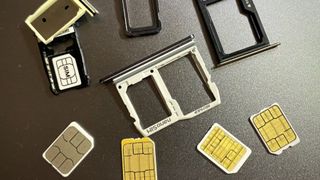
At a glance 1. Best overall 2. Best for short stays 3. Best budget 4. Best non-MVNO 5. Best prepaid data plan 6. Best data-only plan FAQ
Whether you're going on a quick vacation or moving for good, it's never a bad idea to invest in one of the best prepaid SIM cards so you can stay in touch with friends and family back home. If you're having trouble choosing among all of the options that are out there, fear not: we've gathered all of the best prepaid SIM cards for travelers so you don't have to worry.
As long as your Android phone is unlocked for international use and compatible with local networks, such as T-Mobile, Verizon, and AT&T, ordering a SIM card online or through a nearby retailer should be simple.
Keep reading for all of the best prepaid SIM cards for U.S. travelers and tourists alike. If you want to go even deeper, you can also check out our guide to the best MVNO carriers or save some cash with the best MVNO deals of the month.

From $15 at Mint Mobile
Soon to be owned by T-Mobile, a Mint Mobile SIM is a perfect choice if you're staying in the U.S. for three months or longer, with unlimited talk/text, a mobile hotspot, and more.
Read more below.
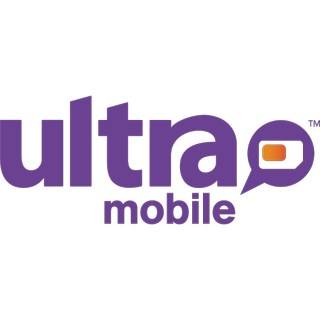
From $19 at Ultra Mobile
The Ultra Mobile 3GB plan gives you a month of unlimited talk and text to over 90 countries worldwide on T-Mobile, up to 3GB of 5G/4G LTE data, and free Wi-Fi calling.
Read more below.

From $15 at Lycamobile
If the ability to call abroad is your main focus, all Lycamobile plans come with unlimited talk and text to over 85 countries and a variety of data options.

From $30 at AT&T
Best non-MVNO
Choose AT&T Prepaid's 5GB plan for $30 per month and you'll get unlimited talk, text, and 5GB of data with 5G access and the ability to text over 230 countries for free.

From $40 at T-Mobile
T-Mobile's prepaid plan is a little pricey, but you get 10GB of data, a free mobile hotspot, and access to the world's largest 5G network.

From $35 at Cricket Wireless
If you only need data on your travels, Cricket's data-only plan offers a minimum of 20GB of high-speed data, as well as usage in Mexico and Canada.
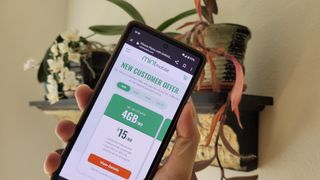

1. Mint Mobile
Our expert review:
Reasons to buy
Reasons to avoid.
Mint Mobile is one of the best MVNO carriers today and uses T-Mobile's 4G LTE and 5G network, making it a great prepaid SIM card to get if you plan on staying in the U.S. for at least three months. As we found in our Mint Mobile review , Mint's 5G connection is strong, and its phone compatibility is one of the best in the country.
With Mint, you need to purchase at least three months of service upfront. After that, the best deals are offered when you sign up for six months or 12. For three months on the unlimited plan, you'll pay $90 and get unlimited talk, text, and data, 10GB of mobile hotspot, and free calls to Mexico and Canada. Calling to other international locations is available at a per-minute rate but if you use an app to call your friends such as WhatsApp or Line, you'll only need data.
Joining Mint Mobile is easy, and you can even sign up for a trial online to get a free Mint Mobile SIM card . It's especially easy if your phone is eligible for an eSIM since you can then activate the SIM straight from your phone and later continue your service if you like it. You can also get a Mint SIM card from Target, Best Buy, Walmart, or Amazon.

2. Ultra Mobile 3GB
Ultra Mobile is an MVNO on T-Mobile's network, meaning that you'll get great T-Mobile coverage at a lower price. Our Ultra Mobile review showed strong coverage and speeds. Though Ultra Mobile offers its own set of prepaid plans, the Ultra Mobile 3GB plan is a perfect fit for anyone visiting the U.S. for a month or less.
This is a more traditional SIM and after 30 days, the plan will expire, making it great for users who just wanted simple talk and text to a wide range of destinations and don't need a lot of data on their travels. For $19 with the SIM kit included, you'll get unlimited talk and text to over 90 countries worldwide, plus free Wi-Fi calling and up to 4GB of 5G/LTE data, meaning you should have no issue reaching friends and family back home.

3. Lycamobile
Lycamobile is unique because it's a global MVNO, and in the U.S., it's an MVNO on T-Mobile's network. To check whether your phone is compatible, the easiest thing to do is type in your IMEI number on Lycamobile's website, but most GSM unlocked devices should work.
Lycamobile offers several plans to pick from and really caters to those who need unlimited nationwide talk and text and international calling and texting to 85+ countries. Each plan includes these features at no additional charge, making this the perfect plan if you're someone who wants to be able to call abroad whenever you want.
When it comes to data, you have multiple options starting at just 250MB and going up to 60GB. The cheapest 250MB plan costs $15, while the top unlimited data plan costs $59. The 2GB plan is only available to new customers so if you're already signed up, this plan will come with 1GB of data. Each plan includes slightly different bonus features, so you'll have to pick what makes the most sense for you.
Fortunately, Lycamobile SIM cards are pretty easy to get a hold of. They're sold online on Lycamobile's website and Amazon, but you'll also find Lycamobile SIM cards in several retailers, including 7-Eleven, pharmacies, local convenience stores, etc. When in doubt, you can also use the online store locator to find the nearest retailer near you.
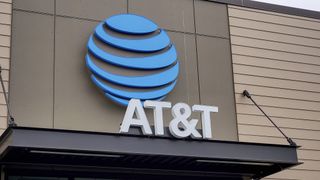
4. AT&T Prepaid
Known for its great coverage, AT&T is also an excellent carrier to consider getting a SIM card from when visiting the U.S. and one of the best prepaid phone plans . It tends to have better coverage in rural areas than other carriers, so it's also a great option if you plan to be on the road a lot. For $30 (plus taxes and fees), AT&T Prepaid will get you 5GB of high-speed data, which is then throttled to 128Kbps. As always, you should check your device's compatibility with AT&T online before signing up.
On this plan, you're able to use your mobile hotspot, and you can text to more than 230 countries. You'll also be able to talk, text, and use data in Mexico and Canada (though data speeds may be slow). And if you think you'll need more than 5GB of data, you can always upgrade to a 15GB prepaid plan for $40, which is a great deal and definitely worth considering.
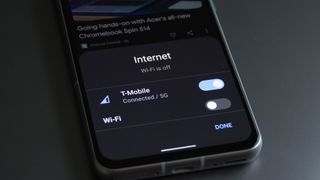
5. T-Mobile Prepaid
T-Mobile not only offers some of the best cell phone plans you could get today, but it also has an excellent prepaid option that will suit most travelers and tourists needs when visiting the U.S. Because T-Mobile's network has improved vastly over the past few years and its 5G network has some of the most expansive coverage and fastest speeds in the nation, you'll likely get excellent service with T-Mobile when traveling to major cities during your stay.
There are four T-Mobile prepaid plans from which to choose, though the ideal plan for most visitors will be T-Mobile's 10GB prepaid plan for $40 per month. This plan includes unlimited domestic talk and text, up to 10GB of high-speed data, free mobile hotspot data, and a music unlimited feature so that any music you stream won't eat up your data. If you want to add international calling, you can do so for $15 extra, or if you're traveling to Mexico or Canada for a few days, you can add talk, text, and 5GB of data to use over there for an extra $5.
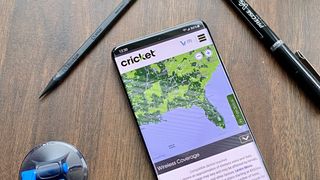
6. Cricket Wireless
If you don't think you'll need minutes during your stay in the U.S. and really just want data, you could consider a data-only plan from Cricket Wireless , which is an MVNO on AT&T's network. For $35, you'll get 20GB to use during the month, or for $55, you'll get 100GB.
Again, this plan doesn't come with any minutes, so you'll have to be sure you're fine using apps like WhatsApp, Facebook Messenger, or Skype to connect with family or friends. It does come with text and picture messages across the U.S., as well as usage in Mexico and Canada if you plan on visiting those countries as well. It's the perfect plan for anyone who will be spending lots of time on the road and wants to be able to stream, download, and do some high-speed browsing.
You can get a Cricket SIM card by going into a Cricket Wireless authorized retailer, which you can locate with Cricket's online store locator. Other popular retailers such as Amazon, Target, Best Buy, and Walmart will also sell Universal SIM card activation kits for Cricket Wireless. The good news is that if you do end up wanting minutes, you can always switch to another one of Cricket's plans with the same SIM card.
Back to the top^
Which prepaid SIM card is best for you?
Why you can trust Android Central Our expert reviewers spend hours testing and comparing products and services so you can choose the best for you. Find out more about how we test .
You really can't go wrong with a prepaid SIM card on T-Mobile or AT&T's network while visiting the U.S., and the right fit for you depends on the length of your stay and whether you need features like being able to call back home. If you're traveling for only three weeks or less, the Ultra Mobile 3GB plan is the best choice and offers just enough talk, text, and data to stay connected.
On the other hand, if you'll be in the U.S. for a few months, Mint Mobile will give you the best multiple-month value. And if you're somewhere in between, a prepaid plan from either T-Mobile or AT&T is easy, reliable, and guaranteed to give you great coverage.
Should you use your current carrier's add-ons?
Many carriers have partnerships with international carriers to offer greater service to their own customers. Luckily, this often goes both directions and means there may be a plan add-on that can give you plenty of data without needing to set up and activate a new SIM. While these travel add-ons can be quite pricey, the simplicity of this option will make it worth it to many people. It also gives you the chance to have a connection if you're waiting for a connecting flight in another country.
What about eSIM apps?
Another emerging option is eSIM apps. These apps can use your phone's built-in eSIM slot to quickly activate and pay for a phone plan without needing to remove your old SIM or worry about shipping a physical SIM in the first place. Airalo , for example, allows customers to buy as little as 1GB for a week. If you just need enough data to get around in a new city, this is a good option. It works with Google Pay, credit card, PayPay, and even Alipay.
If you have an iPhone, there's even an official T-Mobile Prepaid eSIM app that accepts credit card payments from a number of countries. Regrettably, this app isn't available on Android though there are still other eSIM providers on the platform.
Just be sure to confirm compatibility before taking off. Still, there are other apps available on Android that offer solid deals on data without contacts or physical SIMs necessary.
- MVNO deals: Mint Mobile | Visible | Boost | Tello | Cricket
Be an expert in 5 minutes
Get the latest news from Android Central, your trusted companion in the world of Android

After almost a decade of working in the e-commerce space, Patrick Farmer (he/him) began his career at Android Central as a Deals and Commerce Writer before moving into a new role as AC's eCommerce Editor in 2023. When he's not hunting down the best deals and offering shopping advice for our readers, you'll often find him listening to music, camping out at a brewery, or treating his cat like a human child.
- Samuel Contreras
- Olivia Lipski
Budget carrier TextNow launches a lineup of unlimited plans — starting at just $0.99!
Verizon phone insurance: Everything you need to know
Google Chrome is getting a paid version with top-notch security features
Most Popular
- 2 Leaked Google Pixel 8a renders show off the phone in four colors
- 3 YouTube Music is rolling out a new Activity notifications feed for Android and iOS
- 4 The Motorola phone that we called 'fantastic' and 'flagship-level' is selling for only $250 at Best Buy today
- 5 These Meta Quest games are channeling Wii Sports in the best way
MASTERCARD BENEFIT INQUIRIES
Within the U.S.: 1-800-Mastercard (1-800-627-8372) | Outside the U.S.: Mastercard Global Service Phone Numbers
Availability of insurance benefits on your card may vary by card issuer. Please refer to your issuing financial institution for complete insurance benefit coverage terms, conditions and exclusions.
*Card registration required. Certain exceptions apply. Click here for terms and conditions .
†Requirements may vary. See card packaging for details or contact card issuer.
Best contactless credit cards: Tap to pay

Update: Some offers mentioned below are no longer available. View the current offers here .
Contactless credit cards are cards that don't require you to insert your card chip when you make a purchase. These cards use EMV chip technology (chip security developed for Europay, Mastercard and Visa but now used by many cards) with NFC (near-field communication) for proximity payments. Cards with contactless capabilities can be used like a standard chip credit card or for "tap-and-go" payments similar to Apple Pay and Google Pay purchases.
Back in December 2018, TPG predicted that contactless cards would go through a growth period in 2019. That hunch turned out to be true, but 2020 has been another year of growth as people have adopted contactless tech to help minimize risk of spreading COVID-19. The technology is certainly not new to the international marketplace — contactless cards have been in use in much of Europe and Australia for years. However, they've been slow to catch on in the U.S.
Most major credit card issuers in the U.S. have started (if not completed) the switch to contactless cards. We would guess that in the next year, pretty much any credit card will have the option for cardholders to go contactless. In the meantime, here's a list of our favorite cards with tap-and-go capabilities from each issuer.
American Express contactless cards
Featured card: american express® gold card.
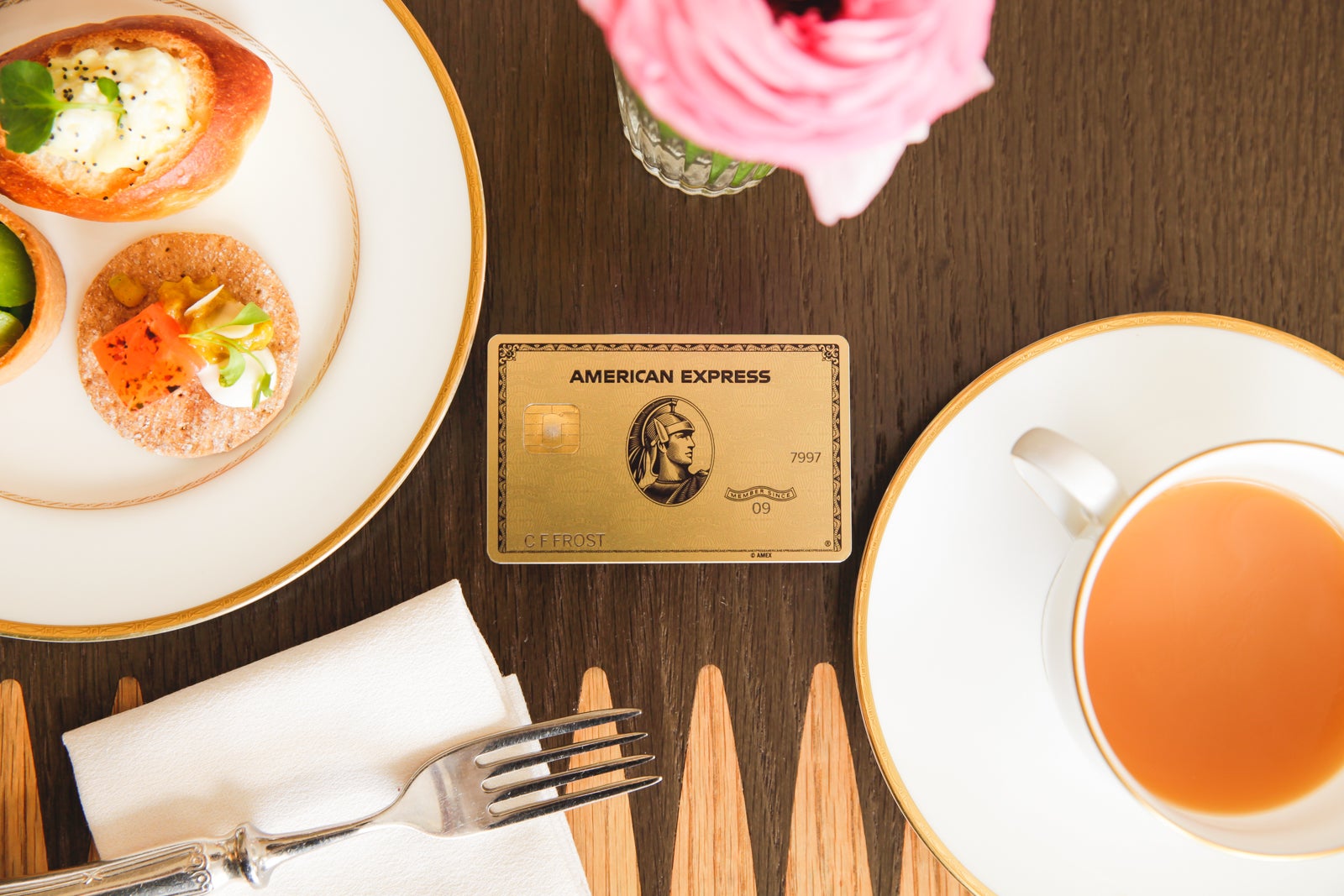
Rewards: You'll get 4x points on dining at restaurants and at U.S. supermarkets (on up to $25,000 per calendar year, then 1 point per dollar spent), 3x points on flights booked directly with airlines or through the Amex Travel portal, and 1 point per dollar spent on everything else.
Welcome bonus: 60,000 Membership Rewards points after you spend $4,000 in purchases within your first six months with the card. Some people are getting targeted online for a 75,000-point welcome bonus (check using the CardMatch tool ), but there is no guarantee that offer is available to everyone and it is subject to change at any time.
Annual fee: $250 (see rates and fees)
Why we love it: Although the Amex Gold sometimes is overlooked in favor of The Platinum Card® from American Express, it's still a knockout card. For those who are looking for contactless cards to use on everyday expenses, the Gold actually outshines the Platinum with its rewards structure. It's got something for just about everyone.
Families and foodies alike can rack up a lot of points with 4x points on dining at restaurants and U.S. supermarket spending. Frequent flyers are still getting 3x points on eligible travel. Plus, the card also offers some great perks: a $10 statement credit each month for Grubhub, The Cheesecake Factory, Goldbelly, Wine.com , Milk Bar and select Shake Shack locations. (which comes in handy when you first get to your destination and just want to order in and crash at your hotel), personalized travel service, access to The Hotel Collection (including a hotel credit of up to $200 back in statement credits each year on prepaid Fine Hotels + Resorts® or The Hotel Collection bookings, which requires a minimum two-night stay, through American Express Travel when you pay with your Platinum Card).
Other contactless cards from American Express:
- The Platinum Card from American Express
- Marriott Bonvoy Brilliant® American Express® Card
- Hilton Honors American Express Surpass® Card
- Hilton Honors American Express Aspire Card
- Hilton Honors American Express Card
- American Express Cash Magnet® Card
- American Express® Business Gold Card
- Hilton Honors American Express Business Card
- Amazon Business Prime American Express Card
- Amazon Business American Express Card
These cards come contactless-enabled by default. A representative from Amex confirmed that you can also request a contactless-enabled version of any U.S. consumer card by logging in to your account or calling the number on the back of your card.
The information for the Amex Cash Magnet, Hilton Aspire Amex card has been collected independently by The Points Guy. The card details on this page have not been reviewed or provided by the card issuer.
Bank of America contactless cards
Featured card: bank of america® premium rewards® credit card.
Rewards: Earn 2x points on travel and dining, plus 1.5x points on all other purchases. Existing Bank of America customers who qualify for the Preferred Rewards program can earn up to 3.5x on travel and dining, plus 2.65x on all other purchases.
Welcome bonus: You'll receive 50,000 bonus points after spending $3,000 in purchases in the first 90 days of account opening.
Annual fee: $95
Why we love it: If you qualify for the Preferred Rewards program with Bank of America , the Premium Rewards Card offers a lucrative earning potential for such a low annual fee. Most cards that offer annual travel credits cost hundreds of dollars in membership fees annually. For just $95, you'll get a solid earning rate (or a great one, if you are a Preferred Rewards member with Bank of America), an up to $100 airline incidental fee statement credit, a Global Entry or TSA PreCheck application fee credit (up to $100) and some nice travel protections.
Other contactless cards from Bank of America: Unfortunately, contactless cards are only available in select cities in the U.S., including New York, Boston and San Francisco, according to reports by Doctor of Credit. A few TPG team members have received new Bank of America cards in the mail that are contactless-enabled, but we haven't seen a widespread rollout for customers outside of these pilot cities.
Capital One contactless cards
Featured card: capital one venture rewards credit card.
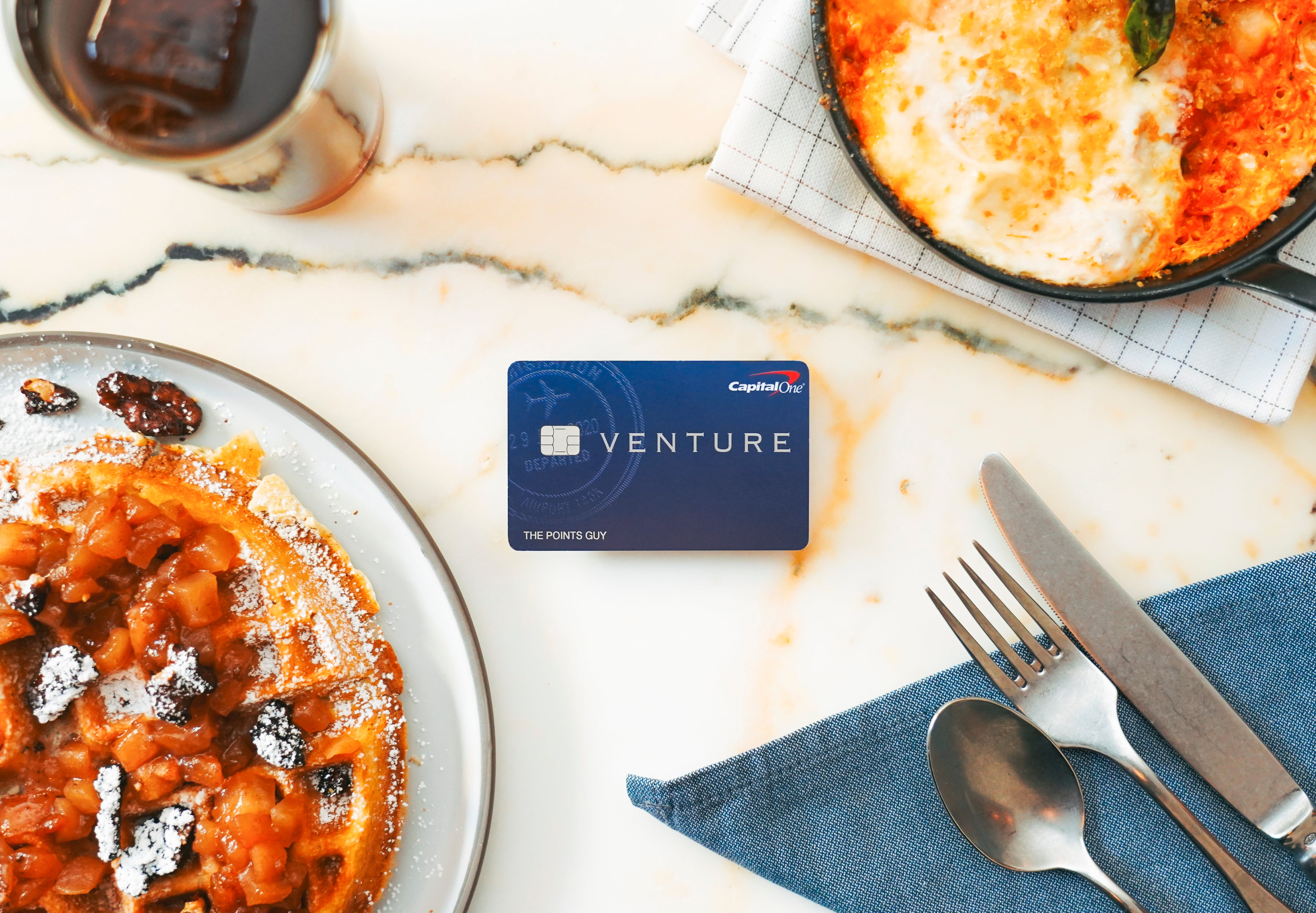
Rewards: You'll get 2x miles on every purchase.
Welcome bonus: Earn 75,000 bonus miles when you spend $4,000 on purchases in the first three months from account opening.
Why we love it: The Venture offers a simple way to rack up a lot of miles on everyday purchases. It's a great beginner travel card that also comes with some nice perks, such as a statement credit for your Global Entry/TSA PreCheck application fee (up to $100) — a feature you don't find on many mid-tier travel cards.
Other contactless cards from Capital One:
- Capital One VentureOne Rewards Credit Card
- Capital One Savor Cash Rewards Credit Card*
- Capital One SavorOne Cash Rewards Credit Card
- Capital One Quicksilver Cash Rewards Credit Card
- Journey Student Rewards from Capital One*
*The information for these cards has been collected independently by The Points Guy. The card details on this page have not been reviewed or provided by the card issuer.
Chase contactless cards
Featured card: chase sapphire preferred card.
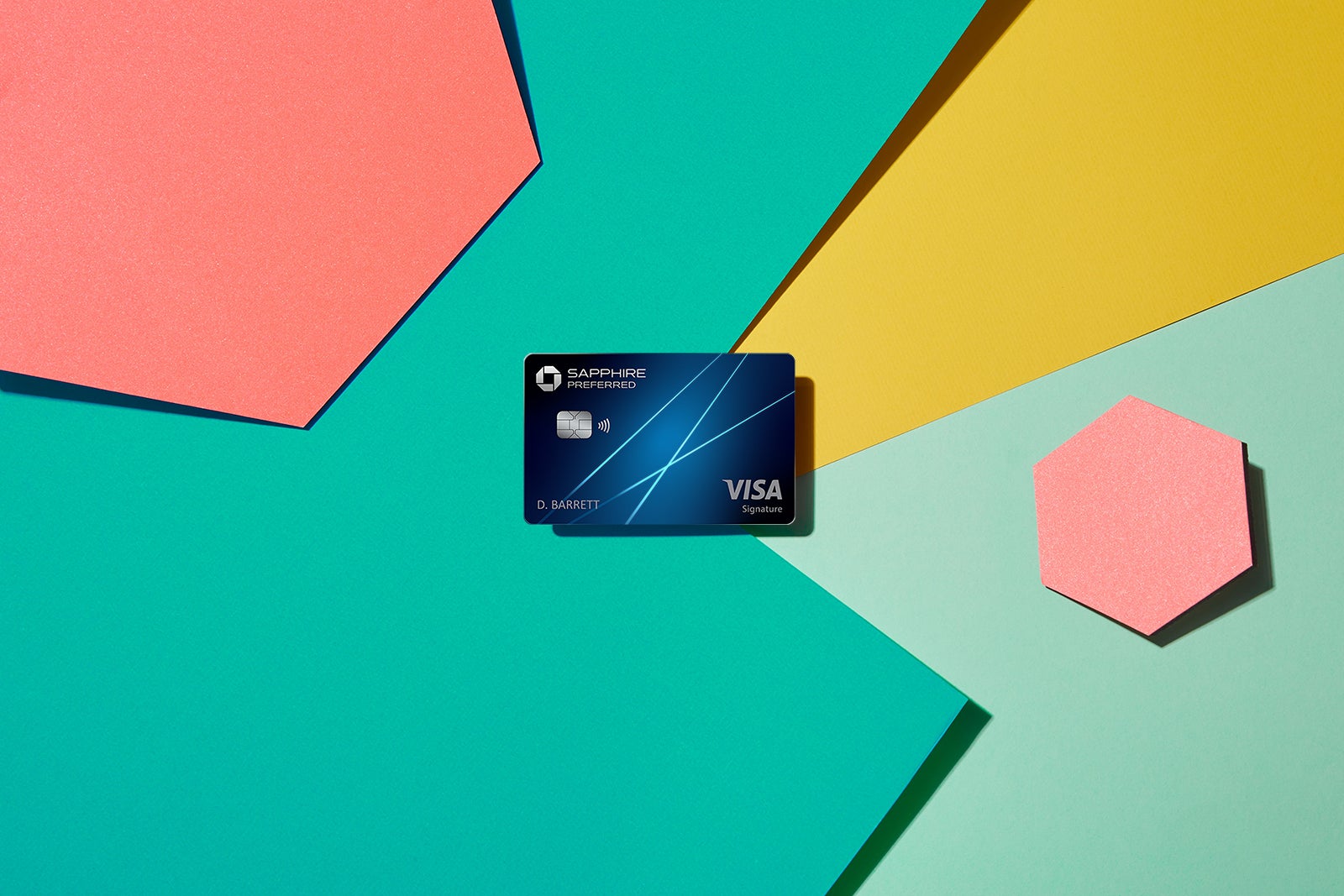
Rewards: Earn 5x total points on all travel purchased through Chase Ultimate Rewards, 3x points on dining, including eligible delivery services, takeout and dining out, 3x points on select streaming services, 3x points on online grocery purchases (excluding Target, Walmart and wholesale clubs), 2x points on all other travel, 1x point on all other purchases
Welcome bonus: Earn 60,000 bonus points after you spend $4,000 on purchases in the first three months from account opening.
Why we love it: This is my favorite travel rewards card. It's got an awesome welcome bonus offer right now and Chase Ultimate Rewards are incredibly valuable compared to most other loyalty currencies. Chase defines both travel and dining very loosely, which means you can hit those bonus categories for a number of purchases that would earn only 1 point per dollar spent with other cards. If you're looking for a solid beginner travel card to help you get started in the points-and-miles game, it's hard to beat the CSP.
Other contactless cards from Chase:
- AARP Credit Card from Chase*
- Amazon Rewards Visa Signature Card*
- British Airways Visa Signature Card
- Chase Freedom* (No longer open to new applicants)
- Chase Freedom Unlimited
- Chase Sapphire Reserve
- Chase Slate Credit Card*
- World of Hyatt Credit Card
- Ink Business Unlimited Credit Card
- Ink Business Cash Credit Card
- Ink Business Preferred Credit Card
- Marriott Bonvoy Boundless Credit Card
- Southwest Rapid Rewards Plus Credit Card
- Southwest Rapid Rewards Premier Credit Card
- Southwest Rapid Rewards Priority Credit Card
- Starbucks Rewards Visa Card*
- United Explorer Card
- United TravelBank Card*
- United Club Infinite Card
Citi contactless cards
Featured card: citi rewards+® card.
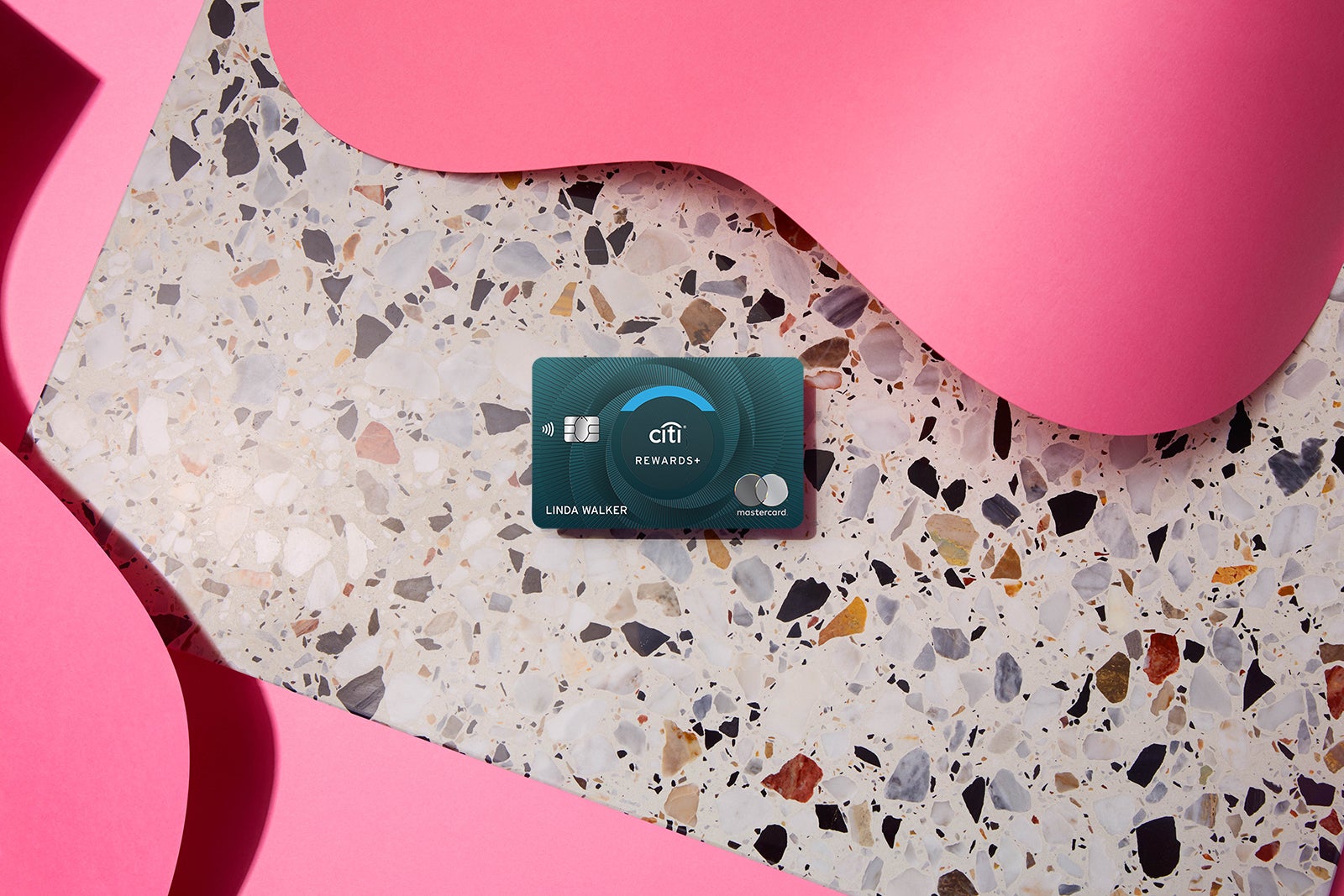
Rewards: Earn 2 ThankYou points per dollar at supermarkets and gas stations (on the first $6,000 spent annually, then 1 ThankYou point per dollar spent), and 1 point per dollar spent on all other purchases. Plus, your rewards are rounded up to the nearest 10 on every purchase.
Welcome bonus: Earn 20,000 ThankYou bonus points after you spend $1,500 on purchases with your card within the first three months of account opening. .
Annual fee: None
Why we love it: The round-up feature is something no other credit card offers. This is an excellent card to pair with the Citi Premier® Card or Citi Prestige® Card . You can easily rack up points on small, everyday purchases (where a contactless card is most beneficial), and then transfer them to your Citi Premier or Prestige account so you can maximize their redemption value. I got this card in February just to use on small purchases — my daily iced latte and in-app purchases, mainly. It has lived up to my expectations.
The information for the Citi Prestige has been collected independently by The Points Guy. The card details on this page have not been reviewed or provided by the card issuer.
Other contactless cards from Citi:
- Citi® Double Cash Card
- Citi Premier® Card
- Citi Prestige® Card
Wells Fargo contactless cards

Featured card: Wells Fargo Propel American Express® card*
Rewards: 3x points on dining, gas stations, ride-hailing, transit and travel (which includes flights, hotels, homestays and car rentals), and 1 point per dollar spent on other purchases.
Welcome bonus: N/A
Why we love it: For a no-annual-fee card, the Propel has a great rewards structure. Those who live in the city and spend a lot each month on ride-hailing services and transit will be hard-pressed to find a card that offers a better return on those purchases. Beginners who don't travel often, but want the option to redeem at a decent rate for travel will find a lot of value with the Propel.
The Wells Fargo Propel card is no longer available for new applicants. The information for this card has been collected independently by The Points Guy. The card details on this page have not been reviewed or provided by the card issuer.
Other contactless cards from Wells Fargo. A representative confirmed that all Wells Fargo cards are now contactless-enabled, including:
- Wells Fargo Cash Wise Visa® card*
- Wells Fargo Visa Signature® Card*
- Wells Fargo Rewards Card*
- Wells Fargo Platinum Card*
- Wells Fargo Cash Back College Card* (Note: you must have an existing Wells Fargo relationship to apply for this card online)
- Wells Fargo Secured Credit Card*
What are the benefits of contactless cards?
The most obvious benefit of using contactless cards — both for consumers and retailers — is speed. A transaction that might take 30 seconds by inserting an EMV chip only takes an average of 15 seconds when you go contactless. This saves time and lets retailers serve more customers in a day.
But there is also physical safety to consider, too. As more people are looking for ways to minimize touchpoints in their day-to-day lives to help prevent the spread of COVID-19, contactless payment methods are becoming increasingly common.
The U.S. has been behind the curve on adopting contactless payments, mainly because U.S. retailers have been slow to switch their point-of-sale terminals and hardware to accept them. However, as mobile payment options have become more popular, retailers are upgrading their systems to accommodate contactless payments.
On the consumer side, there was concern about security. A common misconception about NFC payment technology is that it's easy for thieves to steal your credit card information by getting close to your card with a reader. The reality is that contactless payments are just as secure as if you insert your chip into a reader.
Each transaction produces a one-time code rather than the same info being sent each time you pay, so someone wouldn't be able to steal your card information for future transactions even if they got close enough to your card with a reader (which is unlikely).
Bottom line
As more Americans recognize the benefits of using both mobile wallets and contactless cards, more issuers are rolling out more cards with contactless capabilities. Don't be surprised if you get a contactless-enabled card when you renew or apply for new credit cards from these issuers.
Additional reporting by Max Prosperi and Liz Hund.
For rates and fees of the Amex Gold Card, click here.
Updated on 5/3/21.
We’re on the road right now – join in on the fun and follow @thebrokebackpacker on IG!
- Meet the Team
- Work with Us
- Czech Republic
- Netherlands
- Switzerland
- Scandinavia
- Philippines
- South Korea
- New Zealand
- South Africa
- Budget Travel
- Work & Travel
- The Broke Backpacker Manifesto
- Travel Resources
- How to Travel on $10/day
Home » Budget Travel » best international sim cards
9 BEST International SIM Cards for Travel (Buyer’s Guide • 2024)
SIM cards are a royal pain in the butt when travelling. Every time you land somewhere new, you have to perform the same song and dance of going out of your way to get a new sim pretty much as soon as possible.
Usually what happens is that you land in the airport and then you either get ripped off buying a SIM card there or navigate to town without any connectivity. Once you’re in town, you have to navigate a foreign city sifting through local SIM providers, various plans, and also probably getting lost along the way. It’s not the ideal way to start a vacation and I cannot even count the hours I’ve lost shopping for sims in new countries.
That’s why buying one of the best international SIM cards is THE way to go.
An International SIM card is one which will work all over the world meaning that you never have to change it again – no more messing around at the O2 Kiosk in strange airports!
Now, to set the record straight, while there are cheaper travel SIM cards in existence, they still aren’t exactly cheap. Nine times out of ten, a local SIM card is always going to be the cheaper option for budget backpackers.
Maybe you’re a digital nomad who always needs to be connected, maybe you’re a high-flying businessperson with fancy business attire who makes busy business calls while on holiday or maybe (like me) you are just sick of having to change sims.
Either way, this is the list of the best international SIM cards on the market! I’ve done all the leg-work and the research to deliver an international SIM cards review in full. So let’s get ourselves connected.

Compare The Best International SIM Cards
What is an international sim card, the best sim cards for international travellers, international data sim cards for digital nomads, social media addicts, and tinder aficionados, a quick review of each sim card, frequently asked questions about travel sim cards, should you buy an international sim card.
This isn’t the whole roundup but it is my personal pick of the best international SIM cards worth looking into, each one serving a different niche.
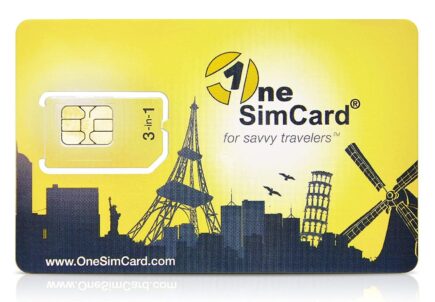
- > e-Sim and Traditional Sims available
- > Wide and reliable coverage
- > Low SIM-purchasing fees

- > Virtual sim – no plastic needed!
- > Excellent range of packages
- > Download before you leave home
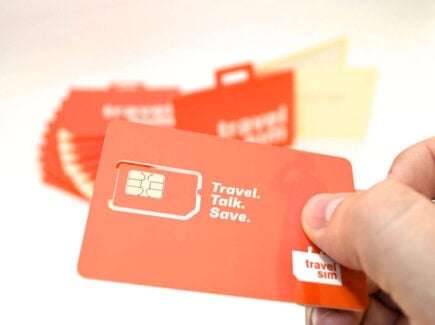
TravelSim Worldwide Card
- > Cheaper initial cost
- > Some cheaper rates for off-beat countries
- > No long-standing reputation
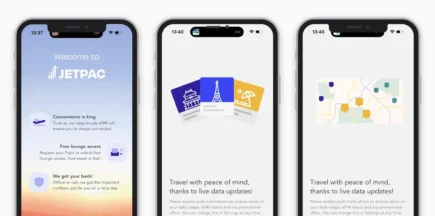
- > Excellent value – starts at $1
- > Range of packages available
- > Great coverage
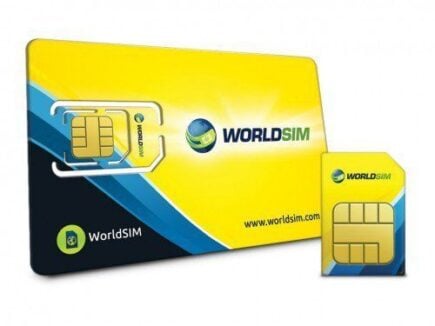
KeepGo Lifetime World SIM Card
- > Reliable connection
- > Prone to cutting rates
- > Coverage could be better
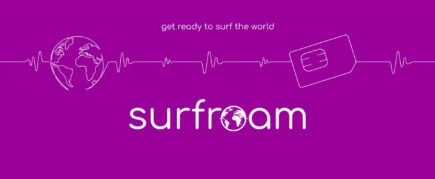
Surfroam SIM Card
- > Simple rates – no bundle packs
- > Huge coverage
- > Requires a PRO account for maximum coverage
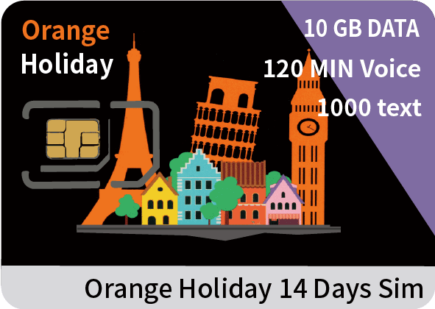
Orange Holiday Europe Prepaid SIM Card
- > Extremely reliable in Europe
- > Easily sufficient for a two-week holiday
- > Excludes a number of countries in Europe
International SIMs, roaming SIMs, travel SIM Cards whatever: a rose by any name can still order you a pizza when you don’t want to leave the guesthouse after all right? That’s what an international SIM card is, a SIM card that will have you hooked up from “anywhere” .
Why did you put ‘anywhere’ in quotes?
Because it’s a highly variable anywhere. “Anywhere” really means from the countries that the international SIM covers. That said, some of these travel SIM providers cover over 200 countries.
That also said, there are only 195 countries in the world so I’m not sure how they mathed those numbers out. Still unsure, have a look at our guide to local vs international SIM cards .

Looking for Best Coworking Hostel in the World?
Come visit Tribal Bali – Bali’s first specially designed, custom-built co-living hostel…
Bali’s most special backpacker hostel is finally open…. Tribal Bali is a custom-designed, purpose-built co-living hostel – a place to work, rest, play and stay. A place to find your tribe and hands down the best place in Bali to hustle hard and make new friends…
So, how does an international SIM card work?
Without getting too technical, an international SIM card isn’t programmed to one specific network. It’s programmed to operate on a number of networks in a number of different geographical locations – specifically, networks using the GSM (Global Systems of Management Communications) framework.
That’s why to use your cell phone internationally with a travel SIM card it needs to be:
- GSM-compatible (many phones are).
- Unlocked, i.e. not tied to a provider.
Do be sure about that unlocked phone bit before you go ahead and buy a new one.

Basically, global SIM cards will plug into a local network from the country you’re travelling to… Consensually, of course.
That’s why coverage so strongly varies among the many international SIMs. Some SIM cards are for worldwide use and programmed accordingly. Some SIM cards are for international roaming in certain regions like Asia, the USA, or Europe (usually, omitting a third of Europe in their coverage).
For example, you’ll need a different sim card for Canada and the USA in most cases, but in Europe you’ll more than likely be able to use the same one.
Who benefits from buying an international SIM card?
Well, like I said, not so much the longterm backpacker types . A local SIM card is pretty much always cheaper and much more practical (and reliable) for long stays in any country. Unfortunately, actual cheap international sim cards don’t exist yet.
Country-hoppers , on the other hand, may want to consider buying some sort of prepaid international SIM card. Buying local sim cards in Europe for only 1-2 weeks of use eight times in a trip is nobody’s idea of fun, especially if you care about data usage and double especially if you care about plastic ending up in the ocean.

People living the digital nomad lifestyle may also benefit from a travel SIM. Though a local SIM is much more equipped for longterm stays in a country, sometimes the options or service is crap and sometimes you’ll spend long stretches in transit which is a perfect time to crunch out a few hours. Besides, there is no rule that says you can’t have two SIMs. A prepaid international sim card might be the best option here (more about that later).
Lastly, business people or people that take frequent short trips will benefit from a SIM card for international travel. I might be stereotyping here but I kinda feel that these folk are less concerned with the costs associated. Plus, most SIM cards for overseas use tend to have 1-year validity for purchased credit, so it’s totally viable to park your SIM after a trip and then pop it back in for the next one.
Beginning the list are the top international SIM cards for travelling that do everything a SIM card should do: call, texts, and mobile data . These SIMs have some pretty major coverage globally and for most travellers in the world, are more than sufficient.
Of course, there has to be a best-of-the-best in this international sim card comparison. So first up–the best travel SIM card!
#1 The Best International Physical SIM Card – OneSim
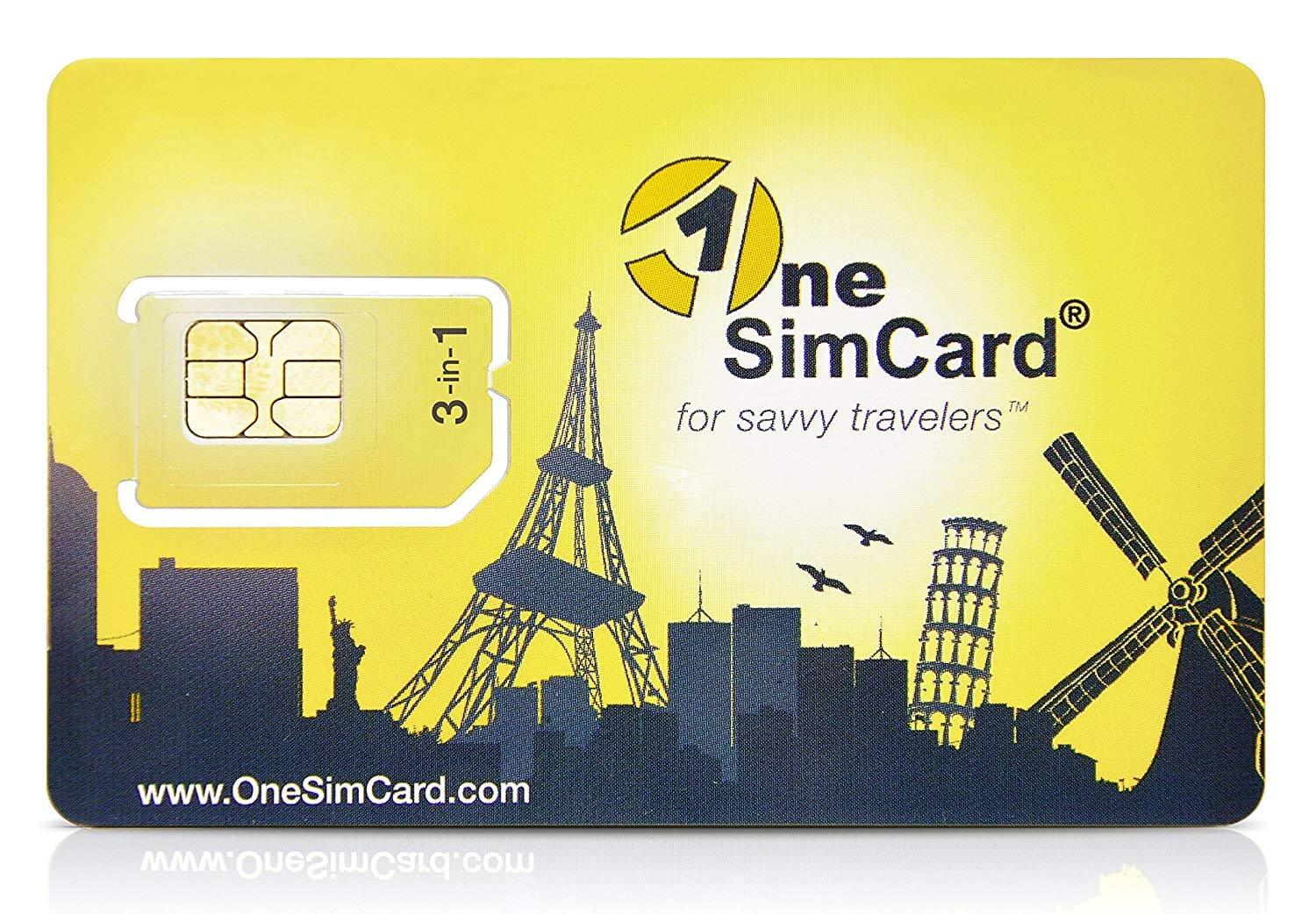
Ok, so what makes OneSim the best travel SIM card? It’s a fine difference between the first few candidates but OneSim edges out on top for a combination of versatility, pricing, and reliability.
First up, they offer multiple different SIM cards each catering to different travelling needs INCLUDING (but not limited to) 2 awesome e-Sim options :
- OneSimCard e-Sim World (From $9.95) – Coverage of 150 countries with free incoming calls on EU numbers.
- OneSimCard e-Sim Asiana (From $9.95) – Specially designed for Asia and Oceania. Data packages available.
If your phone is not yet e-Sim ready, then worry not because OneSim also offer some excellent deals on plastic sims:
- OneSimCard Universal ($29.95) – Coverage of over 200 countries but with a more limited data service (50+) countries.
- OneSimCard Expedition ($34.95) – Offers much the same coverage as the OneSim Universal travel SIM but with way more data coverage. It’s the choice for the explorers.
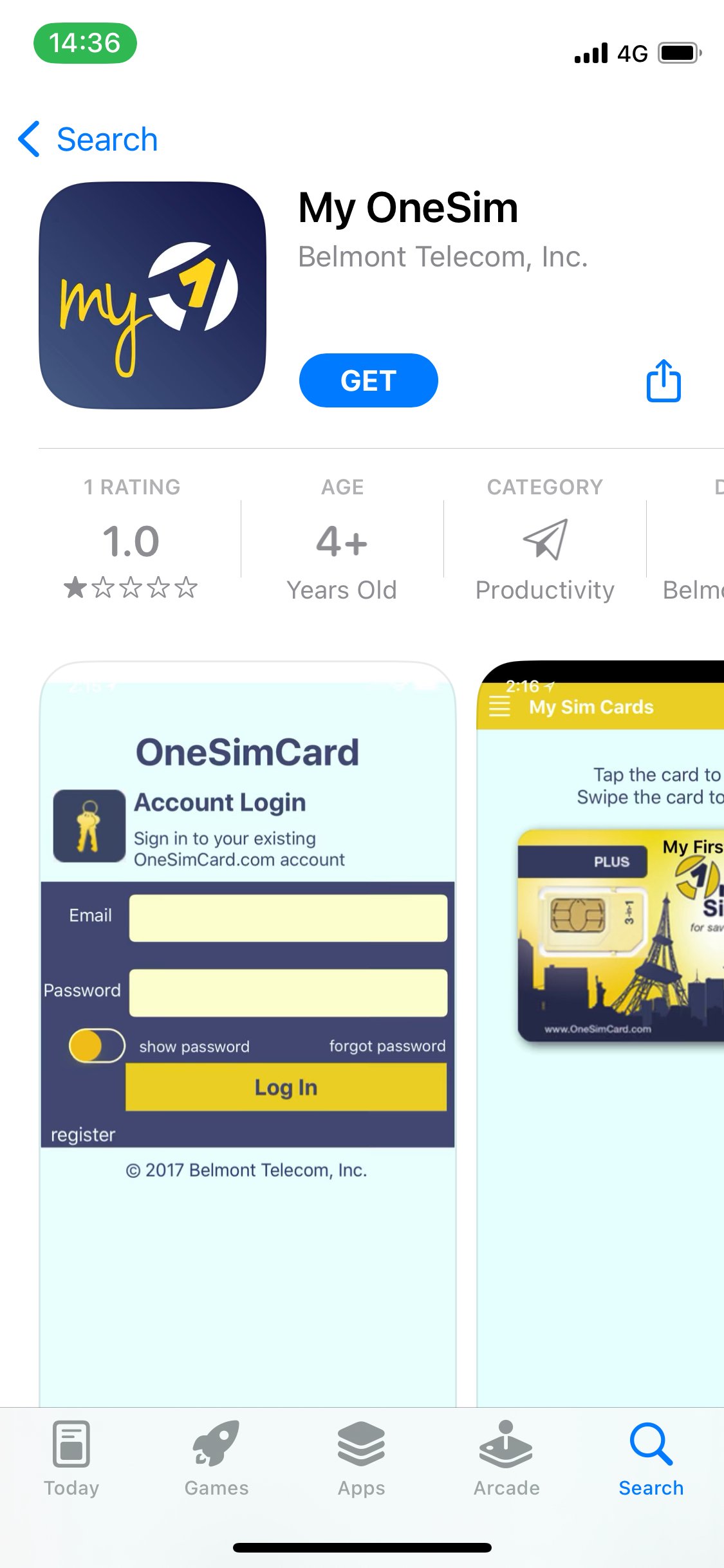
How OneSim Works
You’ll get a $10 bonus credit with any OneSIM roaming SIM card purchase, but once that’s gone, you’ll have to continue buying data plans. Rates vary wildly by both the choice of travel SIM card you are using and the country you’re in so you’ll need to check these rates to see if they suit you.
You’ll receive two numbers: a European (Estonian) number and a choice of one from the USA, UK, Australia, or Canada. Incoming calls on the primary European number is free in a large coverage of countries or starting from $0.25/min otherwise. Outgoing calls also start from $0.25/min (dependent on locations) and receiving texts are free.
Casual data rates start at rather hefty $0.20/MB . However, what makes this such a good prepaid international SIM card is that there is a lot of choices to lower your costs. You can buy data bundles ranging from one/two weeks to a month divided by zone or region. There are also discount plans and bundles available for call rates. This makes the OneSIM one of the best international SIM cards for data as well.
So, is it worth it?
Although not strictly the cheapest international SIM card on the market, the wealth of choices means that you can tailor your SIM card to your world travel needs and minimize costs. The added bonus is that OneSim has been kicking around for a while so they know the market well.
They provide a reliable service, as well as a bunch of neat extras, to keep their clients happy chappies. If you’re looking for the best sim card for international travel, OneSIM is definitely one you should consider getting.
#2 Best Global eSim Provider – GigSky

If you have a modern phone (iPhone 11 , Samsung Galaxy S21, etc or above) it will probably be eSim compatible. This means that you don’t actually need a plastic SIM card but can simply download an eSim via GigSky the same way you would download an app.
When I first heard of eSim about one year ago, it was something of a niche product simply because most travellers were using phones and devices that were not eSim compatible. However that is changing fast and by 2024, an estimated 80% of travellers will use eSim. The eSim marketplace is a very exciting one and the providers are contently innovating to come up with some new, better, cheaper packages – according to our research, GigSk are currently leading the pack.
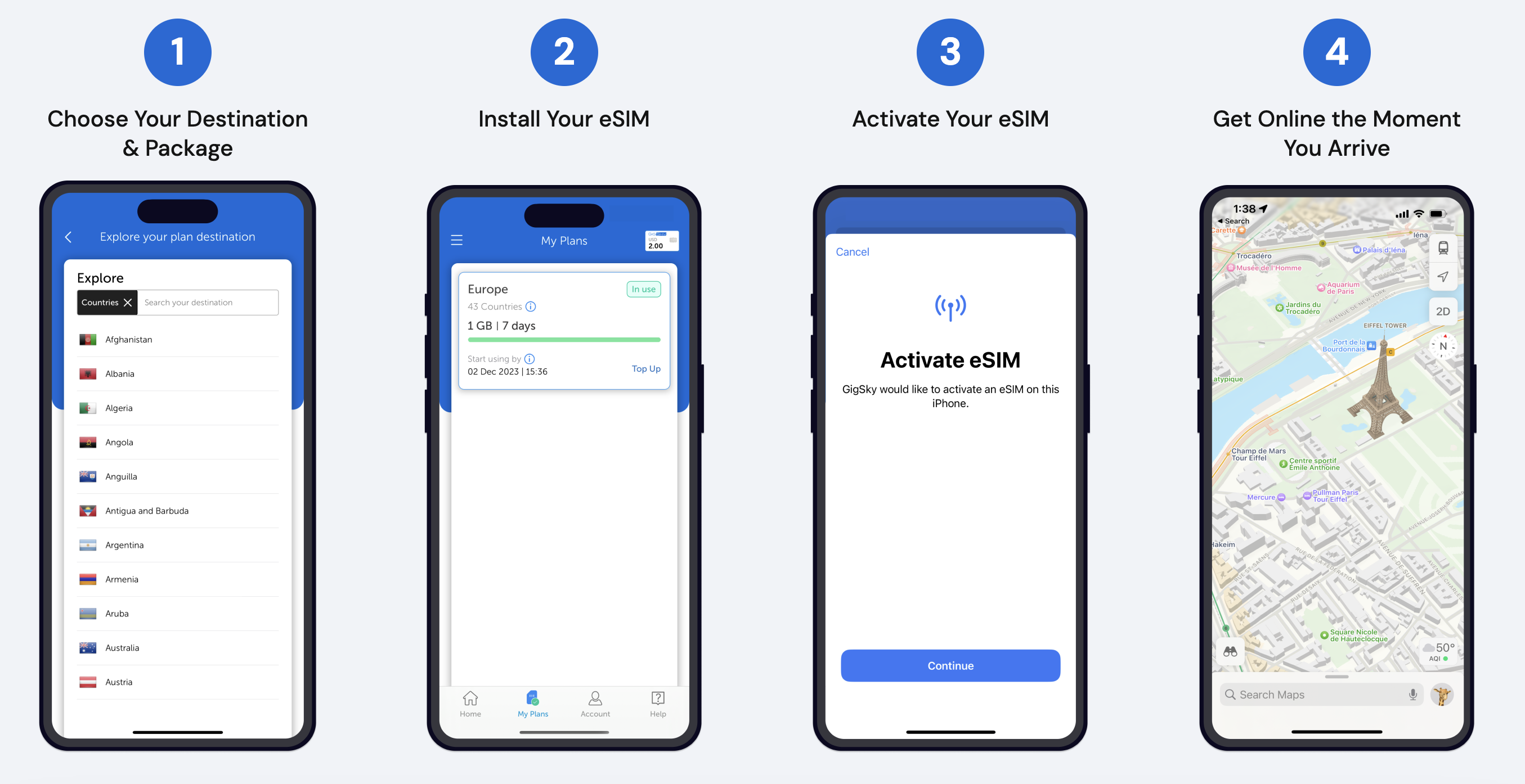
How GigSky Works
I had the pleasure of reviewing Gigsky and It’s really very simple. You either download the GigSky App (which we do recommend) or else go to their website and check out their “Global Plans”. You buy the package you want (in the 5GB World Plan) and download it not your phone BEFORE you fly, using either a link or a QR code.
The joy of eSim is that you can install it before you leave and then activate as soon as the plane touches down meaning you are rocking and rolling all over the world before you even get your luggage.
GigSky offer 1 Global Package only – 5GB over 30 days for $69.99. I can be topped up (if you somehow burn through all 5GB) but it cannot be extended past the 30 days.
So, Is It Worth It?
Well, $69.99 is a lot for a 30 day package but International Sim Packages do not come cheap. GigSky also have a wide range of global carrier partners meaning their offer better connectively than most platers in this space.
Overall though, in terms of sheer convenience yes GigSky is worth it – you you can browse for and install an eSim from the comfort your device and get it ready to use before you even leave home which saves a whole lotta hassle. However, the package does NOT include an actual phone number which is a bit of a bummer.
#3 Great Global eSim Package – Sim Local
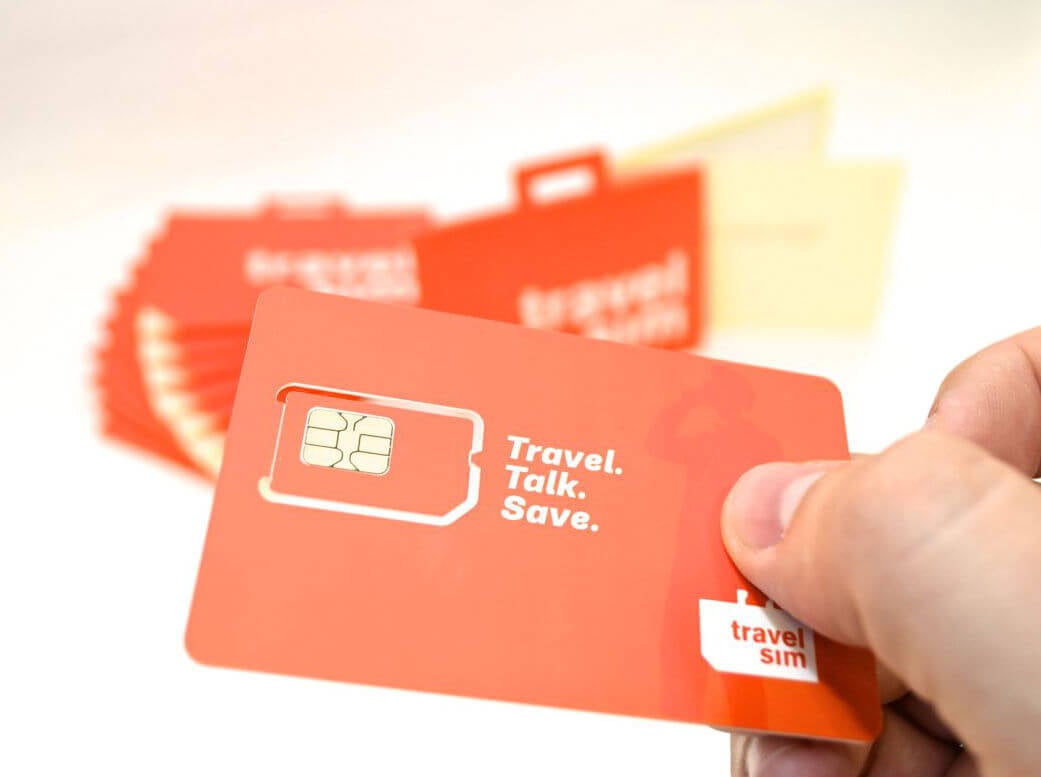
Sim Local is recognized as a global leader in the travel SIM card and eSIM retail market. The company specializes in serving global travellers, enabling them to stay connected while avoiding expensive roaming charges. During my review of Sim Local , I was impressed to see they provide local SIM cards and eSIM profiles directly to customers through a variety of channels, including retail stores, kiosks, vending machines, a mobile app, and an eShop.
Their services are aimed at offering significant savings on data, calls, and texts compared to traditional roaming options, and they also offer a range of mobile handsets and accessories tailored to the needs of travellers.
How Sim Local Works
First up, note that Sim Local are an eSim-only provider so if you’re phone is not eSim ready…go elsewhere. Providing it is, you simply hop over to their site or get the app and check out their global packages. At the time of writing the site offers their own brand one for just $10 for 3 days, or an Orange one that costs $28.00 for 14 days.
I’ll be frank, eSims are still often more expensive than buying physical sims but they are a lot easier to install and to operate and best of all, you can install them before you even leave home. In my view, $28.00 for 10GB of data over 14 days is good value for an international sim but bear in mind it don’t come with a local numero.
#4 A Worldwide SIM Card – WorldSIM
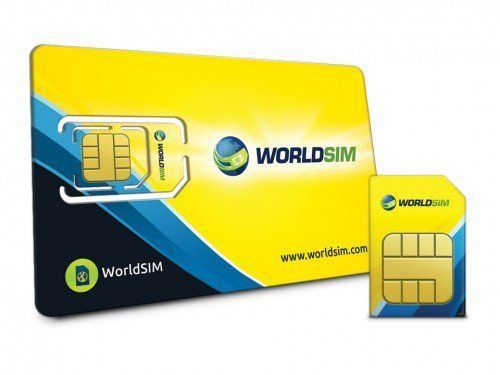
WorldSIM gets a mention on this list because it’s another puller in the market with some comparatively awesome rates. It’s also got some really weirdly expensive outlying rates. As such, we certainly don’t feel like it’s a fit for the best SIM card for international roaming.
How WorldSim Works
The WorldSIM international SIM card has no purchasing fee- woo! Now, before you get too excited, it does require a top-up of credit at purchase.
That means that you’re paying a minimum of $33.75 plus shipping . For $67.50 of credit, shipping is free.
The casual rates for outgoing calls, texts, and data usage are the cheapest I’ve found so far with data coverage extending to countries missed out on by OneSim. Except, a lot of the rates in various countries for incoming calls are shockingly high.
As for the data bundles? No idea. Their website isn’t working for that page and is just stuck in an infinitely loading loop.
Our gut says no. But, you do you. You shouldn’t base your decisions on buying an international SIM card on the gut instincts of a stranger online. All the same though, our gut says no.
Between the mildly bait-and-switch-y “$0” SIM purchasing fee, the janky and unwieldy website, and the weird incoming call rates that could potentially trap an unwitting consumer, WorldSIM in review doesn’t feel like an international SIM card worth purchasing, especially in comparison to other choices on the market.

REI is one of America’s biggest and most-loved outdoor gear retailers.
Now, for just $30, get a lifetime membership that entitles you to 10% OFF on most items, access to their trade-in scheme and discount rentals .
Are you turn-of-the-century generational that eschews actually phoning people online for commenting how much you miss them on their latest Insta post? What a coincidence – me too! Rather than risking being ripped off when buying a local SIM card, get your hands on an international data card instead.
These are the best international data SIM cards for those of us that scoot by without the extras.
#1 Best Data Only eSIM Card for International Travel – Jetpac
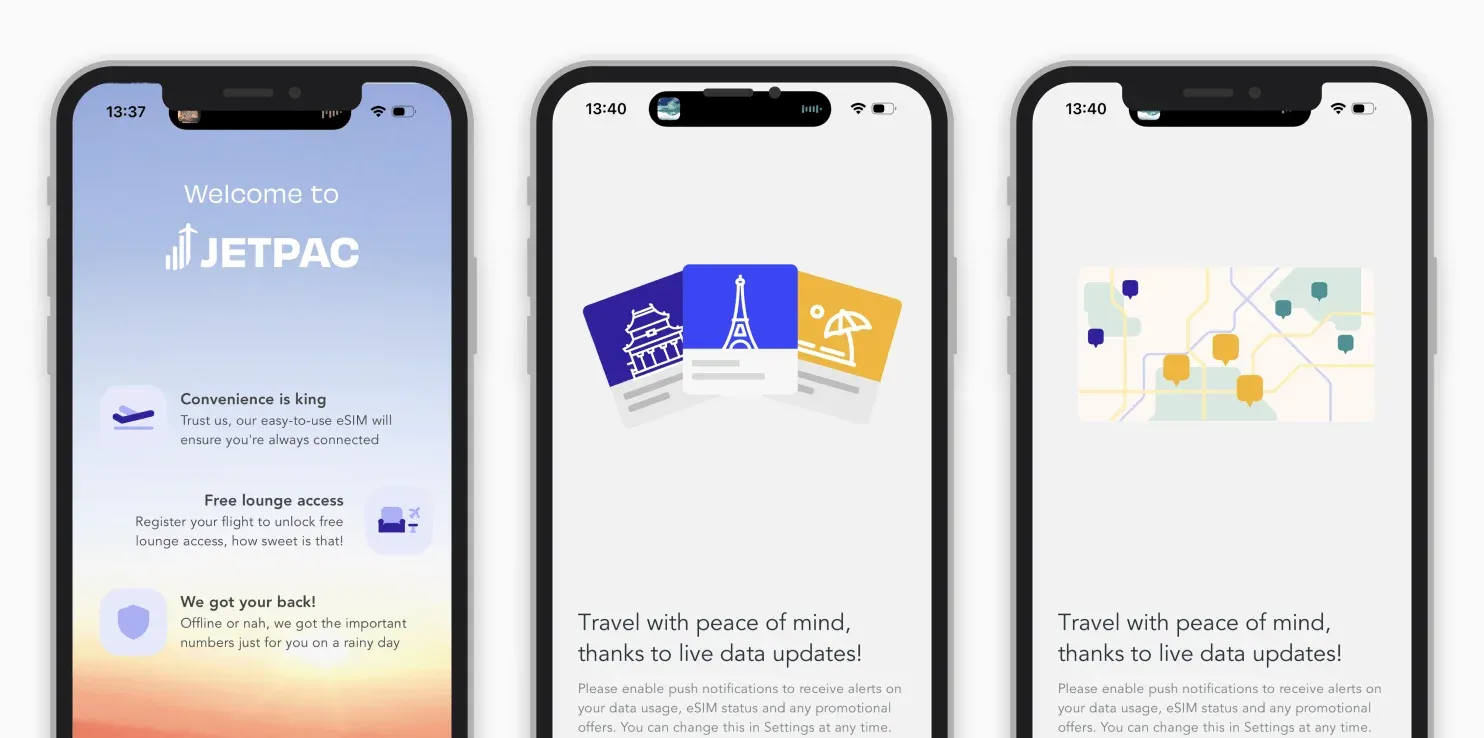
Jetpac is a Singapore based eSIM company who offer packages, designed primarily for travellers and Digital Nomads. They offer various data plans that can be used across many countries, and the service includes features like free airport lounge access if your flight is delayed.
Jetpac eSIMs are compatible with a range of devices, including many models from Apple, Samsung, and Google. To activate a Jetpac eSIM, users need to sign up on the Jetpac website or app, choose a plan that fits their travel needs, and then scan a QR code to install the eSIM on their device.
We love Jetpac for its ease of setup and reliable connectivity. JetPac makes it a handy tool for international travel, ensuring continuous access to mobile data across multiple destinations. While they don’t offer local numbers, we love that most of their packs last for 30 days by default so you can just concentrate on how much data you need.
How it Works
The Jetpac worldwide eSIM card comes in a variety of different data packages. Data can be topped up with a number of plans ranging from 100 MB up to a slammin’ 25 GB ! The prices of data top-ups are:
- 1 GB – $1
- 3 GB – $10
- 5 GB – $25
- 10 GB – $30
- 25 GB – $38
Absolutely. I mean, come on it starts at one-freaking-dollar and works all over the world. All in all we’d consider this one of the best pre paid international data only sim cards on the market.
#2 A Simple Data SIM Card for Worldwide Travel – Surfroam
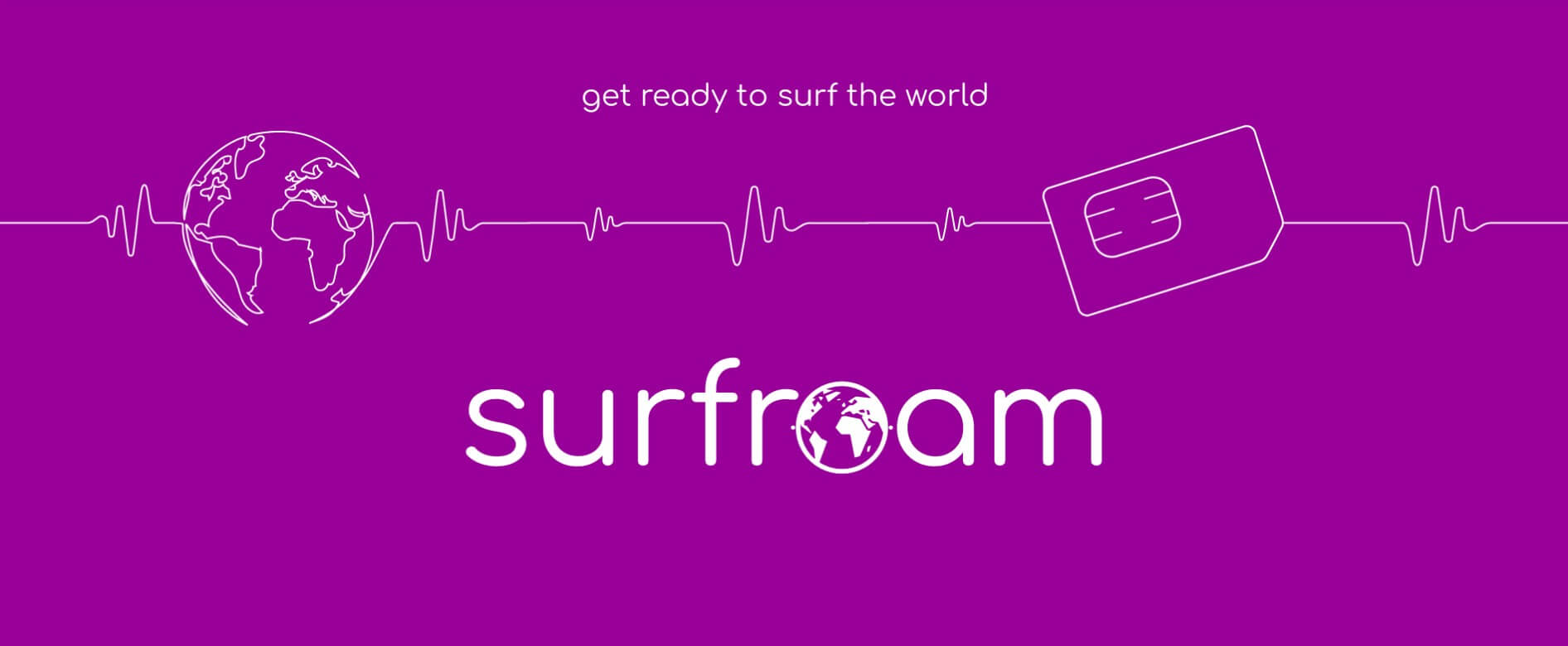
Yay! No prepaid data packages, no contractual mumbo-jumbo, no running out of data right when you settle in for a long Netflix and poop session: Surfroam keeps it Pura Vida!
It’s data-only with coverage of 200+ countries – even Afghanistan and Yemen are covered! So, what’s the go?
Essentially, you pay €45 for the physical SIM card (which includes €25 credit) and then top-up as you go with pack options starting at €25 . You’re charged a pay-as-you-go rate per megabyte starting as low as €0.01/MB . So that’s way cheaper than the KeepGo data roaming sim card, right? Not quite…
Rates vary substantially by country so while this going to be a cheaper option across, say, Europe, it may not necessarily pan out that way in other places. That said, prices are still pretty cheap for most places and tend to beat out KeepGo.
As a final note, there is an eSIM (€30) available with the same data rates.
Ok, so ‘simple’ might be stretching it upon reflection, however, once you’re away, its streams ablaze! If you’re jet-setting and changing countries a lot, you will need to stay keyed in as to the rates .
Otherwise, the coverage significantly beats out KeepGo, and in many cases, Surfroam will end up being the cheapest international data SIM card you can purchase. It’s the simplest choice for staying connected pretty much anywhere in the world.
#3 The Best International SIM Card for Europe – Orange Holiday Europe
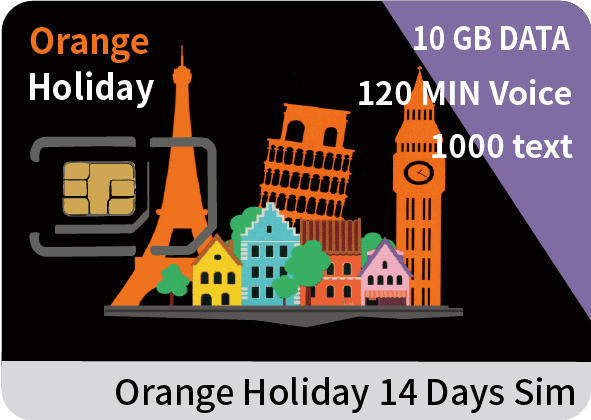
Are you just doing a little banger holiday in Europe and need a physical SIM card for your travels? Orange has got you covered. Specifically:
- Orange Holiday Europe SIM Card
- Orange Holiday Zen SIM Card
The Orange Holiday Zen is for light usage or a short trip. It’s a straight prepaid SIM card for travellers in Europe and it couldn’t be simpler.
For $27.29 , you get 8 GB of data, 30 minutes of calls worldwide, 200 texts, all lasting for 14 days before it expires. The Holiday Zen covers 30 countries in Europe including all the heavy-hitters, if you need a sim in Italy , Greece or Spain it’s perfect but it certainly doesn’t cover all of Europe (my boy Serbia – forever underrepresented). Still, this makes it one of the best European SIM Cards for travellers.
The Orange Holiday Europe takes all of that and just upgrades it: 20 GB in data, 120 minutes, and 1000 texts for $44 . The same coverage of countries applies and it’s a 14-day expiry again.
Orange also partners with a bunch of networks around the world- even offering an Israeli sim card called partner. If you take a look around their website, you can find more far-flung networks than you expected!
Both cards are able to be topped up online for more credit.
Yeah, so I wouldn’t call ‘30 countries in Europe’ an internationally roaming SIM card, but it is a super simple choice for anyone just travelling to Europe for a holiday. It’ll keep you safe in an emergency thanks to that fact that it’s not a data only service. Plus: you’ll have a SIM ready from the moment you land!
Orange is a pretty major sim provider in France so you’ll have a consistent connection. There’s no constant checking of rates calculators either. It’s just a perfectly simple prepaid SIM card for any travellers heading to Europe.
Y’all want more? Another option to look at is getting an Airalo eSim instead.

We’ve tested countless backpacks over the years, but there’s one that has always been the best and remains the best buy for adventurers: the broke backpacker-approved Osprey Aether and Ariel series.
Want more deetz on why these packs are so damn perfect? Then read our comprehensive review for the inside scoop!
Woo – a table for a final sexy summary!
Some commonly asked questions about the world’s best travel SIM cards…
How do I activate my international SIM card?
Each international SIM comes with detailed instructions on how to set up and load your SIM. It’s always a good idea to get things set up before you leave home to avoid any mishaps.
What does international SIM mean?
An international SIM is a type of SIM card that will allow you to use your phone internationally by connecting to global carriers. Some of these SIMs will allow you to make calls as you normally would, while others only offer data plans.
What is the best SIM card for international travel?
Some of the best SIMs for international travel include OneSim , Nomad , KeepGo , and TravelSim .
Do international SIM cards expire?
Most of the SIMs on this list require you to recharge at least once a year, but in doing so all your data will remain usable.

That depends on how you travel. If you’re adept at buying prepaid SIM cards locally when you hit the ground, then I wouldn’t worry.
However, for the people that an international SIM card suits the travelling style and needs of, then yes, definitely. I think if you’re that person, then you probably already know that you’re that person.
People looking for the all-round ol’ reliable, OneSim is the go-to choice of travel SIM cards. For those who want the best data SIM card they can use overseas, that choice is KeepGo .
Skip the lines and skip the painful errand days in a foreign city. Buy one of the best international SIM cards you can and have yourself connected before you even touchdown on the landing.
Want another kind of sim card? Check out the revolutionary new Nomad e-sim , an app-based sim card covering over 100 countries that can be organised before you leave home! If that’s not enough, there’s another new service from HolaFly which offers similar coverage and deals so check them both out and see which fits your needs best.
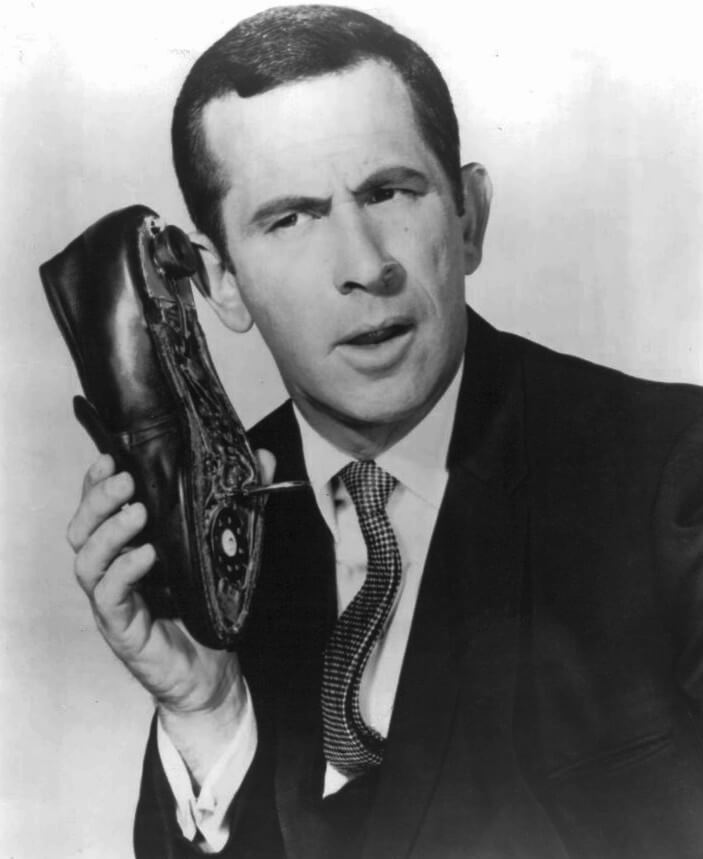
And for transparency’s sake, please know that some of the links in our content are affiliate links . That means that if you book your accommodation, buy your gear, or sort your insurance through our link, we earn a small commission (at no extra cost to you). That said, we only link to the gear we trust and never recommend services we don’t believe are up to scratch. Again, thank you!
Ziggy Samuels

Share or save this post

I think eSIMS are the future gamechanger here. You can download a digital SIM to your phone which has eSIM support.
I use a second phone to provide data to my main phone via bluetooth internet sharing. Wifi sharing can be used as well but bluetooth uses less power. On my main phone I leave the mobile data turned off and use the paired second phone for data. This allows me to use my main phone for Whatsapp, iMessage, email, etc.
10/10 review – exactly the type of info I was after. Plus, I liked your no BS style of writing. Thanks.
Thanks! Very useful! My main concern is regarding how long do the sim cards remain active if you are not buying credit regularly. I usually travel at least once or twice to congresses per year, but I wonder if some of these cards would stop working after a long time inactive. Is that information available for the cards discussed here? Cheers!
Heya, absolutely you can find that info! It’ll be in the terms and conditions/fine print for individual cards/plans. I’d like to say most last at least a year (which always seemed standard for SIM cards in general), but defs check that before you go buying any SIMs. Good question though!
You guys should definitely include DENT, a block chain based international E-Sim card, that offers flexibel data exchange. You can sell your unused data and always find the cheapest offer worldwide and cross boarder operational. Can’t be missed from this list!
Dude – hectic! I’m defs not about to go and update this article, but I looked and DENT seems pretty legit and totally worth the investigation. Anyone reading these comments, you’d be doing yourself a disservice by not scoping them out at least! 😀
Leave a Reply Cancel reply
Your email address will not be published. Required fields are marked *
Save my name, email, and website in this browser for the next time I comment.
Notify me of followup comments via e-mail.
Beginner’s guide to travel rewards: How to travel with credit card points and miles

Fortune Recommends™ has partnered with CardRatings for our coverage of credit card products. Fortune Recommends™ and CardRatings may receive a commission from card issuers.
Terms apply to American Express benefits and offers. Enrollment may be required for select American Express benefits and offers. Visit americanexpress.com to learn more.
When you read articles about travel rewards, you’re often regaled with tales of how the writer traveled in first class to Asia in a private suite drinking champagne for $5.60. You’re right to read that with skepticism. While using travel rewards, airline miles, and hotel points can allow you to travel well outside of your weight class, it’s well worth it to dig into the details before opening up a wallet-full of credit cards. Here’s how to enjoy the fruits of travel rewards responsibly.
Types of travel credit cards and how they work
Travel rewards credit cards—as opposed to cash-back credit cards or credit cards that don’t earn rewards at all—can generally be divided into the following three categories:
- Cards that earn flexible points.
- Cards that earn airline miles.
- Cards that earn hotel points.
We’ll delve deeper into the specifics of each type of card in the sections below.
Flexible travel credit cards
A credit card that earns flexible travel rewards is not tied to one specific airline or hotel chain. Instead, the points can be transferred to the loyalty programs of the airlines and hotel chains that your card offers as partners. Then, you redeem your points for flights or stays booked directly with the airline or hotel chain.
The Chase Sapphire Preferred ® Card is an example of a popular travel card that earns flexible points. This card comes with more than a dozen transfer partners and points transfer at a 1:1 rate (meaning each point you transfer from your credit card to a partner program nets you one airline mile or hotel point on the other end). Partners include United Airlines, World of Hyatt , and more.
Issuers of flexible travel cards may also provide a portal you can book travel through. For example, cardholders with the Chase Sapphire Preferred have the option of booking flights, hotel stays and more through Chase Travel℠, in which case each Chase Ultimate Rewards point (the rewards currency the card earns) is worth 1.25 cents.
If this is what you’re looking for, a card from our list of best travel credit cards might be a fit for your needs.
Chase Sapphire Preferred ® Card
Intro bonus.

Rewards Rates
- 5x 5x points on travel purchased through Chase Travel℠ (excluding hotel purchases that qualify for the $50 Annual Chase Travel Hotel Credit)
- 3x 3x points on dining at restaurants, including takeout and eligible delivery services
- 2x 2x points on travel purchases not booked through Chase
- 1x 1x points on other purchases
- 5x 5x points on Lyft rides through March 31, 2025 (that's 3x points in addition to the 2x points you already earn on travel)
- Valuable welcome bonus
- Extensive list of transfer partners
- Extra value on travel redemptions
- No premium travel perks
- Has an annual fee
- Additional perks: $50 annual hotel credit, trip cancelation/interruption insurance, auto rental collision damage waiver, complimentary Doordash and Instacart+ membership along with quarterly Instacart+ credits
- Foreign transaction fee: None
Airline-specific credit cards
An airline credit card is tied to a specific airline’s loyalty program, and earns miles you can use to book or upgrade flights with that airline and its partner airlines. For example, consider the United SM Explorer Card . The miles you earn with this card are deposited into your MileagePlus loyalty account, and you can redeem them to book flights on United Airlines or with United’s partners in the Star Alliance.
Cards of this type may offer airline-specific perks—such as free checked bags, priority boarding, an annual companion certificate, and more. If you fly a particular airline regularly, you could potentially save hundreds of dollars per year through the right card’s benefits.
If you think this is what you need, check out our list of best cards for earning airline miles .
Or if you already have an airline in mind that you’re loyal to, and just need help selecting a card for that specific airline, one of the following guides is likely to have what you’re looking for:
- Best American Airlines credit cards
- Best Delta Air Lines credit cards
- Best Southwest Airlines credit cards
- Best United Airlines credit cards
United SM Explorer Card

- 2x 2x miles on dining (including eligible delivery services), hotel stays, and United® purchases (including tickets, inflight food, beverages and Wi-Fi, Economy Plus® and more)
- 1x 1x miles on all other purchases
- Free first checked bag benefit.
- Expanded award availability on United Saver flights.
- No foreign transaction fee.
- $0 introductory annual fee for the first year (then $95) annual fee
- Subject to Chase 5/24 rule.
- United perks: 25% back on in-flight purchases checked bag benefit, expanded Saver award ticket availability
- Travel perks: TSA/Global Entry credit, trip cancellation and interruption protection
Hotel-specific credit cards
Hotel credit cards are tied to a specific hotel chain, such as Marriott, Hilton, Hyatt, etc. When you spend with these cards, they earn points that deposit into their respective loyalty program.
Often, when picking a hotel card, the perks matter just as much or even more than the rewards. For example, the right card might provide you elite status, a free night certificate, and statement credits you can use for certain expenses at eligible properties within the chain’s portfolio.
The Marriott Bonvoy Boundless® Credit Card illustrates these sorts of perks well. Cardholders get automatic Marriott Bonvoy Silver Elite status just for holding the card, as well as a Free Night Award every account anniversary good for properties worth up to 35,000 points per night.
If you’re looking for a card to help you earn almost-free hotel stays, check out our recommendations for best hotel credit cards . Alternatively, if there’s a hotel chain that is already your favorite home away from home, these specific lists may have what you’re seeking:
- Best Hilton credit cards
- Best Hyatt credit cards
- Best IHG credit cards
- Best Marriott credit cards
Marriott Bonvoy Boundless® Credit Card
- 6x 6X points per dollar at Marriott Bonvoy hotels
- 3x 3X points per dollar on the first $6,000 spent in combined purchases each year on grocery stores, gas stations, and dining
- 2x 2X points per dollar on other purchases
- All information about the Marriott Bonvoy Boundless® Credit Card has been collected independently by Fortune Recommends™.
- Generous free night welcome bonus
- Robust bonus category
- Ability to earn a free night via card spending
- Free night welcome bonus is less flexible than a points welcome bonus
- Marriott points aren’t as valuable as other points currencies
- Charges an annual fee
- Additional perks: Trip cancelation/interruption insurance, auto rental collision damage waiver, purchase protection, ability to spend to higher status
Are there travel credit cards with no annual fee?
Yes, there are travel cards with no annual fee on the market—some of them pretty dang good, especially considering the price tag is $0 per year to hold them. For example, the Bilt Mastercard and the Wells Fargo Autograph℠ Card are two no-annual-fee cards that let you earn points you can transfer to airline and hotel partner programs.
That said, it’s true many of the most popular travel cards on the scene do charge annual fees, often in exchange for more premium benefits. A card that grants airport lounge access will generally run you hundreds of dollars, such as the Capital One Venture X Rewards Credit Card and its $395 annual fee. The Platinum Card® from American Express is perhaps the most famous luxury travel card, charging $695 per year but offering extensive lounge access and numerous statement credits.
Mid-range travel cards provide a happy medium for those seeking more perks than you can get with a no-annual-fee card but not ready to shell out for a premium travel card. Some may even waive the annual fee in the first year. Examples of strong mid-tier travel cards include the American Express® Green Card —priced at $150 per year—and the United Explorer, charging a $0 introductory annual fee for the first year (then $95).
To view rates and fees of the The Platinum Card® from American Express, see this page .
All information about the American Express® Green Card has been collected independently by Fortune Recommends™
Wells Fargo Autograph℠ Card
Intro bonus.
- 3X 3X points on restaurants, travel, gas stations, transit, popular streaming services and phone plans
- 1X 1X points on other purchases
- No annual fee
- 20,000 bonus points when you spend $1,000 in purchases in the first 3 months (that's a $200 cash redemption value)
- Points transfer to partners
- Car rental insurance is secondary
- No travel insurance
- Transfer partners are limited
- Additional perks: Cell Phone Protection: Provides up to $600 in cell phone protection when you pay your monthly cell bill with your Wells Fargo Autograph card. Coverage is subject to a $25 deductible and limited to two claims every 12-month period.
- Foreign transaction fee: N/A
Top perks of travel credit cards
While benefits vary dramatically from card to card, there are a few types of benefits you’re likely to encounter and that you may want to look for when choosing a new card to apply for.
- Travel-related statement credits. Take for example the aforementioned Capital One Venture X and Chase Sapphire Preferred. The former offers a $300 annual credit for bookings through Capital One Travel while the latter offers a $50 annual credit for hotel stays booked via Chase Travel. These credits alone go a long way toward offsetting each card’s annual fee ($395 for the Venture X, $95 for the Sapphire Preferred).
- Travel insurance. The Sapphire Preferred is a great example here as well. Cardholders can travel with a little extra peace of mind knowing that if they pay with this card, they’ve got trip cancellation and interruption insurance up to $10,000 per person and $20,000 per trip, trip delay reimbursement up to $500 per ticket, baggage delay insurance up to $100 a day for up to five days, and primary rental car insurance .
- Elite status. Maybe you really like the sound of certain perks that come with having elite status in your favorite hotel chain’s or airline’s loyalty program. For example, travelers with Hilton Gold status get a daily food and beverage credit or continental breakfast (varies by brand and region). In that case, maybe you’d want to open the Hilton Honors American Express Surpass® Card , which includes Gold status among its benefits.
- Airport lounge access. While cards with airline lounge access as a perk tend to charge expensive annual fees, you can still end up better off than paying for a lounge membership by itself. For example, if you really want to get into United Club lounges, you might find it a better value to pay $525 for the United Club℠ Infinite Card rather than the $650 a general MileagePlus member would pay for United Club membership.
- A free night or a companion pass. With some cards, a free night certificate or a companion ticket can cover the cost of the annual fee in one fell swoop. Let’s look at the Delta SkyMiles® Platinum American Express Card (different from the Amex Platinum mentioned earlier) as an example. The annual fee is $350 but you get a Companion Certificate each year good for a domestic, Caribbean or Central American round-trip flight. If you travel with a friend regularly, this could save you hundreds of dollars. But do note that you’re responsible for covering government-imposed taxes and fees.
To view rates and fees of the Hilton Honors American Express Surpass® Card , see this page
To view rates and fees of the Delta SkyMiles® Platinum American Express Card, see this page
How to choose the right travel card for you
Asking a few questions can help you determine if a card is a fit:
- Does the rewards currency suit your needs? If you want flights, collect airline miles. If you want hotel stays, collect hotel points. And if you want both, collect transferable points. Just make sure you’re earning rewards you can actually use. For example, don’t open a Hyatt credit card if there aren’t any Hyatts where you want to vacation or a Southwest Airlines card if you want to fly to Asia.
- If there’s a welcome bonus, can you hit the spending target? Most travel credit cards offer a welcome bonus of some kind, typically one where you earn bonus points or miles for spending a certain amount on purchases in a specified time period. For example, the Wells Fargo Autograph Journey℠ Visa® Card —the big sibling of the Autograph card mentioned elsewhere—offers 60,000 bonus points if you spend $4,000 in the first three months. If you open a new travel card with a welcome bonus spend requirement that’s unrealistic for your financial situation, you’re leaving rewards on the table.
- Will you actually use the card’s benefits? This is particularly crucial to consider with statement credits. For example, the American Express® Gold Card ’s dining statement credit of up to $120 per year may sound great, but not if you don’t have any of the eligible merchants (Grubhub, The Cheesecake Factory, Goldbelly, Wine.com, Milk Bar, and select Shake Shack locations) in your area or you never dine with these merchants.
- Does the card’s rewards program fit your lifestyle? This should be fairly obvious, but in most cases, you’ll want to make sure the card you’re applying for offers rewards in a category that makes up a substantial portion of your budget. So, while someone who frequently eats out at restaurants will probably love the Bilt Mastercard’s elevated rewards on dining, someone who always cooks at home won’t benefit as much.
- If there’s an annual fee, does it seem reasonable to you? This isn’t to say you shouldn’t pay an annual fee, or even that you shouldn’t pay for a card with an expensive annual fee. But if you do pay for a mid-tier or premium travel card, you should receive more than the cost of the annual fee through rewards and perks. Someone who uses the Capital One Venture X’s annual $300 travel credit has already almost recouped the Capital One Venture X Rewards Credit Card annual fee, but someone who prefers to book directly with airlines and hotels and refuses to book via a portal might never use that credit. Every so often, do the math for your own needs and see if you’re getting value out of the cards you’re carrying.
To view rates and fees of the American Express® Gold Card , see this page
Glossary of travel card-related terms
Here are a few terms you’ll find useful as you get into traveling with points and miles:
- Award travel. This refers to using points and miles to book hotel stays and flights.
- Transferable points. Consider this the same as the flexible rewards we explained above. You earn points that your credit card issuer allows you to transfer to various airline and hotel partners, rather than being tied to one airline or hotel chain.
- Welcome bonus. You may also hear this called a welcome offer or a sign-up bonus. Welcome bonuses reward new cardholders after opening an account, typically by offering bonus points or miles for spending a certain amount in a specified time frame.
- Foreign transaction fee. This is a fee, typically around 3%, that some credit cards charge for using your card abroad. Most travel cards charge no foreign transaction fee, though there are exceptions. We recommend making sure you’re taking a card with no foreign transaction fee if you’re planning a trip outside the United States.
- Award chart. If an airline or hotel chain offers a chart showing the number of points you need to redeem for various types of flights or stays, you’re looking at an award chart. Fixed award charts used to be more common in the past, with many programs nowadays using dynamic pricing. More on that in the next entry.
- Dynamic pricing. Essentially, dynamic pricing means the number of points or miles you’ll need to redeem for a flight or stay varies based on factors such as seasonality and demand. There isn’t a set cost for the award ticket or room that you wish to book, in this case—it can and likely will fluctuate.
- Chase 5/24 rule. This is an unwritten rule that affects applications for Chase-issued credit cards (including co-branded airline and hotel cards). Basically, it means that if you’ve opened five or more personal credit cards from any issuer in the past 24 months, you’ll get denied if you apply for any Chase credit cards. For this reason, you may hear travelers who collect points and miles talking about their Chase 5/24 status.
How to maximize your travel rewards
Maximize your rewards-earning potential.
We mentioned this before, but pick a credit card that rewards categories you normally spend in. If you dine out at restaurants frequently, you may find a card such as the Bilt Mastercard or Chase Sapphire Preferred allows you to satisfy both your inner foodie and your inner travel rewards lover. But if you tend to spend more at supermarket, consider the American Express Gold Card.
Meanwhile, someone who makes a lot of hard-to-categorize purchases might prefer a card that earns rewards at a flat rate on every purchase, like the Capital One Venture Rewards Credit Card or Venture X.
It may even be worth carrying multiple credit cards that compliment each other. For example, one might carry the Chase Sapphire Preferred, Chase Freedom Flex℠ , and Chase Freedom Unlimited ® . With this setup, you’d use the Sapphire Preferred for purchases like travel and dining, use the Freedom Flex for its rotating categories, and the Freedom Unlimited for your more random purchases.
Capital One Venture Rewards Credit Card

Reward Rates
- 5x Earn 5x miles on hotels and rental cars booked through Capital One Travel
- 2x Earn 2x miles on every purchase
- Flexible travel rewards
- No foreign transaction fee
- Maximizing Capital One Miles requires a learning curve
- Cash redemption value is limited
- The Venture offers travel accident insurance, rental car coverage, extended warranty protection, exclusive access to events through Capital One Dining and Capital One Entertainment
Redeem your rewards wisely
At the risk of stating the obvious, redeem airline miles for flights and hotel points for hotel stays. If your card offers redemption choices such as shopping for merchandise with your rewards, beware that you’ll probably get a subpar value.
Similarly, with a card that earns flexible points, transfer them to airline or hotel partners or use them to book travel in your issuer’s portal.
As a rule of thumb, strive to get a value of 1 cent or more per point or mile redeemed with most airline programs. Hotel program values are more variable so it helps to do a bit of research before booking. To calculate that value, divide the cash price of the purchase by the points required, then multiply by 100. For example, a redemption with a cash price of $500 and an award cost of 26,000 points means you’re getting a value of roughly 1.9 cents per point. (To get even more nitty gritty, subtract the cost of any taxes and fees from the cash price before you do the calculation.)
If you’re someone who values luxury, know that you can often get the highest cents-per-points value when springing for high-end properties or business class and first class flights. But of course, it’s not just the math that matters, but the utility.
Travelers who just want to fund a simple holiday vacation with their points can do so, and shouldn’t feel the need to spend more points just for a higher cent-per-point number. Consider not just the retail cost when valuing points, but the actual amount you would be willing to pay. If a flight costs $5,000 but you could reasonably get where you want to go for $1,000 you’ll be better served going with the lower number as your cost basis.
Finally, learning how airline alliances work can help you leverage both your airline miles and your flexible points. The three major alliances to be aware of are Oneworld, SkyTeam, and Star Alliance. As just one example of how this can help you get where you want to go, both Delta Air Lines and Virgin Atlantic are part of SkyTeam—so if you have a credit card that lets you transfer points to Virgin, you can search through Virgin for partner space on Delta flights.
The takeaway
Travel credit cards can unlock experiences you might otherwise never have had access to. By learning how to earn and redeem airline miles, hotel points, and flexible rewards you can transfer, the sky’s the limit on where your travels can take you.
Frequently asked questions
Why am i being charged money for an award ticket.
You’re likely seeing the passenger fee, which is a government-required security fee. This is generally $5.60 per person for a one-way flight or $11.20 per person for a round-trip flight departing from a domestic airport on a U.S.-based airline. Taxes from other countries, airline surcharges and other fees may also come into play when booking an award ticket.
Can I pay for part of my booking with points and part of it with cash?
Most likely, yes. It’s common for rewards programs to let you pay for part of a flight or hotel stay with cash and part of it with points. But note this may not always yield the best value for your points.
What credit score is needed to get a travel card?
Issuers generally like to see a good or better credit score when you apply for a rewards credit card—that’s typically considered a FICO Score of 670 or higher. To be on the safe side, it’s a good rule of thumb to make sure your credit score is 700 or higher before hitting the “apply” button. If you’re not sure what your credit score is, there are a variety of ways to check for free, such as signing up for an account with the credit bureau Experian .
Are points and miles or cash back better?
First, we should note that the distinction between reward types is not always cut and dry. For example, the Chase Sapphire Preferred earns Chase Ultimate Rewards points—a flexible travel currency that you can transfer to airline and hotel loyalty programs, use for bookings through Chase Travel℠, or redeem as cash back to a bank account at a value of 1 cent each.
So, what the rewards are called is not the most important thing. Rather, it’s how you can redeem them. With a travel card, you should have options for using your points or miles to book award flights or stays. With a cash-back card, you’ll probably just be taking your rewards as a deposit to your checking account or a statement credit against your card’s account balance.
As to which is better, it depends on your preferences and how often you travel. Someone who is looking to leverage credit card rewards to make travel more affordable, and is willing to learn how to find good award travel deals, should opt for a travel card. But someone who never travels, or who values simplicity above all else, will benefit more from a cash-back card.
What’s the best first travel credit card?
This depends entirely on your financial habits and travel needs. However, the Bilt Mastercard (even if you don’t need to earn rewards on rent) is one of our top picks if you’re looking for a no-annual-fee travel card. That’s because it earns elevated rewards on dining, provides travel protections such as trip delay reimbursement you don’t usually find on cards without an annual fee, and lets you transfer your rewards to more than a dozen airline and hotel loyalty programs.
Please note that card details are accurate as of the publish date, but are subject to change at any time at the discretion of the issuer. Please contact the card issuer to verify rates, fees, and benefits before applying.
Eligibility and Benefit level varies by Card. Terms, Conditions, and Limitations Apply. Please visit americanexpress.com/benefits guide for more details. Underwritten by Amex Assurance Company.
EDITORIAL DISCLOSURE : The advice, opinions, or rankings contained in this article are solely those of the Fortune Recommends ™ editorial team. This content has not been reviewed or endorsed by any of our affiliate partners or other third parties.
OV-chipkaart: Public Transport Smart Card in the Netherlands
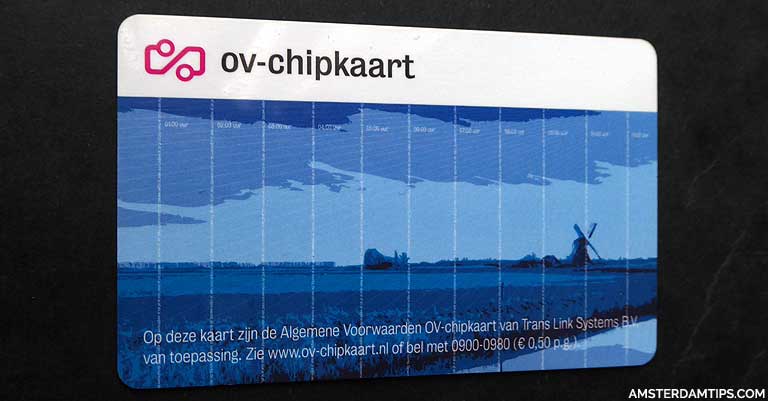
The OV-chipkaart (OV-chip card) is the public transport contactless ticket system in the Netherlands which replaced most of the old paper-style tickets.
The OV-chip card is in use on all forms of public transport including trains, trams, buses and metros.
Note, ‘OVpay’ – travel using contactless debit/credit cards/mobile – was introduced in 2023 onto public transport providers in the Netherlands. This has given visitors another payment option.
The current OV-chip card will be phased out by 2025. In 2024 the ‘OV-pas’ will be introduced – a public transport pass which will be available digitally via a phone or on a physical card.
The OV-chip card system is rather complex and we will do our best below to explain how the system works.
OV-chipkaart Summary
- There are 3 types of OV-chipkaart (OV-chip card).
- [1] Disposable OV-chip card , one-time use cards like singles or day tickets.
- [2] Anonymous OV-chip card , an unregistered card option for visitors who will travel around a lot.
- [3] Personal OV-chip card , a registered card for Dutch/Belgian/German residents only.
- Anonymous and personal cards (empty) cost a non-refundable €7.50 , last up to 5 years.
- Load and top-up credit on the card’s e-purse (max €150) for travel.
- Passengers must check-in and check-out of every journey using card readers.
- Minimum card balance of €4 (public transport) and €20 (train) – taken off as a deposit on check-in.
- Correct fare deducted on check-out, deposit is refunded.
- Every traveller aged 4 or higher must have their own ticket.
“OV” stands for Openbaar Vervoer which means “public transport” in Dutch. Like London’s Oyster and Hong Kong’s Octopus, the OV-chip smart card system works using an embedded RFID chip inside the card.
Passengers need to “check-in” and “check-out” respectively, at the start and end of their journey. This is done by placing the OV-chip card onto the special free-standing card readers – these are found either at station platforms/halls, gate barriers or near the doors on board trams and buses.
There are 3 types of OV-chipkaart available:
1. Disposable OV-chipcard (Eenmalige OV-chipkaart)
This is a card which is bought as a single travel product only. Examples for GVB (public transport in Amsterdam) include the standard 1 hour ticket and multi day tickets (1 day to 7 days). For train travel there is the NS Dutch Railways disposable ticket which carries a €1 surcharge over the standard fare.
Disposable OV-chip cards are made from paper card and can be discarded after use.
If you are on a short visit to Amsterdam it’s probably best to stick with disposable tickets. There are various ticket options aimed at tourists/visitors which can be purchased online in advance and can offer really good value if used well:
Which tickets do I need in Amsterdam? For a full analysis see public transport ticket types in Amsterdam
If you plan a longer stay in the Netherlands or come here on multiple visits then you may wish to purchase an anonymous OV-chipkaart.
2. Anonymous OV-chipcard (Anonieme OV-chipkaart)
This is a plastic card which has a printed expiry date valid for 4-5 years. It costs €7.50 (non-refundable) to purchase an ’empty’ card with no credit – to this you can load travel credit onto the e-purse up to a maximum of €150.
The anonymous OV-chipcard can be used on any public transport in the country as long as you have sufficient e-purse credit – though some cards may need to be pre-activated for rail travel (see below).
Travel using the e-purse on metro/trams/buses is generally cheaper than buying single 1 hour tickets, especially for shorter trips. Travel on trains with the anonymous card saves paying the €1 disposable ticket surcharge.
It’s also possible to load one-off travel products (such as 24 hour tickets, night bus tickets) onto the card which are then automatically used instead of the e-purse balance.
An anonymous card can be shared between different people but not at the same time – everyone travelling together on a journey must have their own ticket.
An anonymous OV-chip card can be purchased by anyone, with no registration required. The card could be useful for (1) frequent visitors to Amsterdam or the Netherlands and (2) anyone planning to travel a lot on Dutch public transport. One advantage is that you don’t have to worry about buying a new ticket every time you travel so long as you have sufficient credit.
Where to buy an anonymous OV-chip card? Cards can be purchased at any of the following locations:
• NS (Dutch Railways) stations – OV Service & Tickets shops/ticket desks or ticket machines • GVB (Amsterdam public transport) – Tickets & Info offices or ticket machines • Other transport providers – such as RET (Rotterdam), HTM (Den Haag), U-OV (Utrecht) • Newsagents – such as AKO, Bruna, Primera • Supermarket service desks – such as Albert Heijn, Dirk, Jumbo
Some outlets may sell cards already pre-loaded with credit.
At Amsterdam Schiphol airport you can purchase at the Tickets & Service desk, one of the yellow and blue ticket machines or at the AKO Newsagent.
At Amsterdam Central station you can purchase at the main service ticket desk, OV Service & Tickets office, ticket machines or the “GVB Tram Bus Metro” tickets & info office.
You will also find GVB Tickets & Info desks at Amsterdam Bijlmer-ArenA, Station Noord and Amsterdam Zuid stations. GVB has automatic ticket machines at all metro stations.
The anonymous card may be branded with the travel provider you purchased it from – however the card is valid as normal on all public transport companies.

How to load credit onto an anonymous OV-chip card? We recommend visitors immediately load some credit when buying their anonymous card at the NS or GVB ticket desk. To top-up the card either return to the desk, use a NS ticket machine (cards and coins only, no banknotes) or GVB ticket machine (cards, coins and banknotes).
Some sales outlets have small yellow machines which can be used to top-up credit – they only accept debit cards.
Once purchased and loaded with credit the anonymous card can be immediately used. Note, the anonymous card is not insured against any loss or theft.
You can view up the travel history of anonymous cards online at the ov-chipkaart.nl portal . Alternatively, you can see the last 10 transactions at ticket machines. You can do this by holding your card against the reader on the ticket machine.
For more on rail travel with the OV-chip card see How To Buy a Dutch Train Ticket
Refunding credit from an anonymous OV-chip card – Credit under €30 can be refunded with a €1 service fee at a transport company service desk. The procedure is a bit bureaucratic and you will have to fill in a form and show ID (so much for the name “anonymous” OV-chip card). Bear in mind that the initial €7.50 fee cannot be returned.
A credit refund can be requested online here – one requires a Dutch bank account to process such a refund.
3. Personal OV-chipcard (Persoonlijke OV-chipkaart)
This is a personalised OV-chip card available to anyone resident in the Netherlands who registers their details with the OV-chip card operating company (Trans Link Systems bv). Each personal card contains the holder’s name and a digital photograph. For security reasons, the holder’s date of birth is no longer printed on the card.
It costs €7.50 and lasts for 5 years.
Dutch residents can buy online at ov-chipkaart.nl and pay by iDeal, the domestic internet banking payment network. Expect the card to arrive within 6 working days.
As with the anonymous card, the e-purse of a personal card can be loaded with a maximum of €150 travel credit – standard transportation fares are exactly the same.
The so-called benefit of the personal card is that it can be linked to a Dutch bank account for automatic top-ups when the e-purse balance falls below a certain level, say €5.
Some travel companies (such as NS and GVB) have introduced various Flex products which allow travel using an OV-chip card without balance. You are invoiced monthly for your travel costs.
Personal card holders can register for the online “My OV-chipkaart” portal which shows all card use – this can be useful for employees claiming back travel expenses. Lastly, if you lose a personal card it can be blocked – you can then apply for a replacement card.
Only holders of personal OV-chip cards are entitled to travel with discount (if eligible) or travel on a monthly pass or season ticket. For example, resident children aged 4-11 and OAPs 65+ get a 34% reduction off the standard fare when using their personal cards. Students in further education can get a mixture of free or discounted travel.
This means most non-resident visitors are NOT entitled to discounted travel on Dutch public transport. Non-resident visitors 65+ need to pay standard fares on GVB public transport in Amsterdam.
Non-resident children aged 4-11 can travel on a GVB children’s day ticket (€4.50) in Amsterdam as long as they are accompanied by an adult with a valid ticket; they can also travel on the Dutch rail network all day with a RailRunner ticket (€2.50).
Can a non-resident purchase a personal OV-chip card? Yes, but only those who live or have an address in Belgium, Germany or Luxembourg. Initial payment for the card can be made by Paypal – however, automatic top-up is only possible via a Dutch bank account.
It should be noted that residents who do not wish to register their details should opt for the anonymous card or just use disposable tickets.
Using the OV-chip card on Public Transport (excluding Rail Travel)
To check-in hold the card once against the card reader. If check-in is successful a green light flashes accompanied by a single beeping sound.
A ticket inspector will require that you have a valid ticket – in this case a checked-in OV-chip card – so be careful not to miss checking-in and don’t check-out by accident!
If there is an error on check-in the card reader will beep 3 times.
When you check-in on public transport (buses, metro or trams) a deposit of €4 is taken off the e-purse balance – so you must always have at least €4 credit on the e-purse to check-in successfully. Some regional buses may take higher amounts (€8 or €12) if the journey is longer.
At the end of your journey hold the card against the reader again to check-out . If successful the card reader beeps twice and will show either the journey cost and the remaining e-purse balance or will display a check-out message if using a travel product. The cost of the journey will have been deducted but you get the €4 deposit back.
Note, if you fail or forget to check-out you will lose the €4 deposit which will likely be more expensive than the journey cost! You can rectify a failed check-out online here
If you have 12 failed check-outs in a 2 week period the card is disabled – it can only be restored by visiting a customer service desk.
The cost of a trip (using the card balance) has 2 components – a fixed boarding fee and a variable distance fee . The current boarding fee in the Netherlands for 2024 is €1.08. On top of this each transport company sets its own distance fare.
GVB in Amsterdam charges €0.196 per km travelled which during a journey is calculated every 50m. So this means e-purse journeys of 3km and 10km will cost about €1.67 and €3.04, respectively. Compare this with the GVB 1 hour disposable ticket which costs €3.40.
If you need to make a transfer you should generally check-out and then re-check-in. If this is done within 35 minutes, you will not be charged the €1.08 base fare again.
On the Amsterdam metro you can meet or say goodbye to someone on a station platform for free – as long as you check-in and check-out at that station in less than 20 minutes.
At all metro stations in Amsterdam there are additional blue card readers which only display the balance of your card. These are labelled “ Saldolezer ” (balance reader). They cannot be used to check-in and check-out – this must be done using the yellow card readers.
Once your card validity date expires you can no longer travel on it – you must invest in a new one. Also be wary about having other contactless cards close to each other in your purse or wallet.
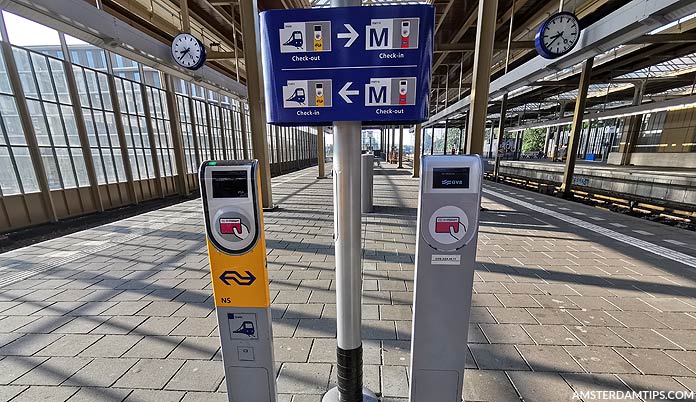
Using the OV-chip card on NS Dutch Railway Network
The OV-chip card is in use for train travel with NS. To use a personal or anonymous OV-chipkaart for NS train journeys the card must be activated for reizen op saldo zonder NS-abonnement (pre-paid travel without NS subscription) unless it was initially purchased from the NS. This activation procedure can be done at NS service desks or ticket machines.
Train travel requires a minimum check-in deposit of €20 (for standard personal and anonymous cards) or €10 (with one of the NS discount cards which are effectively personal OV-chip cards, again only available to residents). At check-out the standard single train fare for your trip is charged and the deposit is returned.
During the initial card activation, the default class of rail travel for the OV-chip card is set to 2nd class. At a ticket machine you can change the default to 1st class if you wish (this can be done permanently or temporarily for a single day’s travel). Remember that 1st class fares will be about 70% higher.
You can check-in up to 30 minutes before the scheduled departure of your train. You must complete check-out on the rail network within a maximum of 6 hours after check-in. Officially you are not allowed to backtrack, you must be travelling away from your check-in station unless it is an allowable route.
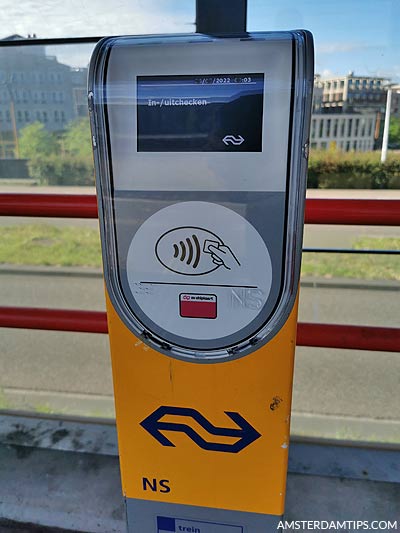
Check-in and -out at the same NS station – There may be occasions where after checking-in at a station you decide not to travel. In that case if you check-out within 1 hour you will not be charged. As a security measure you cannot check-out again within 100 seconds of checking-in. If you leave it longer than the hour you will lose the €20 deposit (unless you check-out at another station within the 6 hours).
Intercity Direct trains (Amsterdam-Schiphol-Rotterdam-Breda) require a small supplement for travel between Schiphol and Rotterdam. This costs €2.90 and can be paid by anonymous or personal OV-chip card e-purse balance by holding the card once against the special red supplement card readers. There is a discounted rate for using an OV-chip card during the off-peak hours (0900-1600 and 1830-0630).
Disposable OV-chip card tickets (singles and day returns) were introduced in 2014 replacing the old style paper tickets. Passengers are required to check-in and check-out of their journey to validate the ticket. These tickets carry a €1 surcharge in addition to the standard fare.
There are other smaller rail companies in the Netherlands which operate train services. These have their own card readers so you must always check-in and check-out of one company first before using another.

Most of the larger Dutch train stations have gate barriers installed. Smaller stations tend to have the self-standing card readers.
OV-chip card criticisms
The OV-chipkaart system has attracted a significant amount of criticism and privacy concerns over the years.
The obvious attraction to the transport companies and the authorities is the ability to log and analyse all public transport journeys down to the individual level. Even the holder of a so-called “anonymous” card could likely be tracked and identified by cross-referencing various data sources.
The OV-chip card was also brought in for revenue protection purposes. The transport companies wanted to reduce the ability of people to ride for free, something which was endemic on the Amsterdam metro. Some passengers still try to get round the system by checking out early (before their stop) or by using children’s day tickets.
However if you are caught without a valid ticket you face a standard fine of €50.
At €7.50, the OV-chip card has always been too expensive, particularly for short-term visitors. The whole transport ticket system has become overly complex with over 27 different ticket options in Amsterdam .
Another criticism of the system is that large groups travelling together (such as a teacher with students) must each buy separate cards and all check-in and check-out individually. Only since 2021 have some transport companies been offering a single group ticket for school children and teachers!
Additionally, by requiring all travellers to have sufficient pre-paid credit the transport companies are effectively getting an interest-free loan on any unused credit. There has been tens of millions of euros in unused credit going unclaimed by travellers with expiring cards.
Finally, people can easily make mistakes by not checking-in or out properly, thus losing the deposit or risking a fine.
OV-chip Card: The Future
The Dutch government is expected to phase out the OV-chip card by 2025.

In 2024 the replacement to the OV-chip card will be rolled out – the OV-pas (OV pass) which will have a digital version through a smartphone as well as a physical card version.
This article was originally published in 2010 and has been regularly updated. Last update 11 December 2023 .
Links on AmsterdamTips.com may pay us an affiliate commission.
Related Articles

OV Fiets – Dutch Bike Rental Scheme

Flixbus Coach Amsterdam to Germany, Europe

How to Get to Amsterdam Zuid

How to Get to Amsterdam Sloterdijk
Should You Use a Credit Card Travel Portal?
Unlock the details of credit card travel portals and learn how to maximize your benefits.
Using a Credit Card Travel Portal

Getty Images
Using a credit card portal to book travel could help you save money and help you earn more points or redeem travel credits.
Key Takeaways
- Credit card travel portals search across multiple travel options, giving you the power to compare prices.
- You can use your credit card or rewards to book travel with your credit card issuer's travel portal.
- Some cards may offer travel credits and benefits when you book using the associated travel portal.
You have many options for booking travel, whether you want to book directly with airlines and hotels, use an online travel agency or book with your credit card's travel portal. Using a credit card travel portal may allow you to take advantage of cardholder benefits and credits and give you additional choices for your booking.
Understand how to use credit card travel portals to save money on your next trip and maybe get some elevated perks along the way – but also recognize when it doesn't make sense.
What Are Credit Card Travel Portals?
Similar to online travel agencies, such as Expedia or Booking.com, credit card travel portals are online travel booking platforms. Cardholders can use credit card travel portals to browse and book travel options, including flights, hotels, rental cars and experiences using your credit card or rewards.
Credit card travel portals include:
- American Express Travel.
- Capital One Travel.
- Chase Travel.
- Citi Travel.
Some credit cards offer cardholder savings or perks when you book travel using the issuer's credit card portal, such as travel credits or cardholder privileges, including free breakfast or late checkout.
How Credit Card Travel Portals Stack Up
When you use a credit card travel portal, the amount and method of payment may be the deciding factors in how you book. Using a credit card travel portal to book travel can save you money, but not always.
We compared a midweek economy flight from Los Angeles to New York and a weeklong stay at a three-star hotel in Manhattan. In some cases, credit card travel portals were competitive, but Expedia had the lowest overall price for flight and hotel costs on this test trip.
Still, this is just one example, and travel prices can fluctuate depending on how you book. It's always a good idea to compare all of your options.
Benefits of Credit Card Travel Portals
Booking your travel with a credit card travel portal can help you earn more points or redeem travel credits. Some examples:
- Cardholders of the Capital One Venture X Rewards Credit Card get a $300 annual travel credit for bookings through the Capital One Travel site. When booking on the Capital One Travel site, cardholders earn unlimited 10 miles per dollar on hotels and rental cars and 5 miles per dollar on flights. ( See Rates and Fees )
- With The Platinum Card ® from American Express , cardholders get a $200 annual hotel credit for prepaid Fine Hotels + Resorts or The Hotel Collection bookings with American Express Travel and earn five points per dollar on flights and prepaid hotels booked with American Express Travel. ( See Rates and Fees )
- Chase Sapphire Preferred ® Card holders get a $50 annual Chase Travel hotel credit and earn five points per dollar on Chase Travel purchases.
"Using the travel credits is huge," says JT Genter, editor in chief of rewards and travel tracking tool AwardWallet. "Card issuers are leaning more towards those only being accessible through the portal."
Credit card travel portal bookings may help your points go further, too. "Because I have a Chase Sapphire Preferred Card, when I use the (Chase) portal to book travel, my points get an extra 25% bump," says Chip Chinery, personal finance blogger at Chip's Money Tips. For example, you'd only pay 100,000 points for a flight or hotel that would require 125,000 Chase Ultimate Rewards points to book without the points boost.
Helpful features can add up to savings on credit card travel portals. For example, Capital One Travel offers a price match guarantee. Genter used the Capital One Travel price match feature on a flight from Cairo to Marrakech, Morocco. Although he booked with Capital One Travel, an online travel agency had a better price. He was able to price match with Capital One Travel to get a travel credit.
Genter points out that cardholders of The Platinum Card from American Express can take advantage of the International Airline Program for potential savings on international flights in first, business or premium economy.
You may also get benefits for booking with credit card travel portals, particularly when booking hotels. For example:
- Cardholders of The Platinum Card from American Express get elite benefits at participating hotels, including early check-in, room upgrades, breakfast for two, a $100 experience credit, complimentary Wi-Fi and guaranteed 4 p.m. check-out.
- If you have a Chase Sapphire Reserve ® , you can book The Edit properties through Chase Travel and receive benefits, including daily breakfast for two, a $100 on-property credit, room upgrades, early check-in and late check-out and complimentary Wi-Fi.
Drawbacks of Credit Card Travel Portals
Travel credits and on-property perks are compelling reasons to use a credit card travel portal. However, it pays to compare pricing among your card's portal, direct booking or an online travel agency, because the lowest-priced option depends on the trip you're taking. Also, you may forfeit some benefits, as credit card travel portals are third-party bookings.
With a third-party booking, you'll have less flexibility in customer service and cancellation than you would if you booked directly. For example, if you're dealing with a delayed flight and need service from the airline, you may be directed to the travel portal customer service. You may have limited options for cancellation and how you get your money or rewards back.
Another major point to consider with third-party bookings: You generally won't be able to earn points or miles with the airline or hotel, though you can earn points with your card. Additionally, you may not be able to use elite benefits for any status you hold. For example, if you have Hilton Honors status that entitles you to a daily food and beverage credit, you're not likely to get it when you book a stay with your credit card travel portal.
When to Use a Credit Card Travel Portal
Booking travel with a credit card travel portal can make sense in some scenarios. For instance:
- You want to compare your travel options across multiple airlines or hotels in the portal.
- You have a travel credit available that can only be redeemed through the issuer's travel portal.
- You have rewards you want to redeem on the portal, and booking this way offers a good redemption value.
- You want to take advantage of benefits, such as elite hotel perks that you can get when using a credit card travel portal.
- Your booking options on the portal are priced lower compared with other options.
- Booking on the portal earns elevated rewards, and the prices and benefits are comparable to those of other booking options.
"It makes sense if you want to take advantage of the credits but also to earn bonus points," says Genter. "And sometimes, they have promotions such as hyper-targeted offers."
Tags: credit cards
Comparative assessments and other editorial opinions are those of U.S. News and have not been previously reviewed, approved or endorsed by any other entities, such as banks, credit card issuers or travel companies. The content on this page is accurate as of the posting date; however, some of our partner offers may have expired.

IMAGES
VIDEO
COMMENTS
In the U.S., you insert the chip and then sign the screen. In Europe, it works differently. You stick your card in the terminal and then enter your pin number to use the card - even with credit cards. That discrepancy was initially a big deal for travelers. Without a pin number tied to your credit card, many wouldn't work at card terminals ...
Probably not. It was good advice when the two different types of chip cards first came on the market. Payment terminals in parts of the world that adopted chip-and-PIN initially didn't recognize ...
Hawaiian Airlines® World Elite MasterCard®. (Photo by The Points Guy) This card, best for those who fly Hawaii's official airline regularly, is also a Barclays card and has the same PIN feature as the issuer's other cards. Welcome bonus: 50,000 bonus miles after you spend $2,000 on purchases in the first 90 days.
Best travel rewards credit cards. Show The List [+] Points and perks for dining out: American Express® Gold Card. Unlimited rewards: Capital One Venture Rewards Credit Card. Travel card with no ...
A true chip-and-PIN credit card is a type of credit card that requires the user to enter a chosen PIN in order for a transaction to be completed. Chip-and-PIN credit cards also have a square-shaped microchip that generates and stores information as transactions are made throughout the month. This makes them different from older credit cards ...
Chase has some much-loved travel cards that would be even better with PINs, like the Chase Sapphire Preferred® Card and Chase Sapphire Reserve®, along with quite a few airline and hotel co-branded cards. ... Every EMV chip credit card issued in the U.S. has the chip-and-signature verification method, but only cards from certain issuers also ...
21.49% - 28.49% variable. $199. Good/Excellent. The World of Hyatt Business Credit Card is a chip and PIN card that's an excellent fit for business travelers who prefer the Hyatt hotel line. This Chase Bank co-branded card offers a generous signup bonus to go with its moderately high annual fee.
Stay secure with an EMV chip credit card. Compare cards that include the latest Chip & Signature technology; a must for international travelers. ... Plus, for a limited time, earn 5% total cash back on hotel, car rentals and attractions booked on the Citi Travel℠ portal through 12/31/24.
Most chip cards require a signature, but some ask for a PIN. Both offer greater fraud protection than swipe cards. ... Additional benefits you can enjoy with this travel credit card include up to ...
Step 1. Insert your card into the reader - chip side up and chip end in - and leave it there until your transaction is complete. Step 2. When prompted, confirm your purchase amount. Step 3. In most cases, you'll then be prompted to sign for your transaction. But at self-service terminals like ticket kiosks and some gas pumps, you may need ...
How to Use Credit Cards for European Travel. Consider using a card that has chip and PIN capability and that doesn't charge foreign transaction fees. Know the potential rewards and foreign ...
Best flexibility: Chase Sapphire Preferred® Card - $750 Award Travel Bonus. At least 2x Rewards on Everything: Capital One Venture Rewards Credit Card. The biggest Travel Perks: Chase Sapphire Reserve® - Lounge access, $300 annual travel credit. Best Premium International Card: The Platinum Card® from American Express.
INTRO OFFER: Earn an additional 1.5% cash back on everything you buy (on up to $20,000 spent in the first year) - worth up to $300 cash back!; Enjoy 6.5% cash back on travel purchased through Chase Travel, our premier rewards program that lets you redeem rewards for cash back, travel, gift cards and more; 4.5% cash back on drugstore purchases and dining at restaurants, including takeout and ...
The Bank of America® Travel Rewards credit card offers unlimited 1.5 points per $1 spent on all purchases everywhere, every time and no expiration on points. Apply online. ... Contactless Chip Technology Simply tap to pay where you see the Contactless Symbol. You can make purchases quickly, easily and securely at millions of locations.
When Europeans buy something with plastic, they insert their card, then type in their PIN. By Rick Steves. Despite some differences between European and US cards, there's little to worry about. US-issued Visa and Mastercard credit cards, along with familiar payment apps, typically work fine in Europe.
4 chip-and-PIN cards you can get in the U.S. If you want to make sure you're able to use your card in countries where chip-and-PIN technology is the norm, here are five cards you can get in the U.S. with chip-and-PIN functionality. The Platinum Card® from American Express. AAdvantage® Aviator® Red World Elite Mastercard®.
However, if you live in the U.S., chances are good that you have a chip-and-signature credit card. This means your card carries its information on a microchip, but you still need to sign a paper ...
Choose AT&T Prepaid's 5GB plan for $30 per month and you'll get unlimited talk, text, and 5GB of data with 5G access and the ability to text over 230 countries for free. Read more below. Best ...
Prepaid Travel Card by Mastercard | Reloadable Travel Cards. MASTERCARD BENEFIT INQUIRIES. Within the U.S.: 1-800-Mastercard (1-800-627-8372) | Outside the U.S.: Mastercard Global Service Phone Numbers. Availability of insurance benefits on your card may vary by card issuer. Please refer to your issuing financial institution for complete ...
These cards use EMV chip technology (chip security developed for Europay, Mastercard and Visa but now used by many cards) with NFC (near-field communication) for proximity payments. Cards with contactless capabilities can be used like a standard chip credit card or for "tap-and-go" payments similar to Apple Pay and Google Pay purchases.
OneSimCard Universal ($29.95) - Coverage of over 200 countries but with a more limited data service (50+) countries. OneSimCard Expedition ($34.95) - Offers much the same coverage as the OneSim Universal travel SIM but with way more data coverage. It's the choice for the explorers.
Jerod Morales is a deputy editor at Forbes Advisor and a travel rewards expert. He took a deep dive into points and miles in 2016, searching for a way to make travel both possible and affordable ...
The Chase Sapphire Preferred ® Card is an example of a popular travel card that earns flexible points. This card comes with more than a dozen transfer partners and points transfer at a 1:1 rate ...
The OV-chip card is in use on all forms of public transport including trains, trams, buses and metros. Note, 'OVpay' - travel using contactless debit/credit cards/mobile - was introduced in 2023 onto public transport providers in the Netherlands. This has given visitors another payment option. The current OV-chip card will be phased out ...
Unlock the details of credit card travel portals and learn how to maximize your benefits. ... personal finance blogger at Chip's Money Tips. For example, you'd only pay 100,000 points for a flight ...